Paul van Yperen's Blog, page 219
October 13, 2019
Karel Gott (1939-2019)
On 1 October 2019, Schlager singer and actor Karel Gott (1939-2019) passed away. He was the most successful male singer of the Czech Republic, and also had many successes in the German-speaking countries. He released more than 125 albums during his career, selling over 30 million records worldwide. In the annual national poll Český slavík, ‘the Sinatra of the East’ was thirty-eight times elected as the Most Favourite Male Singer.
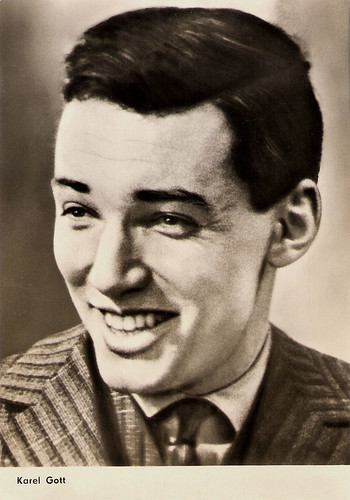
East-German postcard by Progress Starfoto, no. 2376, 1965. Karel Gott in Kdyby tisíc klarinetu/If a Thousand Clarinets (Ján Rohác, Vladimír Svitácek, 1965).
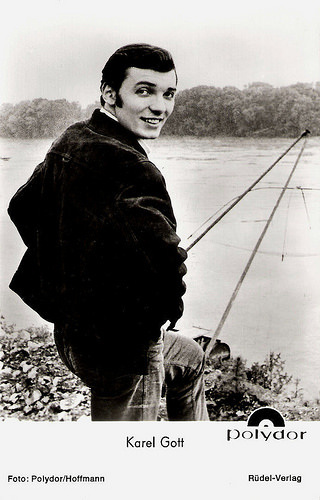
German postcard by Franz Josef Rüdel, Filmpostkartenverlag, Hamburg, no. 4909. Photo: Polydor / Hoffmann.
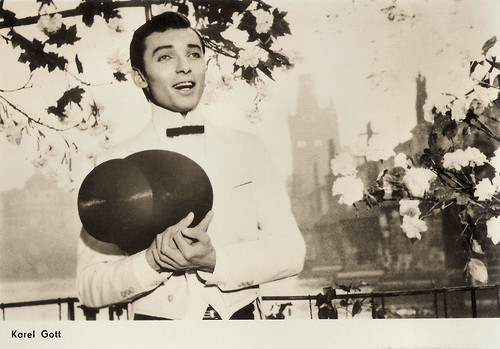
East-German postcard by VEB Progress Film-Vertrieb, Berlin, no. 3094, 1968. Karel Gott in Ta nase písnicka ceská/The Czech song (Zdenek Podskalský, 1967).
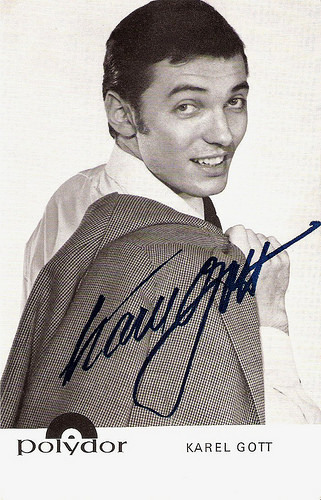
German promotion card by Polydor.
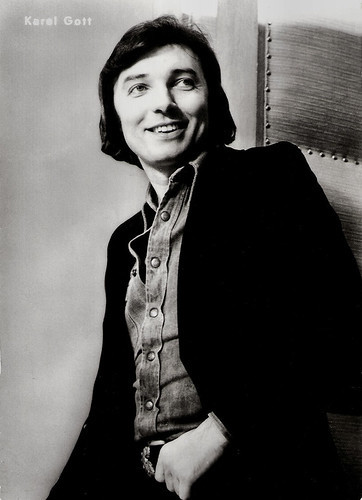
East-German postcard by Progress Film-Verleih, Berlin, no. 113/77, 1977. Photo: Mirvald.
Eyes Covered by Snow
Karel Gott was born in 1939 in Pilsen, at that time Protectorate of Bohemia and Moravia, now Plzeň, Czech Republic, and has lived in Prague since age 6. He initially wanted to study art, but failed the exams at the School of Industrial Art, upon which he began training as an electrician.
On completing his studies, he began working as an electrician, but was soon fascinated by the new types of music flooding the city, and became interested in jazz. He experimented with playing the bass and the guitar, but eventually decided to focus on singing, studying it privately.
In 1958, he participated in the amateur singing contest Looking for New Talent in the Prague Slavonic House. He utterly failed to impress the judges, but soon made a name for himself in Prague jazz circles, finally getting his first engagement at the Vltava Prague Cafe that same year.
In 1960, he decided to undertake singing professionally. He studied opera at the Prague Conservatory under Konstantin Karenin, a student of the brilliant Russian bass Feodor Chaliapin. Knowing of Gott's interest in current musical trends, Karenin instructed him not only in classical Italian pieces, but also in the hits of the day. It was at this time that Gott travelled abroad (to Poland) for the first time with the Jazz Orchestra of the Czechoslovak Broadcast, conducted by Karel Krautgartner.
In 1962 or 1963 (the sources differ), Gott released his first single, Až nám bude dvakrát tolik (When we are twice as old), a duet with jazz singer Vlasta Průchová. Gott was voted into the Zlatý slavík (Golden Nightingale) viewer's survey, placing 49th and receiving a total of three votes.
His first solo single, Mesicni reka, the Czech version of Moon River became his breakthrough hit in 1962. In 1963 Gott was offered a place at the recently founded Prague Semafor theatre, which was then at the forefront of the emerging Czechoslovakian pop music scene. He released Oči sněhem zaváté (Eyes Covered by Snow), which became the year's best-selling record. Shortly afterwards, Gott received the first of his Zlatý slavík awards, given to the most popular artist of the year.
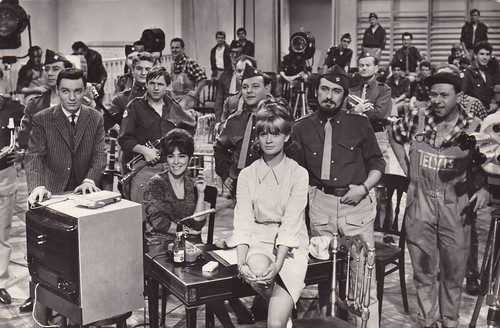
Czech postcard by Pressfoto, Praha (Prague). Photo: Karel Gott and Jana Brejchova in Kdyby tisic klarinetu/If a Thousand Clarinets (Ján Rohác, Vladimír Svitácek, 1965). Collection: Carla Bosch.
Carla: I suspect that on these two cards are the film crew making the documentary. With Jana Brejchova , Waldemar Matuska, Hana Hegerova, Eva Pilarova, Karel Gott, Jiri Suchy, and Jiri Slitr. They are all watching a television. In the public are soldiers who are holding music instruments.
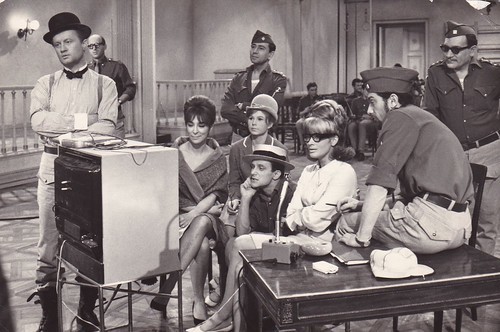
Czech postcard by Pressfoto, Praha (Prague). Photo: publicity still for Kdyby tisic klarinetu/If a Thousand Clarinets (Ján Rohác, Vladimír Svitácek, 1965). Collection: Carla Bosch.
Carla: Kdyby tisic klarinetu/If a Thousand Clarinets (Ján Rohác, Vladimír Svitácek, 1965) is a fantasy musical film about a mysterious statue of the composer Johann Sebastian Bach that changes guns into musical instruments. The news spreads and a television station decides to make a documentary film about the subject. My guess is that it must be something like how music can change people. And, more particular, how soldiers change when they are not holding guns, but music instruments instead... But that is just a wild guess.
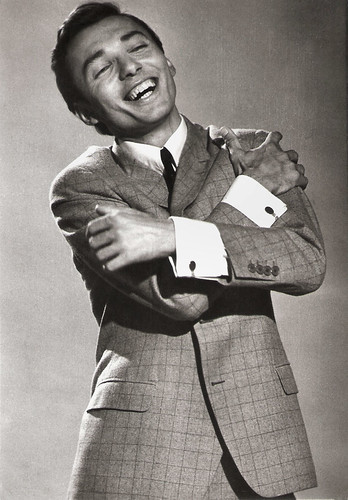
Czech postcard by Nakladatelstvi Pressfoto, Praha, no. C 11148. Photo: Vileru Rosegnal.
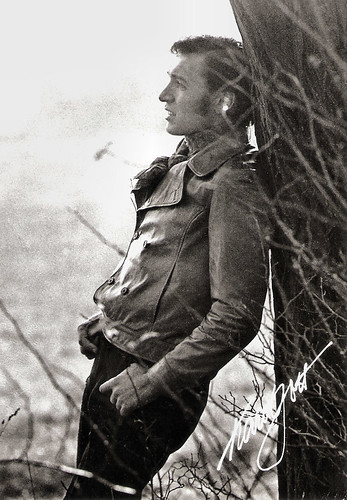
Czech postcard by Nakladatelstvi Pressfoto, Praha, no. C 23365-3. Photo: Jaromir Svoboda.
Maya the Honey Bee
In 1965, Karel Gott was a major star, appearing in the programs Pilgrimage for Two and Evening Prayer while building his own repertoire with his own orchestra. That year, he made his first film appearance in the musical Kdyby tisíc klarinetu/If a Thousand Clarinets (Ján Rohác, Vladimír Svitácek, 1965) with Jana Brejchová .
He also established the Apollo theatre, along with two brothers who were with him in Semafor: Jiří and Ladislav Štaidl. He began composing his own songs, and toured Czechoslovakia and abroad with the Apollo theatre.
His first album, Karel Gott Sings got great acclaim. This first album was followed by an English export album titled The Golden Voice of Prague. In 1967, Gott performed at MIDEM, the International Fair of Record Companies and Music Producers in Cannes, France, where the applause was measured during every concert. He surprised everyone by achieving a level of 54 to Tom Jones ' 58.
Following this event, Gott signed a contract with the Polydor / Deutsche Grammophon Gesellschaft record company, renewing it several times until it became a life contract in 1997. Between 1967 and 2000, Polydor released over 125 albums and 72 singles for Karel Gott in German speaking countries in Europe.
Films in which he appeared were Mucedníci lásky/Martyrs of Love (Jan Nemec, 1967) with British director Lindsay Anderson, and the German comedy Charley's Onkel/Charley’s Uncle (Werner Jacobs, 1969) featuring Gustav Knuth.
Gott represented Austria in the Eurovision Song Contest 1968 with the song Tausend Fenster, written by Udo Jürgens . He finished in 13th place. In the same year, Gott spent six months performing daily at the New Frontier Hotel and Casino in Las Vegas.
In the 1970s, domestic success was marked by Gott's presence on television, including the filming of a ten-part serial entitled Karel Gott in Slany. In 1971, after deciding not to return from a concert tour in West Germany to his home country, he was addressed a personal letter from the Czechoslovak party leader Gustav Husak persuading him to change his mind.
One of his most best-known pop hits was the title music to the Japanese anime series Maya the Honey Bee (1975). The original theme was composed by Karel Svoboda and sung by Karel Gott in the German, Czech and Slovak versions. In 1975 he also played the lead in the film musical Hvezda pada vzhuru/A Star Is Falling Upwards (Ladislav Rychman, 1975).
Karel Gott recorded a cover version of the song All by Myself called Kam tenkrát šel můj bratr Jan (Where Did My Brother Jan Go This Time). The song was dedicated to Jan Palach who set himself on fire and burned to death as a protest against Soviet occupation of Czechoslovakia in January 1969. According to Wikipedia , the song was recorded in 1977 while Soviet troops were still present in the country. In order to continue in his career, he had to sign in 1977 the so-called ‘Anti-charter’, a petition organised by the Communist government against the Charter 77 signed by Václav Havel and other dissidents, protesting the government's violations of the Helsinki Accords.
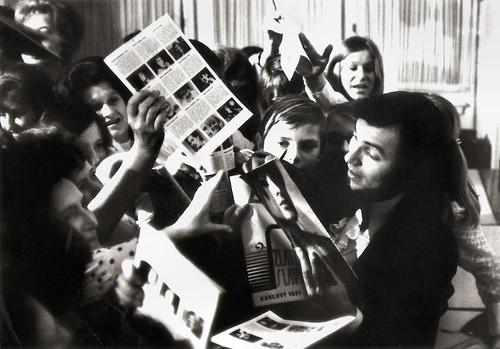
Czech postcard by Nakladatelstvi Pressfoto, Praha, no. 53/3. Photo: Alexandr Janovsky.
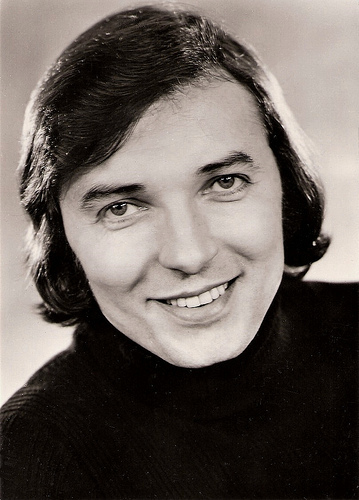
East-German postcard by Bild und Heimat, Reichenbach, no. G 6776, 1976. Photo: Leher, Berlin.
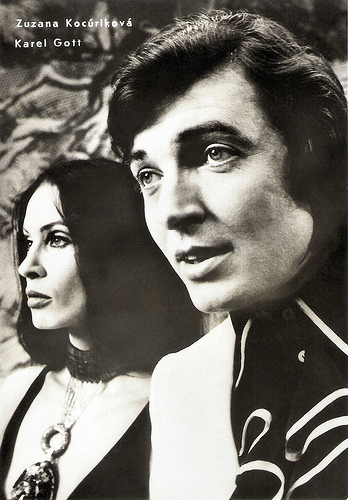
East-German postcard by Progress, Berlin, no. 33/76, 1976. Photo: publicity still for Hvezda pada vzhuru/A Star Is Falling Upwards (Ladislav Rychman, 1975) with Zuzana Kocúrlková.
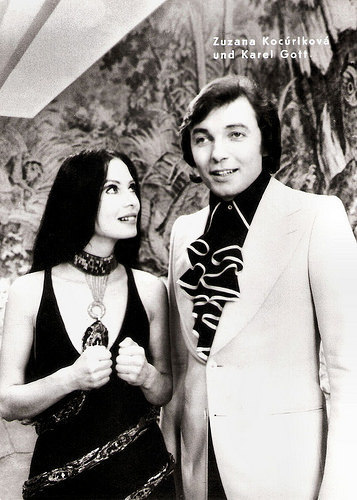
East-German postcard by Progress, Berlin, no. 41/76, 1976. Photo: publicity still for Hvezda pada vzhuru/A Star Is Falling Upwards (Ladislav Rychman, 1975) with Zuzana Kocúrlková.
His second great love
The 1980s were marked for Karel Gott by international success, including the filming in Italy of the musical In the Track of Bel Canto (1981), with a corresponding German-Italian album and duet performance with Sofia Rotaru in the Soviet Union. The following years, Gott received many awards, including The Supraphon Diamond Record Award, given him in 1992, for having sold 13 million records.
In 1990, he decided to end his career and arranged a huge farewell tour. However, the tour was so successful that he re-evaluated his decision. The 1990s were influenced by fundamental changes in the political system of the country, which were reflected in popular music, but it did not threaten his permanent position in the limelight of the domestic music scene. In 1991 a new television survey was created called TýTý. Karel Gott gained the first victory and at the same time became the outright winner of the survey.
In 1993, he established his own artistic agency, GOJA, with František Janeček. It is this agency that lately producedGott's records and organisedhis artistic activities. In 1996, following renewed public interest in his career, Gott again won 'The Golden Nightingale Award' with a huge lead over his rivals, and retained the accolade many times since.
Gott remained popular in a number of countries, including those of the former Soviet Union, where his first record, produced by Melodiya in 1977, sold a staggering 4.5 million copies. In 2000, he had his first concert in Carnegie Hall, New York.
During the 1990s, Gott began to focus increasingly on painting, his second great love. The first exhibition of his paintings took place in 1992, at the Prague Christ Child Gallery. He also exhibited his work successfully in Berlin, Moscow, Munich, Cologne, Vienna, and Bratislava.
In 2001, he played the double role of Lucifer and God in the family comedy Z pekla stestí 2/Goblins and Good Luck 2 (Zdenek Troska, 2001). He also acted regularly in TV series.
Gott had two adult daughters, Dominika and Lucie, from former relationships (they have different mothers). He was also the father to Charlotte Ella with Ivana Macháčková whom he married in 2008 in Las Vegas, the city where he started his international career. Their second daughter, Nelly Sofie, was born in summer 2008. Karel Gott passed away in Prague, Czech Republic, at the age of 80.
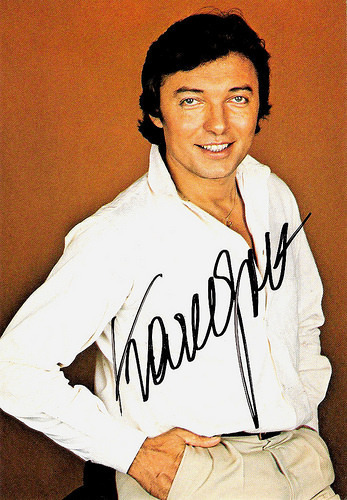
German promotion card by Polydor, no. 49.
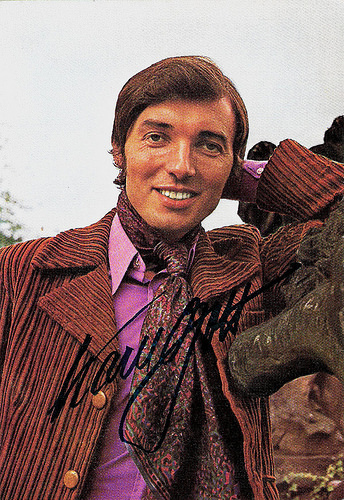
German promotion card by Polydor.
Compilation of early TV performances by Karel Gott. Source: Hit That Button (YouTube).
Karel Gott sings Kam tenkrát šel můj bratr Jan. Source: Benetomm (YouTube).
Sources: Jan Adam (KarelGott.com), Zuzana Drotárová (Gott.cz), Steve Leggett (AllMusic), Wikipedia (German and English) and .

East-German postcard by Progress Starfoto, no. 2376, 1965. Karel Gott in Kdyby tisíc klarinetu/If a Thousand Clarinets (Ján Rohác, Vladimír Svitácek, 1965).

German postcard by Franz Josef Rüdel, Filmpostkartenverlag, Hamburg, no. 4909. Photo: Polydor / Hoffmann.

East-German postcard by VEB Progress Film-Vertrieb, Berlin, no. 3094, 1968. Karel Gott in Ta nase písnicka ceská/The Czech song (Zdenek Podskalský, 1967).

German promotion card by Polydor.

East-German postcard by Progress Film-Verleih, Berlin, no. 113/77, 1977. Photo: Mirvald.
Eyes Covered by Snow
Karel Gott was born in 1939 in Pilsen, at that time Protectorate of Bohemia and Moravia, now Plzeň, Czech Republic, and has lived in Prague since age 6. He initially wanted to study art, but failed the exams at the School of Industrial Art, upon which he began training as an electrician.
On completing his studies, he began working as an electrician, but was soon fascinated by the new types of music flooding the city, and became interested in jazz. He experimented with playing the bass and the guitar, but eventually decided to focus on singing, studying it privately.
In 1958, he participated in the amateur singing contest Looking for New Talent in the Prague Slavonic House. He utterly failed to impress the judges, but soon made a name for himself in Prague jazz circles, finally getting his first engagement at the Vltava Prague Cafe that same year.
In 1960, he decided to undertake singing professionally. He studied opera at the Prague Conservatory under Konstantin Karenin, a student of the brilliant Russian bass Feodor Chaliapin. Knowing of Gott's interest in current musical trends, Karenin instructed him not only in classical Italian pieces, but also in the hits of the day. It was at this time that Gott travelled abroad (to Poland) for the first time with the Jazz Orchestra of the Czechoslovak Broadcast, conducted by Karel Krautgartner.
In 1962 or 1963 (the sources differ), Gott released his first single, Až nám bude dvakrát tolik (When we are twice as old), a duet with jazz singer Vlasta Průchová. Gott was voted into the Zlatý slavík (Golden Nightingale) viewer's survey, placing 49th and receiving a total of three votes.
His first solo single, Mesicni reka, the Czech version of Moon River became his breakthrough hit in 1962. In 1963 Gott was offered a place at the recently founded Prague Semafor theatre, which was then at the forefront of the emerging Czechoslovakian pop music scene. He released Oči sněhem zaváté (Eyes Covered by Snow), which became the year's best-selling record. Shortly afterwards, Gott received the first of his Zlatý slavík awards, given to the most popular artist of the year.

Czech postcard by Pressfoto, Praha (Prague). Photo: Karel Gott and Jana Brejchova in Kdyby tisic klarinetu/If a Thousand Clarinets (Ján Rohác, Vladimír Svitácek, 1965). Collection: Carla Bosch.
Carla: I suspect that on these two cards are the film crew making the documentary. With Jana Brejchova , Waldemar Matuska, Hana Hegerova, Eva Pilarova, Karel Gott, Jiri Suchy, and Jiri Slitr. They are all watching a television. In the public are soldiers who are holding music instruments.

Czech postcard by Pressfoto, Praha (Prague). Photo: publicity still for Kdyby tisic klarinetu/If a Thousand Clarinets (Ján Rohác, Vladimír Svitácek, 1965). Collection: Carla Bosch.
Carla: Kdyby tisic klarinetu/If a Thousand Clarinets (Ján Rohác, Vladimír Svitácek, 1965) is a fantasy musical film about a mysterious statue of the composer Johann Sebastian Bach that changes guns into musical instruments. The news spreads and a television station decides to make a documentary film about the subject. My guess is that it must be something like how music can change people. And, more particular, how soldiers change when they are not holding guns, but music instruments instead... But that is just a wild guess.

Czech postcard by Nakladatelstvi Pressfoto, Praha, no. C 11148. Photo: Vileru Rosegnal.

Czech postcard by Nakladatelstvi Pressfoto, Praha, no. C 23365-3. Photo: Jaromir Svoboda.
Maya the Honey Bee
In 1965, Karel Gott was a major star, appearing in the programs Pilgrimage for Two and Evening Prayer while building his own repertoire with his own orchestra. That year, he made his first film appearance in the musical Kdyby tisíc klarinetu/If a Thousand Clarinets (Ján Rohác, Vladimír Svitácek, 1965) with Jana Brejchová .
He also established the Apollo theatre, along with two brothers who were with him in Semafor: Jiří and Ladislav Štaidl. He began composing his own songs, and toured Czechoslovakia and abroad with the Apollo theatre.
His first album, Karel Gott Sings got great acclaim. This first album was followed by an English export album titled The Golden Voice of Prague. In 1967, Gott performed at MIDEM, the International Fair of Record Companies and Music Producers in Cannes, France, where the applause was measured during every concert. He surprised everyone by achieving a level of 54 to Tom Jones ' 58.
Following this event, Gott signed a contract with the Polydor / Deutsche Grammophon Gesellschaft record company, renewing it several times until it became a life contract in 1997. Between 1967 and 2000, Polydor released over 125 albums and 72 singles for Karel Gott in German speaking countries in Europe.
Films in which he appeared were Mucedníci lásky/Martyrs of Love (Jan Nemec, 1967) with British director Lindsay Anderson, and the German comedy Charley's Onkel/Charley’s Uncle (Werner Jacobs, 1969) featuring Gustav Knuth.
Gott represented Austria in the Eurovision Song Contest 1968 with the song Tausend Fenster, written by Udo Jürgens . He finished in 13th place. In the same year, Gott spent six months performing daily at the New Frontier Hotel and Casino in Las Vegas.
In the 1970s, domestic success was marked by Gott's presence on television, including the filming of a ten-part serial entitled Karel Gott in Slany. In 1971, after deciding not to return from a concert tour in West Germany to his home country, he was addressed a personal letter from the Czechoslovak party leader Gustav Husak persuading him to change his mind.
One of his most best-known pop hits was the title music to the Japanese anime series Maya the Honey Bee (1975). The original theme was composed by Karel Svoboda and sung by Karel Gott in the German, Czech and Slovak versions. In 1975 he also played the lead in the film musical Hvezda pada vzhuru/A Star Is Falling Upwards (Ladislav Rychman, 1975).
Karel Gott recorded a cover version of the song All by Myself called Kam tenkrát šel můj bratr Jan (Where Did My Brother Jan Go This Time). The song was dedicated to Jan Palach who set himself on fire and burned to death as a protest against Soviet occupation of Czechoslovakia in January 1969. According to Wikipedia , the song was recorded in 1977 while Soviet troops were still present in the country. In order to continue in his career, he had to sign in 1977 the so-called ‘Anti-charter’, a petition organised by the Communist government against the Charter 77 signed by Václav Havel and other dissidents, protesting the government's violations of the Helsinki Accords.

Czech postcard by Nakladatelstvi Pressfoto, Praha, no. 53/3. Photo: Alexandr Janovsky.

East-German postcard by Bild und Heimat, Reichenbach, no. G 6776, 1976. Photo: Leher, Berlin.

East-German postcard by Progress, Berlin, no. 33/76, 1976. Photo: publicity still for Hvezda pada vzhuru/A Star Is Falling Upwards (Ladislav Rychman, 1975) with Zuzana Kocúrlková.

East-German postcard by Progress, Berlin, no. 41/76, 1976. Photo: publicity still for Hvezda pada vzhuru/A Star Is Falling Upwards (Ladislav Rychman, 1975) with Zuzana Kocúrlková.
His second great love
The 1980s were marked for Karel Gott by international success, including the filming in Italy of the musical In the Track of Bel Canto (1981), with a corresponding German-Italian album and duet performance with Sofia Rotaru in the Soviet Union. The following years, Gott received many awards, including The Supraphon Diamond Record Award, given him in 1992, for having sold 13 million records.
In 1990, he decided to end his career and arranged a huge farewell tour. However, the tour was so successful that he re-evaluated his decision. The 1990s were influenced by fundamental changes in the political system of the country, which were reflected in popular music, but it did not threaten his permanent position in the limelight of the domestic music scene. In 1991 a new television survey was created called TýTý. Karel Gott gained the first victory and at the same time became the outright winner of the survey.
In 1993, he established his own artistic agency, GOJA, with František Janeček. It is this agency that lately producedGott's records and organisedhis artistic activities. In 1996, following renewed public interest in his career, Gott again won 'The Golden Nightingale Award' with a huge lead over his rivals, and retained the accolade many times since.
Gott remained popular in a number of countries, including those of the former Soviet Union, where his first record, produced by Melodiya in 1977, sold a staggering 4.5 million copies. In 2000, he had his first concert in Carnegie Hall, New York.
During the 1990s, Gott began to focus increasingly on painting, his second great love. The first exhibition of his paintings took place in 1992, at the Prague Christ Child Gallery. He also exhibited his work successfully in Berlin, Moscow, Munich, Cologne, Vienna, and Bratislava.
In 2001, he played the double role of Lucifer and God in the family comedy Z pekla stestí 2/Goblins and Good Luck 2 (Zdenek Troska, 2001). He also acted regularly in TV series.
Gott had two adult daughters, Dominika and Lucie, from former relationships (they have different mothers). He was also the father to Charlotte Ella with Ivana Macháčková whom he married in 2008 in Las Vegas, the city where he started his international career. Their second daughter, Nelly Sofie, was born in summer 2008. Karel Gott passed away in Prague, Czech Republic, at the age of 80.

German promotion card by Polydor, no. 49.

German promotion card by Polydor.
Compilation of early TV performances by Karel Gott. Source: Hit That Button (YouTube).
Karel Gott sings Kam tenkrát šel můj bratr Jan. Source: Benetomm (YouTube).
Sources: Jan Adam (KarelGott.com), Zuzana Drotárová (Gott.cz), Steve Leggett (AllMusic), Wikipedia (German and English) and .
Published on October 13, 2019 22:00
October 12, 2019
Diahann Carroll (1935-2019)
On 4 October 2019, Diahann Carroll died of cancer, aged 84. She was among the foremost African American actors to break down long-seated prejudices in casting. Carroll was the first black performer to have her own sitcom, Julia, which ran for 86 episodes (1968-1971), and the first to win an Emmy in the category of best actress in a leading role in a comedy series. She also won a Tony for her performance in the Broadway musical 'No Strings', written especially for her by Richard Rodgers, which highlighted an interracial romance without mentioning colour. Her films include Carmen Jones (1954), Porgy and Bess (1959), Paris Blues (1961) and Claudine (1974). And her conniving and glamorous Dominique Deveraux was a match for Joan Collins’ Alexis Colby, doubling the 'nasty in Dynasty (1984-1997).
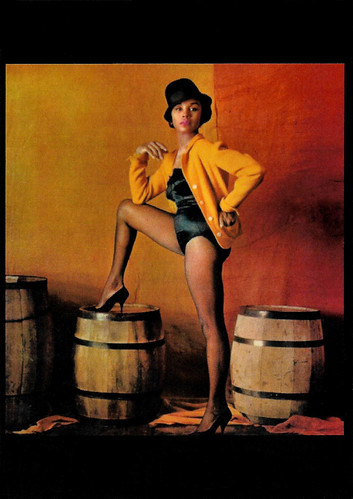
Vintage postcard, no. 018. Photo: Milton H. Greene.
A bold, interracial love story
Carol Diann Johnson was born in the Bronx, New York, in 1935. She was the first child of John Johnson, a subway conductor, and his wife, Mabel (nee Faulk). When their daughter was an infant the family moved to Harlem, where she grew up.
Music was an important part of her life as a child, singing at age 6 with her Harlem church choir. A few years later the 10-year-old became a recipient of a Metropolitan Opera scholarship for studies at the New York High School of Music and Art. After graduating she attended New York University, majoring in sociology.
At the same time, she did modelling for Ebony magazine. When she was 16, she teamed up with a girlfriend from school and auditioned for Arthur Godfrey's Talent Scouts show using the more exotic sounding name of Diahann Carroll. This led to her performing on radio and television and in nightclubs while still in her teens.
Her big break came in 1954 when Truman Capote chose her for a leading part in the Broadway musical 'House of Flowers', based on his short story and for which he wrote the book and lyrics. Carroll, who played a young sex worker in a Caribbean island bordello, had the best numbers, 'A Sleepin’ Bee' and 'I Never Has Seen Snow'.
In the same year Carroll made her film debut in Otto Preminger’s Carmen Jones (1954), an all-black, updated movie version of the Georges Bizet opera 'Carmen'. She played a friend of Dorothy Dandridge in the title role, performing in the quintet Whizzin’ Away Along De Track. Carroll was dubbed by Bernice Peterson because her own voice was not considered operatic enough, and she was dubbed again (this time by Loulie Jean Norman) as Clara, the young mother 'singing' the renowned lullaby 'Summertime' in Porgy and Bess (Otto Preminger, 1959), Preminger’s big-screen adaptation of George Gershwin’s opera.
Martin Ritt’s Paris Blues (1961) presented Carroll with her first co-starring role, as an American tourist in Paris who, with her friend (Joanne Woodward) meets two fellow American jazz players (Sidney Poitier and Paul Newman). She falls for one of them, but fails to persuade him to return with her to the 'racist' US. At the same time, Poitier and Carroll were having an affair in real life.
Diahann returned to Broadway. She was rewarded with a Tony Award for her exceptional performance as a fashion model in the 1962 musical 'No Strings,' a bold, interracial love story that co-starred Richard Kiley. Richard Rodgers, whose first musical this was after the death of partner Oscar Hammerstein, wrote the part specifically for Diahann, which included her rendition of the song standard 'The Sweetest Sounds.'
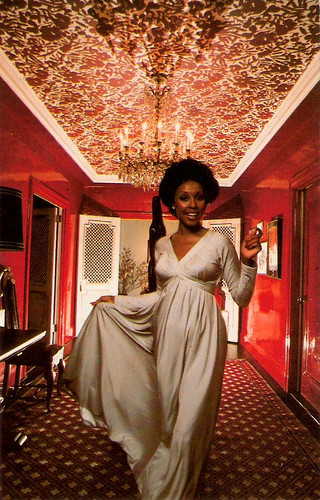
American postcard by Coral-Lee, Rancho Cordova, CA, no. 20. Photo: Douglas Kirkland, 1978. Caption: Diahann Carol (sic) - Star popsinger, was born in New York in 1935. Her career has spanned a multitude of super-successful night club, screen and TV engagements.
The first black bitch on television
On screen, Diahann Carroll appeared again for Preminger, in Hurry Sundown (Otto Preminger, 1967), set in rural 1940s Georgia. She played an elegant local schoolteacher who had gone north and been corrupted. Despite a terrible script, Carroll came off slightly better than her co-stars, Michael Caine and Jane Fonda , in this condescending melodrama on race relations.
After a conventional heist film, The Split (Gordon Flemyng, 1968), in which Carroll was the wife of a robber (Jim Brown), came Claudine (John Berry, 1974), a romantic comedy and one of the few mainstream films starring black actors in the 1970s that was not described as 'blaxploitation'. She played a Harlem widow on welfare raising six children on her own, who is courted by a garbage collector played by James Earl Jones. Surprisingly, after being Oscar-nominated as best actress for Claudine, Carroll did not return to feature films for 16 years.
The reason was her rewarding work on television. In the popular sitcom Julia (1968), she touchingly portrayed an ordinary nurse and widow struggling to raise a small son. Diahann became the first full-fledged African-American female 'star' - top billed, in which the show centered around her lead character. The show gradually rose in ratings and Carroll won a Golden Globe award for 'Best Newcomer' and an Emmy nomination.
There followed many guest appearances in TV series and the role of Maya Angelou’s selfish mother in an adaptation of the acclaimed autobiography I Know Why the Caged Bird Sings (Fielder Cook, 1979).
However, it was her role as the sleek Dominique Deveraux, which Carroll claimed made her 'the first black bitch on television' in the glossy Dynasty (1984-1987) and its spin-off The Colbys, that brought her greatest fame. As the character owned a music company and was a successful singer, the soap also gave Carroll the chance to display her vocal talents, already apparent from her several albums and club appearances.
Among her other TV series was A Different World (1989-1993), a spin-off from The Cosby Show, in which she appeared in eight episodes as the mother of a southern belle; The Lonesome Dove (1994-1995) and Grey’s Anatomy (2006-2007), for which she received a Prime Time Emmy nomination.
Carroll was married and divorced four times: to the record producer Monty Kay, with whom she had a daughter, Suzanne; to a Las Vegas boutique owner, Freddie Glusman, whom she divorced on grounds of physical abuse; to a managing director of Jet magazine, Robert DeLeon, who spent large amounts of her money before dying in a car crash; and finally to the crooner Vic Damone, who neglected her for golf. She was engaged to the British broadcaster David Frost from 1971 to 1973. Much about these relationships was revealed in her memoir 'The Legs Are the Last to Go' (2008).
Diahann Carroll passed away in Los Angles of complications from cancer. She is survived by Suzanne, a journalist, and two grandchildren, August and Sydney.
Trailer Paris Blues (1961). Source: Department of Afro-American Research Arts Culture (YouTube).
Trailer Claudine (1974). Source: Department of Afro-American Research Arts Culture (YouTube).
Sources: Ronald Bergan (The Guardian), (IMDb), Wikipedia and .

Vintage postcard, no. 018. Photo: Milton H. Greene.
A bold, interracial love story
Carol Diann Johnson was born in the Bronx, New York, in 1935. She was the first child of John Johnson, a subway conductor, and his wife, Mabel (nee Faulk). When their daughter was an infant the family moved to Harlem, where she grew up.
Music was an important part of her life as a child, singing at age 6 with her Harlem church choir. A few years later the 10-year-old became a recipient of a Metropolitan Opera scholarship for studies at the New York High School of Music and Art. After graduating she attended New York University, majoring in sociology.
At the same time, she did modelling for Ebony magazine. When she was 16, she teamed up with a girlfriend from school and auditioned for Arthur Godfrey's Talent Scouts show using the more exotic sounding name of Diahann Carroll. This led to her performing on radio and television and in nightclubs while still in her teens.
Her big break came in 1954 when Truman Capote chose her for a leading part in the Broadway musical 'House of Flowers', based on his short story and for which he wrote the book and lyrics. Carroll, who played a young sex worker in a Caribbean island bordello, had the best numbers, 'A Sleepin’ Bee' and 'I Never Has Seen Snow'.
In the same year Carroll made her film debut in Otto Preminger’s Carmen Jones (1954), an all-black, updated movie version of the Georges Bizet opera 'Carmen'. She played a friend of Dorothy Dandridge in the title role, performing in the quintet Whizzin’ Away Along De Track. Carroll was dubbed by Bernice Peterson because her own voice was not considered operatic enough, and she was dubbed again (this time by Loulie Jean Norman) as Clara, the young mother 'singing' the renowned lullaby 'Summertime' in Porgy and Bess (Otto Preminger, 1959), Preminger’s big-screen adaptation of George Gershwin’s opera.
Martin Ritt’s Paris Blues (1961) presented Carroll with her first co-starring role, as an American tourist in Paris who, with her friend (Joanne Woodward) meets two fellow American jazz players (Sidney Poitier and Paul Newman). She falls for one of them, but fails to persuade him to return with her to the 'racist' US. At the same time, Poitier and Carroll were having an affair in real life.
Diahann returned to Broadway. She was rewarded with a Tony Award for her exceptional performance as a fashion model in the 1962 musical 'No Strings,' a bold, interracial love story that co-starred Richard Kiley. Richard Rodgers, whose first musical this was after the death of partner Oscar Hammerstein, wrote the part specifically for Diahann, which included her rendition of the song standard 'The Sweetest Sounds.'

American postcard by Coral-Lee, Rancho Cordova, CA, no. 20. Photo: Douglas Kirkland, 1978. Caption: Diahann Carol (sic) - Star popsinger, was born in New York in 1935. Her career has spanned a multitude of super-successful night club, screen and TV engagements.
The first black bitch on television
On screen, Diahann Carroll appeared again for Preminger, in Hurry Sundown (Otto Preminger, 1967), set in rural 1940s Georgia. She played an elegant local schoolteacher who had gone north and been corrupted. Despite a terrible script, Carroll came off slightly better than her co-stars, Michael Caine and Jane Fonda , in this condescending melodrama on race relations.
After a conventional heist film, The Split (Gordon Flemyng, 1968), in which Carroll was the wife of a robber (Jim Brown), came Claudine (John Berry, 1974), a romantic comedy and one of the few mainstream films starring black actors in the 1970s that was not described as 'blaxploitation'. She played a Harlem widow on welfare raising six children on her own, who is courted by a garbage collector played by James Earl Jones. Surprisingly, after being Oscar-nominated as best actress for Claudine, Carroll did not return to feature films for 16 years.
The reason was her rewarding work on television. In the popular sitcom Julia (1968), she touchingly portrayed an ordinary nurse and widow struggling to raise a small son. Diahann became the first full-fledged African-American female 'star' - top billed, in which the show centered around her lead character. The show gradually rose in ratings and Carroll won a Golden Globe award for 'Best Newcomer' and an Emmy nomination.
There followed many guest appearances in TV series and the role of Maya Angelou’s selfish mother in an adaptation of the acclaimed autobiography I Know Why the Caged Bird Sings (Fielder Cook, 1979).
However, it was her role as the sleek Dominique Deveraux, which Carroll claimed made her 'the first black bitch on television' in the glossy Dynasty (1984-1987) and its spin-off The Colbys, that brought her greatest fame. As the character owned a music company and was a successful singer, the soap also gave Carroll the chance to display her vocal talents, already apparent from her several albums and club appearances.
Among her other TV series was A Different World (1989-1993), a spin-off from The Cosby Show, in which she appeared in eight episodes as the mother of a southern belle; The Lonesome Dove (1994-1995) and Grey’s Anatomy (2006-2007), for which she received a Prime Time Emmy nomination.
Carroll was married and divorced four times: to the record producer Monty Kay, with whom she had a daughter, Suzanne; to a Las Vegas boutique owner, Freddie Glusman, whom she divorced on grounds of physical abuse; to a managing director of Jet magazine, Robert DeLeon, who spent large amounts of her money before dying in a car crash; and finally to the crooner Vic Damone, who neglected her for golf. She was engaged to the British broadcaster David Frost from 1971 to 1973. Much about these relationships was revealed in her memoir 'The Legs Are the Last to Go' (2008).
Diahann Carroll passed away in Los Angles of complications from cancer. She is survived by Suzanne, a journalist, and two grandchildren, August and Sydney.
Trailer Paris Blues (1961). Source: Department of Afro-American Research Arts Culture (YouTube).
Trailer Claudine (1974). Source: Department of Afro-American Research Arts Culture (YouTube).
Sources: Ronald Bergan (The Guardian), (IMDb), Wikipedia and .
Published on October 12, 2019 15:40
October 11, 2019
Ivor Novello
Today is the final day of Le Giornate del Cinema Muto 2019. The Silent Film Festival in Pordenone closes with the classic Hitchcock thriller The Lodger (1927). So in its last Pordenone post, EFSP features the star of the film, gorgeous matinee idol Ivor Novello (1893-1951). The 'Valentino from The Valleys' was one multi-talents of the British stage and cinema during the first half of the 20th century. On stage, the 'British Sex God in tight pants' produced and composed a string of hit musicals, starring himself. He also appeared in several successful silent and early sound films in France, Great-Britain and Hollywood.
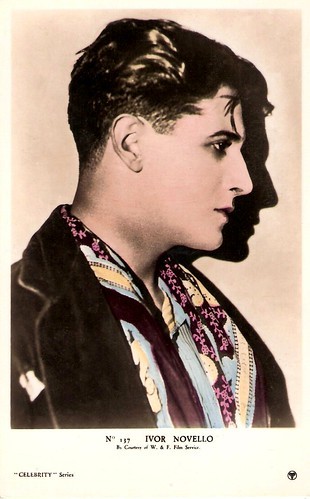
British Postcard in the Celebrities Series, no. 137, printed by Associated Photo Printers, London by courtesy of W & F Film Service.
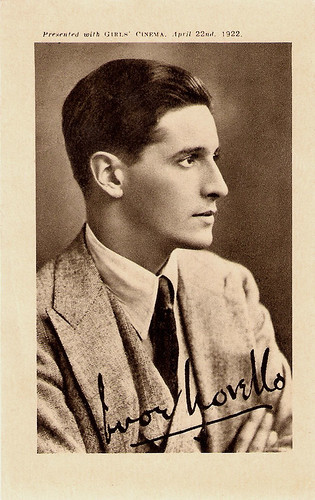
British postcard, presented with Girl's Cinema, 1922.
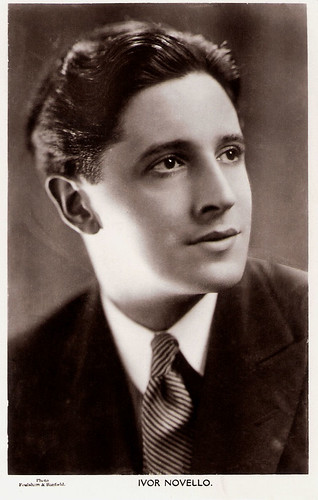
British Postcard in the Picturegoer Series, London, no. 82. Photo: Foulsham & Banfield.
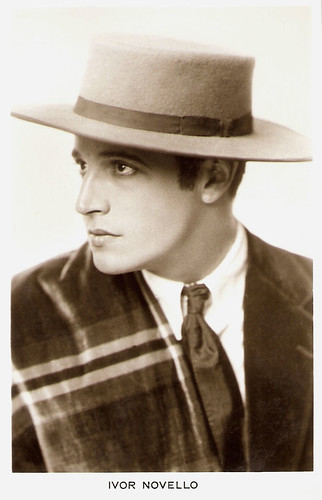
British postcard in the Picturegoer series by Real Photograph, London.
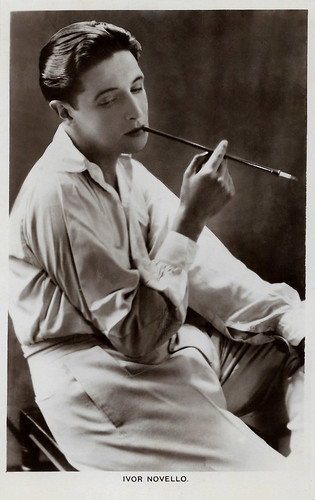
British postcard in the Picturegoer series, London, no. 194.
Crashes
Ivor Novello was born as David Ivor Davies at Llwyn-yr-Eos, Wales in 1893, to the well-known singing teacher and choral conductor Clara Novello Davies and David Davies, rent collector for the city council. The family then went to live in Cardiff, where his mother taught the Welsh Ladies Choir.
As a boy, Novello was a successful singer in Welsh Eisteddfod. He then attended the Magdalen College School in Oxford, where he sang in the famous choir. The good-looking boy made his first public appearances as a pub and working men's club pianist and singer in and around the Cardiff area.
Novello also showed a facility for writing songs, and when he was only 15, one of his songs was published. After leaving school, he gave piano lessons in Cardiff, and then moved to London in 1913. He took a flat above the Strand Theatre, which became his London home for the rest of his life.
At the start of the First World War, Novello wrote Keep the Home Fires Burning, a song that expressed the feelings of innumerable families sundered by World War I. Novello composed the music for the song to a lyric by the American Lena Guilbert-Ford. It became a real World War I standard, and earned him £15,000.
In 1916 Ivor received a commission as a Sub-Lieutenant and trained as a pilot in the Royal Naval Air Service. He completed dual flying instruction but crash landed on his first solo. His second solo flight ended in a more serious crash, in which he injured his ankle. The Royal Navy grounded him, and he was posted to clerical duties for the duration of the war.
While he was in the Navy, he worked for the show Theodore & Co (1916). It was a production by George Grossmith, Jr. and Edward Laurillard with a score composed by Novello and the young Jerome Kern. Again, it was a hit and, these successes made David Ivor Davies an overnight celebrity.
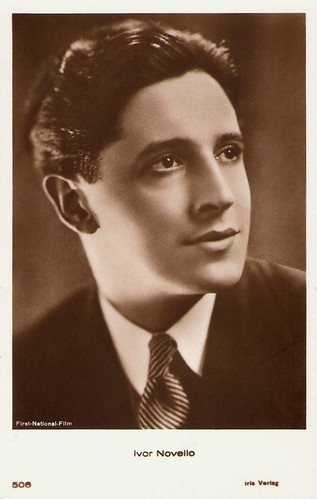
Austrian postcard by Iris Verlag, no. 506. Photo: First National Film.
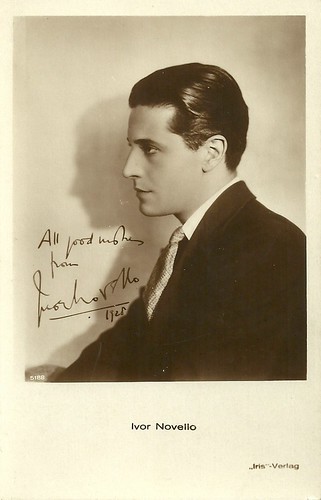
Austrian postcard by Iris Verlag, no. 5188. Dedication: "All good wishes from Ivor Novello, 1928."
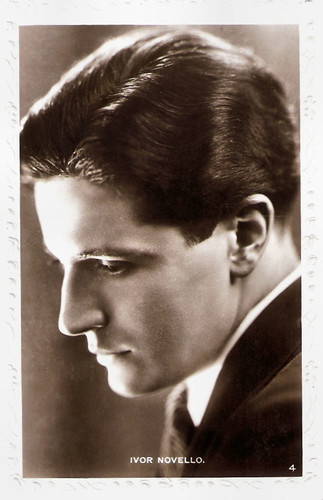
British Postcard, no. 4.
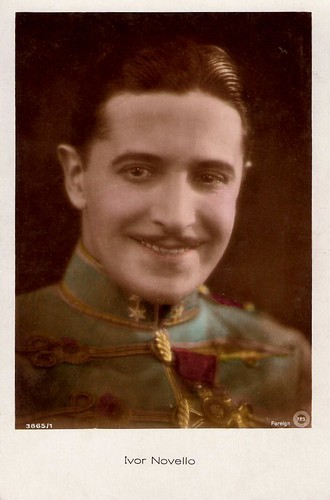
British postcard, no. 3865/1. Photo: FPS. At the backside: Real Hand-coloured Photograph.
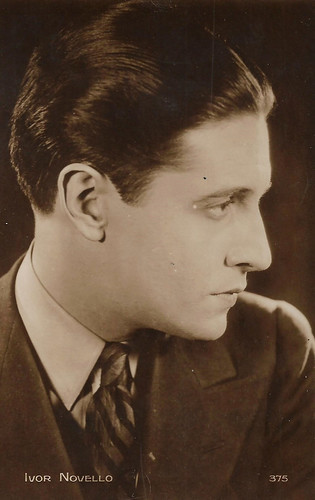
French postcard by Editions Cinémagazine, no. 375.
Home Fires
David Ivor Davies legally changed his name to Ivor Novello in January 1927, although he was known by that name on stage from at least 1918. After the First World War he pursued a film acting career and debuted as the romantic lead in L'appel du sang/The Call of the Blood (Louis Mercanton, 1919).
This French romantic melodrama starring Gabriel de Gravone was a box office success and earned Novello the sobriquet the 'Valentino from The Valleys'.
It was followed by roles in such films as the French drama Miarka, la fille à l'ourse/Gypsy Passion (Louis Mercanton, 1921) featuring Desdemona Mazza , the British drama Carnival (Harley Knoles, 1921) with Matheson Lang , and the romance The Bohemian Girl (Harley Knoles, 1922) with Gladys Cooper .
In 1923, he made his American movie debut in D. W. Griffith's The White Rose. His classic profile made Novello a matinee idol among filmgoers. On stage, he occasionally played dramatic roles, such as the title role in the first London production of Ferenc Molnar's Liliom, the Hungarian play from which the American musical Carousel was later adapted.
In 1924 Novello wrote and appeared in his first play, the successful The Rat which transferred quite well to film the following year. This film adaptation, The Rat (Graham Cutts, 1925) inspired two sequels - The Triumph of the Rat (Graham Cutts, 1926) and The Return of the Rat (Graham Cutts, 1929), both with Isabel Jeans.
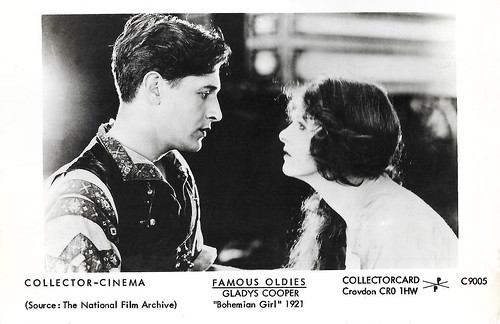
British postcard in the Famous Oldies series by Collectorcard, Croydon, no. C9005. Photo: The National Film Archive. Gladys Cooper and Ivor Novello in The Bohemian Girl (Harley Knoles, 1922).
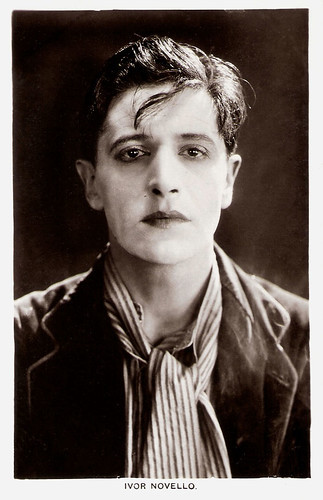
British Postcard in the Picturegoer Series, London, no. 39A. Photo: Ivor Novello in The Rat (Graham Cutts, 1925).
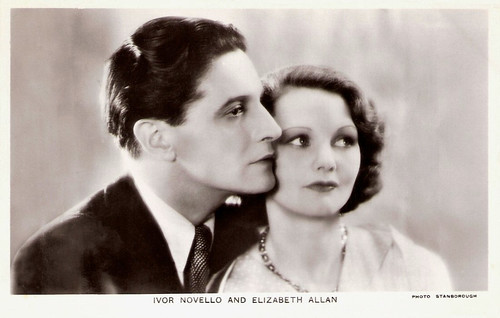
British postcard by A Real Photograph in the Film Partners series, no. P 41. Photo: Stanborough. Ivor Novello and Elizabeth Allan in the sound version of The Lodger (1932).
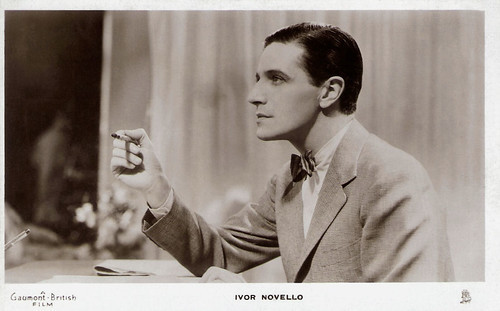
British postcard by Raphael Tuck & Sons, London, no. 50-S. Photo: Gaumont-British. Still for Love and Let Love/Sleeping Car (Anatole Litvak, 1933).
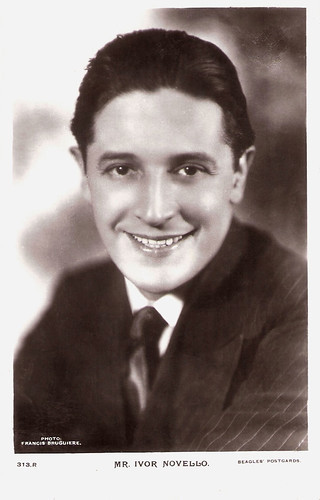
British Postcard by Beagles, no. 313.R. Photo: Francis Bruguiere.
Hitchcock
Ivo Novello peaked as a film star when he was the lead of two of Alfred Hitchcock's early suspense thrillers. He convincingly portrayed the brooding, sinister suspected serial killer in the silent classic The Lodger (Alfred Hitchcock, 1927). That year he also was the protagonist in the lesser-received Downhill (Alfred Hitchcock, 1927) with Isabel Jeans.
In 1928 Novello starred in the silent adaptation of Noel Coward's successful play The Vortex (Adrian Brunel, 1928), and made his last silent film, the comedy A South Sea Bubble (T. Hayes Hunter, 1928) with Benita Hume and Alma Taylor .
Novello's dark, handsome looks belied a charming modesty. He had a fine, well-modulated speaking voice that transferred quite well to talkies. After the introduction of sound film, he wrote and starred in Symphony in Two Flats (Gareth Gundrey, 1930) and remade The Lodger (Maurice Elvey, 1932) with Elizabeth Allan as his co-star.
During this time he surprisingly wrote the dialogue for Tarzan the Ape Man (W.S. Van Dyke, 1932), the first film to star Johnny Weissmuller and Maureen O'Sullivan . After his last film Autumn Crocus (Basil Dean, 1934), he decided to devote himself full time to music and the theatre.
He earned rave reviews for his opulent, romantically melodramatic stagings of Glamorous Night (1935), The Dancing Years (1939) and Perchance to Dream (1945). During his career he wrote eight musicals and appeared in six of them, all non-singing parts. Novello wrote his musicals in the style of operetta and was one of the last major composers in this form. He generally composed his music to the librettos of Christopher Hassall.
Although adored by thousands of women, Novello was gay. In 1916 he met the then 21-year-old actor Bobby Andrews. The pair became friends, then lovers, and stayed together for 35 years. They performed together many times in Novello's musicals and plays. In 1921, Novello also had an affair with the British poet and writer Siegfried Sassoon. Sassoon's biographer, John Stuart Roberts later wrote that Novello "was a consummate flirt who collected lovers as he gathered lilacs."
During most of his life, Novello lived in a country house in Littlewick Green, which he had bought from his film earnings. In 1951, Ivor Novello suddenly died from a coronary thrombosis in London at the age of 58. 7,000 people attended his funeral (women outnumbered men 50 to one).
Since the 1950s, the annual awards of the Performing Rights Society are named in his honour. In 2001, Jeremy Northam played Novello in Gosford Park (Robert Altman, 2001).
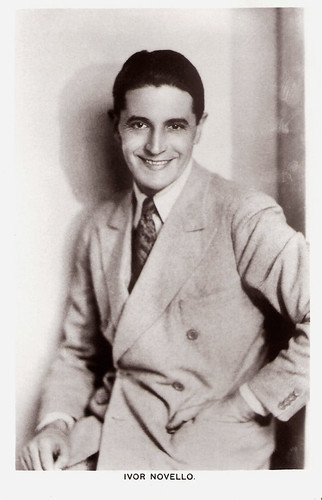
British postcard in the Picturegoer series by Real Photograph, London, no. 82a.
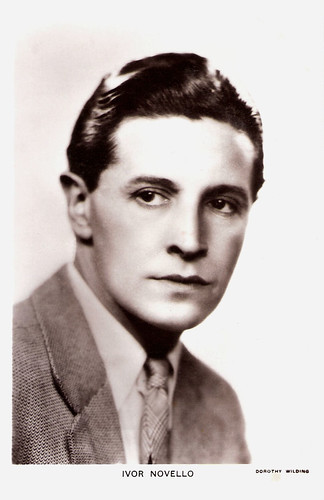
British postcard in the Picturegoer series by Real Photograph, London, no. 39c. Photo: Dorothy Wilding.
Short Apache Dance from The Rat (1925). Source: Jrrzyboy (YouTube).
Trailer for The Lodger (1927). Source: Chuy Espinosa (YouTube).
Ivor Novello in the mob scene of The Lodger (1927). Source: Karloff4 (YouTube).
Sources: Anthony Slide (Encyclopedia of British Cinema), (IMDb), BBC Wales, Wikipedia and

British Postcard in the Celebrities Series, no. 137, printed by Associated Photo Printers, London by courtesy of W & F Film Service.

British postcard, presented with Girl's Cinema, 1922.

British Postcard in the Picturegoer Series, London, no. 82. Photo: Foulsham & Banfield.

British postcard in the Picturegoer series by Real Photograph, London.

British postcard in the Picturegoer series, London, no. 194.
Crashes
Ivor Novello was born as David Ivor Davies at Llwyn-yr-Eos, Wales in 1893, to the well-known singing teacher and choral conductor Clara Novello Davies and David Davies, rent collector for the city council. The family then went to live in Cardiff, where his mother taught the Welsh Ladies Choir.
As a boy, Novello was a successful singer in Welsh Eisteddfod. He then attended the Magdalen College School in Oxford, where he sang in the famous choir. The good-looking boy made his first public appearances as a pub and working men's club pianist and singer in and around the Cardiff area.
Novello also showed a facility for writing songs, and when he was only 15, one of his songs was published. After leaving school, he gave piano lessons in Cardiff, and then moved to London in 1913. He took a flat above the Strand Theatre, which became his London home for the rest of his life.
At the start of the First World War, Novello wrote Keep the Home Fires Burning, a song that expressed the feelings of innumerable families sundered by World War I. Novello composed the music for the song to a lyric by the American Lena Guilbert-Ford. It became a real World War I standard, and earned him £15,000.
In 1916 Ivor received a commission as a Sub-Lieutenant and trained as a pilot in the Royal Naval Air Service. He completed dual flying instruction but crash landed on his first solo. His second solo flight ended in a more serious crash, in which he injured his ankle. The Royal Navy grounded him, and he was posted to clerical duties for the duration of the war.
While he was in the Navy, he worked for the show Theodore & Co (1916). It was a production by George Grossmith, Jr. and Edward Laurillard with a score composed by Novello and the young Jerome Kern. Again, it was a hit and, these successes made David Ivor Davies an overnight celebrity.

Austrian postcard by Iris Verlag, no. 506. Photo: First National Film.

Austrian postcard by Iris Verlag, no. 5188. Dedication: "All good wishes from Ivor Novello, 1928."

British Postcard, no. 4.

British postcard, no. 3865/1. Photo: FPS. At the backside: Real Hand-coloured Photograph.

French postcard by Editions Cinémagazine, no. 375.
Home Fires
David Ivor Davies legally changed his name to Ivor Novello in January 1927, although he was known by that name on stage from at least 1918. After the First World War he pursued a film acting career and debuted as the romantic lead in L'appel du sang/The Call of the Blood (Louis Mercanton, 1919).
This French romantic melodrama starring Gabriel de Gravone was a box office success and earned Novello the sobriquet the 'Valentino from The Valleys'.
It was followed by roles in such films as the French drama Miarka, la fille à l'ourse/Gypsy Passion (Louis Mercanton, 1921) featuring Desdemona Mazza , the British drama Carnival (Harley Knoles, 1921) with Matheson Lang , and the romance The Bohemian Girl (Harley Knoles, 1922) with Gladys Cooper .
In 1923, he made his American movie debut in D. W. Griffith's The White Rose. His classic profile made Novello a matinee idol among filmgoers. On stage, he occasionally played dramatic roles, such as the title role in the first London production of Ferenc Molnar's Liliom, the Hungarian play from which the American musical Carousel was later adapted.
In 1924 Novello wrote and appeared in his first play, the successful The Rat which transferred quite well to film the following year. This film adaptation, The Rat (Graham Cutts, 1925) inspired two sequels - The Triumph of the Rat (Graham Cutts, 1926) and The Return of the Rat (Graham Cutts, 1929), both with Isabel Jeans.

British postcard in the Famous Oldies series by Collectorcard, Croydon, no. C9005. Photo: The National Film Archive. Gladys Cooper and Ivor Novello in The Bohemian Girl (Harley Knoles, 1922).

British Postcard in the Picturegoer Series, London, no. 39A. Photo: Ivor Novello in The Rat (Graham Cutts, 1925).

British postcard by A Real Photograph in the Film Partners series, no. P 41. Photo: Stanborough. Ivor Novello and Elizabeth Allan in the sound version of The Lodger (1932).

British postcard by Raphael Tuck & Sons, London, no. 50-S. Photo: Gaumont-British. Still for Love and Let Love/Sleeping Car (Anatole Litvak, 1933).

British Postcard by Beagles, no. 313.R. Photo: Francis Bruguiere.
Hitchcock
Ivo Novello peaked as a film star when he was the lead of two of Alfred Hitchcock's early suspense thrillers. He convincingly portrayed the brooding, sinister suspected serial killer in the silent classic The Lodger (Alfred Hitchcock, 1927). That year he also was the protagonist in the lesser-received Downhill (Alfred Hitchcock, 1927) with Isabel Jeans.
In 1928 Novello starred in the silent adaptation of Noel Coward's successful play The Vortex (Adrian Brunel, 1928), and made his last silent film, the comedy A South Sea Bubble (T. Hayes Hunter, 1928) with Benita Hume and Alma Taylor .
Novello's dark, handsome looks belied a charming modesty. He had a fine, well-modulated speaking voice that transferred quite well to talkies. After the introduction of sound film, he wrote and starred in Symphony in Two Flats (Gareth Gundrey, 1930) and remade The Lodger (Maurice Elvey, 1932) with Elizabeth Allan as his co-star.
During this time he surprisingly wrote the dialogue for Tarzan the Ape Man (W.S. Van Dyke, 1932), the first film to star Johnny Weissmuller and Maureen O'Sullivan . After his last film Autumn Crocus (Basil Dean, 1934), he decided to devote himself full time to music and the theatre.
He earned rave reviews for his opulent, romantically melodramatic stagings of Glamorous Night (1935), The Dancing Years (1939) and Perchance to Dream (1945). During his career he wrote eight musicals and appeared in six of them, all non-singing parts. Novello wrote his musicals in the style of operetta and was one of the last major composers in this form. He generally composed his music to the librettos of Christopher Hassall.
Although adored by thousands of women, Novello was gay. In 1916 he met the then 21-year-old actor Bobby Andrews. The pair became friends, then lovers, and stayed together for 35 years. They performed together many times in Novello's musicals and plays. In 1921, Novello also had an affair with the British poet and writer Siegfried Sassoon. Sassoon's biographer, John Stuart Roberts later wrote that Novello "was a consummate flirt who collected lovers as he gathered lilacs."
During most of his life, Novello lived in a country house in Littlewick Green, which he had bought from his film earnings. In 1951, Ivor Novello suddenly died from a coronary thrombosis in London at the age of 58. 7,000 people attended his funeral (women outnumbered men 50 to one).
Since the 1950s, the annual awards of the Performing Rights Society are named in his honour. In 2001, Jeremy Northam played Novello in Gosford Park (Robert Altman, 2001).

British postcard in the Picturegoer series by Real Photograph, London, no. 82a.

British postcard in the Picturegoer series by Real Photograph, London, no. 39c. Photo: Dorothy Wilding.
Short Apache Dance from The Rat (1925). Source: Jrrzyboy (YouTube).
Trailer for The Lodger (1927). Source: Chuy Espinosa (YouTube).
Ivor Novello in the mob scene of The Lodger (1927). Source: Karloff4 (YouTube).
Sources: Anthony Slide (Encyclopedia of British Cinema), (IMDb), BBC Wales, Wikipedia and
Published on October 11, 2019 22:00
October 10, 2019
Rediscovered: the Silent Joan Crawford
Till Saturday 12 October EFSP follows Le Giornate del Cinema Muto in Pordenone. A major section of this year's festival is 'Restorations & Rediscoveries'. One of the films is Sally, Irene and Mary (1925), directed by Edmund Goulding. Sally, Irene and Mary are three showgirls, each with a different approach to life and love. They were played by Constance Bennett, Sally O'Neil and a very young Joan Crawford. It was Crawford's first hit and her following film career would span many decades, studios, and controversies. In her silent films she made impact as a vivacious Jazz Age flapper and later she matured into a star of psychological melodramas.
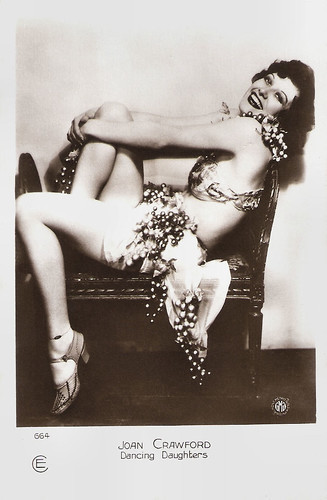
French postcard by Cinémagazine-Edition, no. 664. Photo: MGM. Joan Crawford in Our Dancing Daughters (Harry Beaumont, 1928).
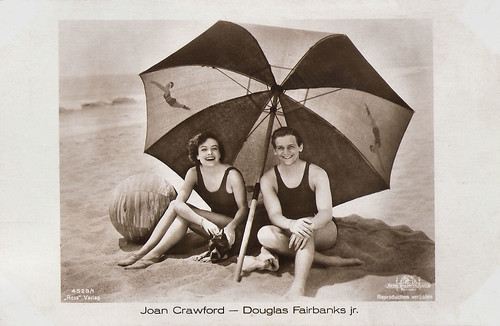
Joan Crawford and her first husband, Douglas Fairbanks Jr. German postcard by Ross Verlag, Berlin, no. 4628/1, 1929-1930. Photo: Metro-Goldwyn-Mayer.
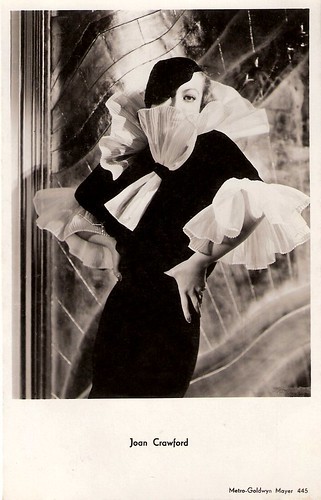
Dutch postcard by H.A.T.E., Rotterdam, no. 445, sent by mail in the Netherlands in 1934. Photo: George Hurrell / MGM (Metro-Goldwyn-Mayer).
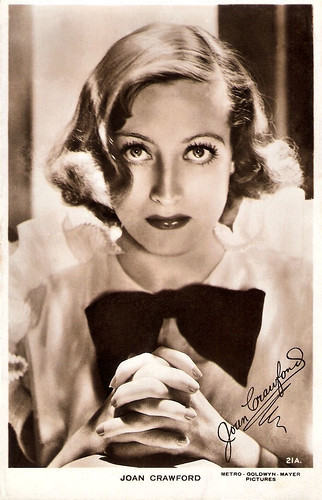
British Real Photograph postcard by Milton, no. 21A. Photo: Metro-Goldwyn-Mayer.
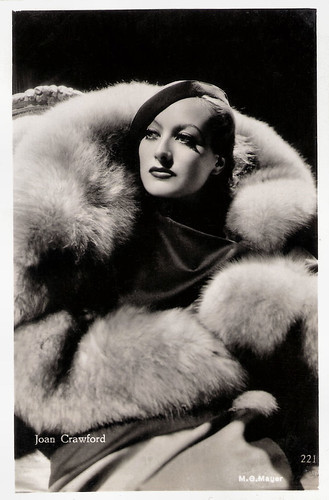
Dutch postcard by JosPe, no. 221. Photo: George Hurrell / Metro-Goldwyn-Mayer.
The free-spirited, all-American girl
Joan Crawford was born Lucille Fay LeSueur in 1904, in San Antonio, Texas. Her parents were Anna Belle (Johnson) and Thomas E. LeSueur, a laundry labourer. By the time she was born, her parents had separated.
The young Lucille was bullied and shunned at Scaritt Elementary School in Kansas City by the other students due to her poor home life. She worked with her mother in a laundry and felt that her classmates could smell the chemicals and cleaners on her. She said that her love of taking showers and being obsessed with cleanliness had begun early in life as an attempt to wash off the smell of the laundry.
Her stepfather Henry Cassin allegedly began sexually abusing her when she was eleven years old, and the abuse continued until she was sent to St. Agnes Academy, a Catholic girls' school. By the time she was a teenager, she'd had three stepfathers.
Lucille LeSueur worked a variety of menial jobs. She was a good dancer, though, and she entered several contests, one of which landed her a spot in a chorus line. Before long, she was dancing in the choruses of travelling revues in big Midwestern and East Coast cities.
She was spotted dancing in Detroit by famous New York producer Jacob J. Shubert. Shubert put her in the chorus line for his show 'Innocent Eyes'(1924) at the Winter Garden Theatre on Broadway. Then followed another Schubert production, 'The Passing Show of 1924'. After-hours, she danced for pay in the town it-spot, Club Richman, which was run by the 'Passing Show' stage manager Nils Granlund and popular local personality Harry Richman.
In December 1924, Granlund called Lucille to tell her that Al Altman, a NYC-based talent scout from MGM had caught her in 'The Passing Show of 1924' and wanted her to do a screen test. Metro-Goldwyn-Mayer (MGM) offered Crawford a contract at $75 a week. On New Year's Day 1925 she boarded the train for Culver City.
Credited as Lucille LeSueur, her first film part was as a showgirl in Lady of the Night (Monta Bell, 1925), starring MGM's most popular female star, Norma Shearer. Crawford was determined to succeed, and shortly after she also appeared in The Circle (Frank Borzage, 1925) and Pretty Ladies (Monta Bell, 1925), starring comedian ZaSu Pitts. She also appeared in a small role Erich von Stroheim 's classic The Merry Widow (1925) with Mae Murray and John Gilbert .
MGM publicity head Pete Smith recognised her ability to become a major star, but felt her name sounded fake. He told studio head Louis B. Mayer that her last name, LeSueur, reminded him of a sewer. Smith organised a contest called 'Name the Star' in Movie Weekly to allow readers to select her new stage name. The initial choice was 'Joan Arden', but after another actress was found to have prior claim to that name, the alternate surname 'Crawford' became the choice.
She first made an impression on audiences in Edmund Goulding's showgirl tale Sally, Irene and Mary (1925). The film, which co-starred Constance Bennett and Sally O'Neil, was a hit. Joan's popularity grew so quickly afterwards that two films in which she was still billed as Lucille Le Sueur: Old Clothes (Edward F. Cline, 1925) with Jackie Coogan, and The Only Thing (Jack Conway, 1925) were recalled, and her name on the billings was changed to Joan Crawford.
In 1926, Crawford was named one of the WAMPAS Baby Stars, and she starred opposite Charles Ray in Paris (Edmund Goulding, 1926). Within a few years, she became the romantic female lead to many of MGM's top male stars, including Ramón Novarro , John Gilbert , and action star Tim McCoy. She appeared alongside her close friend, William Haines in the comedy Spring Fever (Edward Sedgwick, 1927). It was the second film starring Haines and Crawford (the first had been Sally, Irene and Mary (1925)), and their first onscreen romantic teaming.
Then, Crawford appeared in the silent horror film The Unknown (Tod Browning, 1927), starring Lon Chaney, Sr. , who played Alonzo the Armless, a circus freak who uses his feet to toss knives. Crawford played his skimpily-clad young carnival assistant whom he hopes to marry. She stated that she learned more about acting from watching Chaney work than from anyone else in her career.
Her role of Diana Medford in Our Dancing Daughters (Harry Beaumont, 1928) elevated her to star status. Joan co-starred with Anita Page and Dorothy Sebastian, and her spunky wild-but-moral flapper character struck a chord with the public and zeitgeist. Wikipedia : "The role established her as a symbol of modern 1920s-style femininity which rivaled Clara Bow, the original It girl, then Hollywood's foremost flapper. A stream of hits followed Our Dancing Daughters, including two more flapper-themed movies, in which Crawford embodied for her legion of fans (many of whom were women) an idealized vision of the free-spirited, all-American girl."
The fan mail began pouring in and from that point on Joan was a bonafide star. Crawford had cleared the first big hurdle; now came the second, in the form of talkies. But Crawford wasn't felled by sound. Her first talkie, the romantic drama Untamed (Jack Conway, 1929) with Robert Montgomery, was a success. Michael Eliott at IMDb : "It's rather amazing to see how well she transformed into a sound star and you have to think that she was among the best to do so."
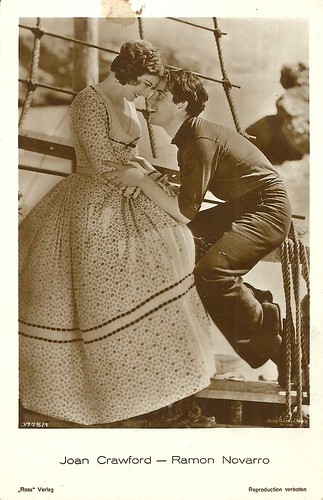
German postcard by Ross Verlag, no. 3775/1, 1928-1929. Photo: Metro-Goldwyn-Mayer. Joan Crawford and Ramón Novarro in Across to Singapore (William Nigh, 1928).
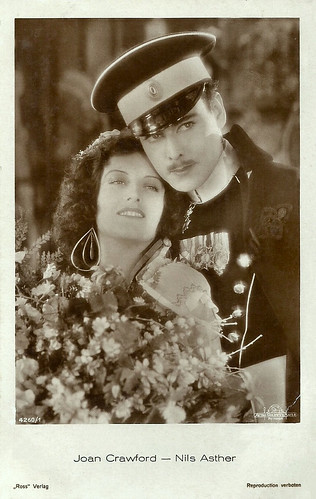
German postcard by Ross Verlag, no. 4260/1, 1929-1930. Photo: Metro-Goldwyn-Mayer. Nils Asther and Joan Crawford in Dream of Love (Fred Niblo, 1928).
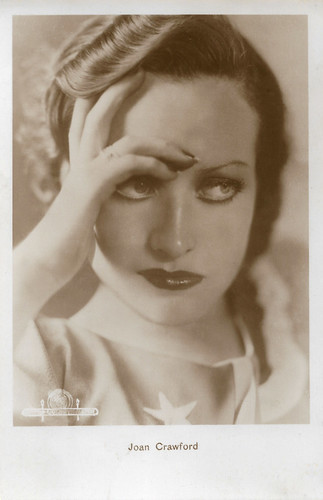
Belgian postcard by P.I.A. Belga Phot., Bruxelles. Photo: Metro-Goldwyn-Mayer. Caption: Les plus beaux films sont interprétés par les stars de la Metro GOLDWYN Mayer.
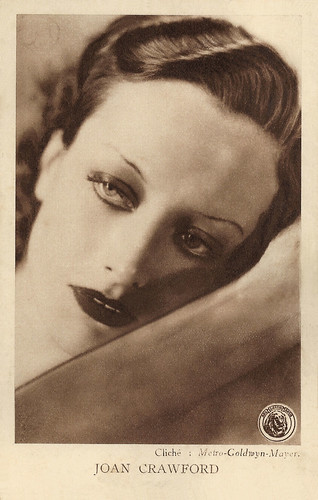
Belgian postcard by S.A. Cacao et Chocolat Kivou, Vilvoorde / N.V. Cacao en Chocolade Kivou, Vilvoorde. Photo: Metro-Goldwyn-Mayer (MGM).
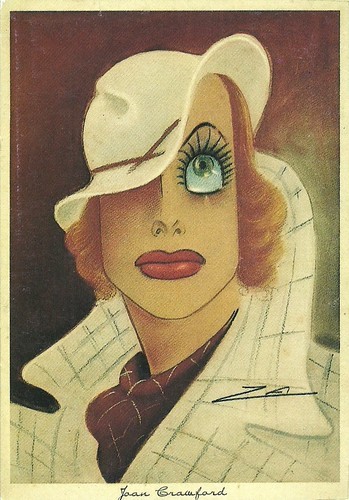
Italian postcard. Caricature by [Zeb].
The Woman with the Smear
In the early 1930s, tired of playing fun-loving flappers, Joan Crawford wanted to change her image. Thin lips would not do for her; she wanted big lips. Ignoring her natural lip contours, Max Factor ran a smear of colour across her upper and lower lips. It was just what she wanted. To Max, the Crawford look, which became her trademark, was always 'the smear'.
As the 1930s progressed, Joan Crawford became one of the biggest stars at MGM. She developed a glamorous screen image, appearing often as a sumptuously gowned, fur-draped, successful career woman. She was in top form in films such as Grand Hotel (Edmund Goulding, 1932), Sadie McKee (Clarence Brown, 1934), No More Ladies (Edward H. Griffith, 1935), and Love on the Run (W.S. Van Dyke, 1936) with Clark Gable.
Crawford often played hard-working young women who found romance and success. Movie patrons were enthralled, and studio executives were satisfied. Her fame rivalled, and later outlasted, that of MGM colleagues Norma Shearer and Greta Garbo . Among her early successes as a dramatic actress were The Women (George Cukor, 1939), Susan and God (1940), Strange Cargo (1940), and A Woman’s Face (1941).
By the early 1940s, MGM was no longer giving Joan Crawford plum roles. Newcomers had arrived in Hollywood, and the public wanted to see them. Crawford left MGM for rival Warner Bros.
In 1945 she landed the role of a lifetime in Mildred Pierce (Michael Curtiz, 1945). It is the story of an emotional and ambitious woman who rises from waitress to owner of a restaurant chain. The role gave her an opportunity to show her range as an actress, and her performance as a woman driven to give her daughter (Ann Blyth) everything garnered Crawford her first, and only, Oscar for Best Actress.
The following year she appeared with John Garfield in the well-received Humoresque (Jean Negulesco, 1946). In 1947, she appeared as Louise Graham in Possessed (Curtis Bernhardt, 1947) with Van Heflin. Again she was nominated for a Best Actress from the Academy, but she lost to Loretta Young in The Farmer's Daughter (H.C. Potter, 1947).
Crawford continued to choose her roles carefully, and in 1952 she was nominated for a third time, for her depiction of Myra Hudson in Sudden Fear (David Miller, 1952) opposite Jack Palance and Gloria Grahame . This time the coveted Oscar went to Shirley Booth, for Come Back, Little Sheba (Daniel Mann, 1952).
In 1955, Crawford became involved with the Pepsi-Cola Company through her marriage to company Chairman and Chief Executive Officer Alfred Steele. Crawford married four times. Her first three marriages to the actors Douglas Fairbanks, Jr. (1929–1933), Franchot Tone (1935–1939), and Phillip Terry (1942–1946) all had ended in divorce.
After his death in 1959 she became a director of the company and in that role hired her friend Dorothy Arzner to film several Pepsi commercials. Crawford's film career slowed and she appeared in minor roles until 1962. Then she and Bette Davis co-starred in Whatever happened to Baby Jane? (Robert Aldrich, 1962). Their longstanding rivalry may have helped fuel their phenomenally vitriolic and well-received performances.
Crawford's final appearance on the silver screen was in the bad monster movie Trog (Freddie Francis, 1970). It is said Bette Davis commented that if she had found herself starring in Trog, she'd commit suicide. Anyway, Joan Crawford retired from the screen, and following a public appearance in 1974 withdrew from public life. Turning to vodka more and more, she became increasingly reclusive.
In 1977, Joan Crawford died of a heart attack in New York City. She was 72 years old. She had disinherited her adopted daughter Christina and son Christopher; the former wrote the controversial memoir 'Mommie Dearest' (1978). In 1981, Faye Dunaway starred in the film adaptation Mommie Dearest (Frank Perry, 1981) which did well at the box office.
Joan Crawford is interred in a mausoleum in Ferncliff Cemetery in Hartsdale, New York.
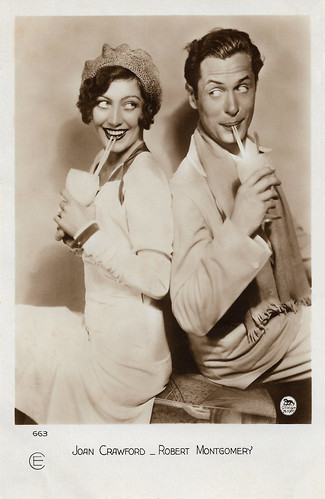
French postcard by Cinémagazine-Edition, Paris, no. 663. Photo: Metro-Goldwyn-Mayer. Joan Crawford and Robert Montgomery in Untamed (Jack Conway, 1929). Collection: Geoffrey Donaldson Institute.
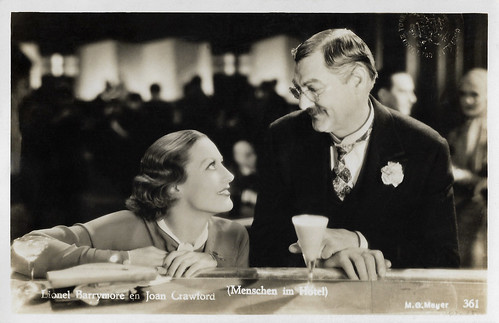
Dutch postcard by JosPe, no. 361. Photo: MGM. Joan Crawford and Lionel Barrymore in Grand Hotel (Edmund Goulding, 1932).
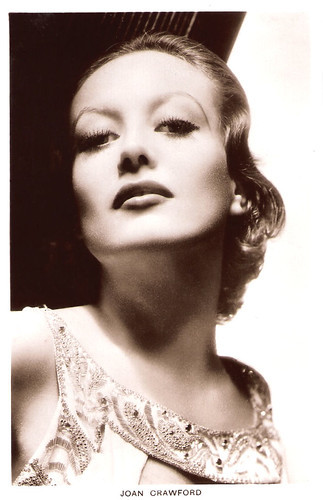
Vintage postcard. Photo: George Hurrell, 1932.
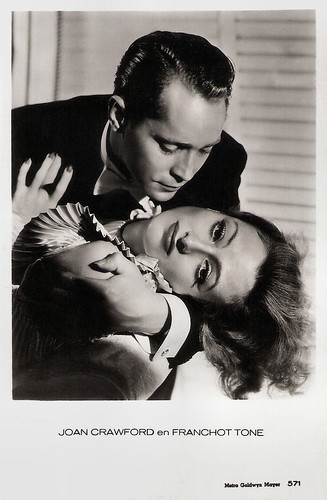
Dutch postcard, no. 571. Photo: George Hurrell / Metro-Goldwyn-Mayer (MGM). Joan Crawford and second husband Franchot Tone in Dancing Lady (Robert Z. Leonard, 1933).
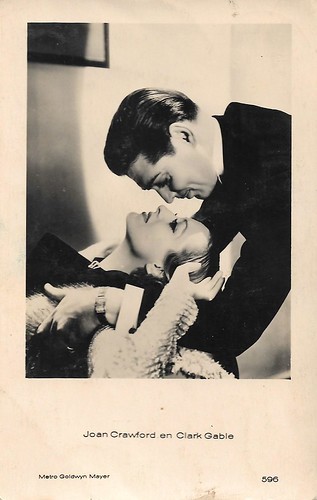
Dutch postcard, no. 596. Photo: George Hurrell / Metro-Goldwyn-Mayer (MGM). Joan Crawford and Clark Gable in Dancing Lady (Robert Z. Leonard, 1933).
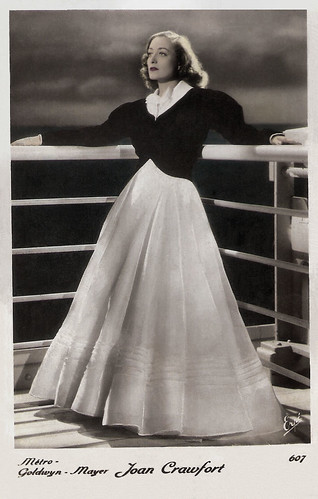
French postcard by Erpé, no. 607. Photo: Metro-Goldwyn-Mayer (MGM). Joan Crawford in Mannequin (Frank Borzage, 1937).
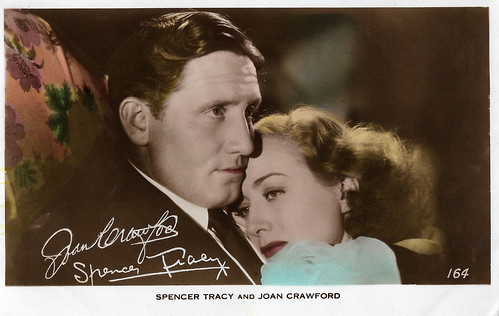
British postcard by Art Photo, no. 164. Photo: Metro-Goldwyn-Mayer. Spencer Tracy and Joan Crawford in Mannequin (Frank Borzage, 1937).
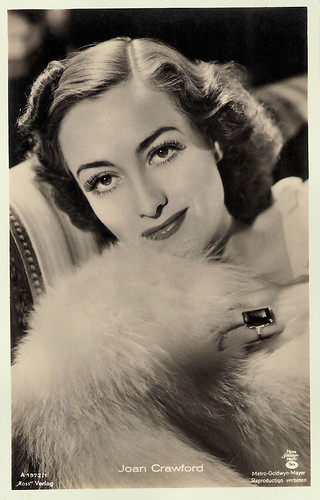
German postcard by Ross Verlag, no. A 1972/1, 1937-1938. Photo: Metro-Goldwyn-Mayer (MGM).
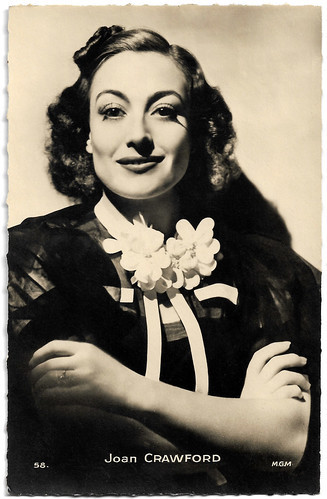
French postcard by E.C., Rueil-Malmaison, no. 58. Photo: Metro-Goldwyn-Mayer (MGM).
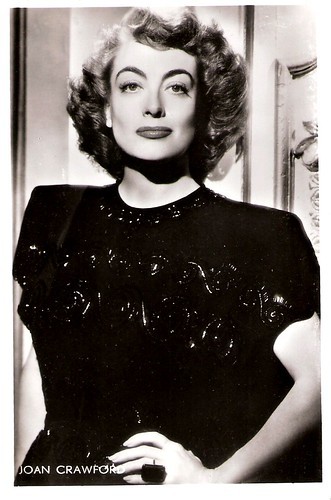
Dutch postcard by J. Sleeding N.V., Amsterdam, no. 11. Photo: Warner Bros.
Sources: Stephanie Jones (The Best of Everything), Michael Elliott (IMDb), Encyclopaedia Britannica, Wikipedia and .

French postcard by Cinémagazine-Edition, no. 664. Photo: MGM. Joan Crawford in Our Dancing Daughters (Harry Beaumont, 1928).

Joan Crawford and her first husband, Douglas Fairbanks Jr. German postcard by Ross Verlag, Berlin, no. 4628/1, 1929-1930. Photo: Metro-Goldwyn-Mayer.

Dutch postcard by H.A.T.E., Rotterdam, no. 445, sent by mail in the Netherlands in 1934. Photo: George Hurrell / MGM (Metro-Goldwyn-Mayer).

British Real Photograph postcard by Milton, no. 21A. Photo: Metro-Goldwyn-Mayer.

Dutch postcard by JosPe, no. 221. Photo: George Hurrell / Metro-Goldwyn-Mayer.
The free-spirited, all-American girl
Joan Crawford was born Lucille Fay LeSueur in 1904, in San Antonio, Texas. Her parents were Anna Belle (Johnson) and Thomas E. LeSueur, a laundry labourer. By the time she was born, her parents had separated.
The young Lucille was bullied and shunned at Scaritt Elementary School in Kansas City by the other students due to her poor home life. She worked with her mother in a laundry and felt that her classmates could smell the chemicals and cleaners on her. She said that her love of taking showers and being obsessed with cleanliness had begun early in life as an attempt to wash off the smell of the laundry.
Her stepfather Henry Cassin allegedly began sexually abusing her when she was eleven years old, and the abuse continued until she was sent to St. Agnes Academy, a Catholic girls' school. By the time she was a teenager, she'd had three stepfathers.
Lucille LeSueur worked a variety of menial jobs. She was a good dancer, though, and she entered several contests, one of which landed her a spot in a chorus line. Before long, she was dancing in the choruses of travelling revues in big Midwestern and East Coast cities.
She was spotted dancing in Detroit by famous New York producer Jacob J. Shubert. Shubert put her in the chorus line for his show 'Innocent Eyes'(1924) at the Winter Garden Theatre on Broadway. Then followed another Schubert production, 'The Passing Show of 1924'. After-hours, she danced for pay in the town it-spot, Club Richman, which was run by the 'Passing Show' stage manager Nils Granlund and popular local personality Harry Richman.
In December 1924, Granlund called Lucille to tell her that Al Altman, a NYC-based talent scout from MGM had caught her in 'The Passing Show of 1924' and wanted her to do a screen test. Metro-Goldwyn-Mayer (MGM) offered Crawford a contract at $75 a week. On New Year's Day 1925 she boarded the train for Culver City.
Credited as Lucille LeSueur, her first film part was as a showgirl in Lady of the Night (Monta Bell, 1925), starring MGM's most popular female star, Norma Shearer. Crawford was determined to succeed, and shortly after she also appeared in The Circle (Frank Borzage, 1925) and Pretty Ladies (Monta Bell, 1925), starring comedian ZaSu Pitts. She also appeared in a small role Erich von Stroheim 's classic The Merry Widow (1925) with Mae Murray and John Gilbert .
MGM publicity head Pete Smith recognised her ability to become a major star, but felt her name sounded fake. He told studio head Louis B. Mayer that her last name, LeSueur, reminded him of a sewer. Smith organised a contest called 'Name the Star' in Movie Weekly to allow readers to select her new stage name. The initial choice was 'Joan Arden', but after another actress was found to have prior claim to that name, the alternate surname 'Crawford' became the choice.
She first made an impression on audiences in Edmund Goulding's showgirl tale Sally, Irene and Mary (1925). The film, which co-starred Constance Bennett and Sally O'Neil, was a hit. Joan's popularity grew so quickly afterwards that two films in which she was still billed as Lucille Le Sueur: Old Clothes (Edward F. Cline, 1925) with Jackie Coogan, and The Only Thing (Jack Conway, 1925) were recalled, and her name on the billings was changed to Joan Crawford.
In 1926, Crawford was named one of the WAMPAS Baby Stars, and she starred opposite Charles Ray in Paris (Edmund Goulding, 1926). Within a few years, she became the romantic female lead to many of MGM's top male stars, including Ramón Novarro , John Gilbert , and action star Tim McCoy. She appeared alongside her close friend, William Haines in the comedy Spring Fever (Edward Sedgwick, 1927). It was the second film starring Haines and Crawford (the first had been Sally, Irene and Mary (1925)), and their first onscreen romantic teaming.
Then, Crawford appeared in the silent horror film The Unknown (Tod Browning, 1927), starring Lon Chaney, Sr. , who played Alonzo the Armless, a circus freak who uses his feet to toss knives. Crawford played his skimpily-clad young carnival assistant whom he hopes to marry. She stated that she learned more about acting from watching Chaney work than from anyone else in her career.
Her role of Diana Medford in Our Dancing Daughters (Harry Beaumont, 1928) elevated her to star status. Joan co-starred with Anita Page and Dorothy Sebastian, and her spunky wild-but-moral flapper character struck a chord with the public and zeitgeist. Wikipedia : "The role established her as a symbol of modern 1920s-style femininity which rivaled Clara Bow, the original It girl, then Hollywood's foremost flapper. A stream of hits followed Our Dancing Daughters, including two more flapper-themed movies, in which Crawford embodied for her legion of fans (many of whom were women) an idealized vision of the free-spirited, all-American girl."
The fan mail began pouring in and from that point on Joan was a bonafide star. Crawford had cleared the first big hurdle; now came the second, in the form of talkies. But Crawford wasn't felled by sound. Her first talkie, the romantic drama Untamed (Jack Conway, 1929) with Robert Montgomery, was a success. Michael Eliott at IMDb : "It's rather amazing to see how well she transformed into a sound star and you have to think that she was among the best to do so."

German postcard by Ross Verlag, no. 3775/1, 1928-1929. Photo: Metro-Goldwyn-Mayer. Joan Crawford and Ramón Novarro in Across to Singapore (William Nigh, 1928).

German postcard by Ross Verlag, no. 4260/1, 1929-1930. Photo: Metro-Goldwyn-Mayer. Nils Asther and Joan Crawford in Dream of Love (Fred Niblo, 1928).

Belgian postcard by P.I.A. Belga Phot., Bruxelles. Photo: Metro-Goldwyn-Mayer. Caption: Les plus beaux films sont interprétés par les stars de la Metro GOLDWYN Mayer.

Belgian postcard by S.A. Cacao et Chocolat Kivou, Vilvoorde / N.V. Cacao en Chocolade Kivou, Vilvoorde. Photo: Metro-Goldwyn-Mayer (MGM).

Italian postcard. Caricature by [Zeb].
The Woman with the Smear
In the early 1930s, tired of playing fun-loving flappers, Joan Crawford wanted to change her image. Thin lips would not do for her; she wanted big lips. Ignoring her natural lip contours, Max Factor ran a smear of colour across her upper and lower lips. It was just what she wanted. To Max, the Crawford look, which became her trademark, was always 'the smear'.
As the 1930s progressed, Joan Crawford became one of the biggest stars at MGM. She developed a glamorous screen image, appearing often as a sumptuously gowned, fur-draped, successful career woman. She was in top form in films such as Grand Hotel (Edmund Goulding, 1932), Sadie McKee (Clarence Brown, 1934), No More Ladies (Edward H. Griffith, 1935), and Love on the Run (W.S. Van Dyke, 1936) with Clark Gable.
Crawford often played hard-working young women who found romance and success. Movie patrons were enthralled, and studio executives were satisfied. Her fame rivalled, and later outlasted, that of MGM colleagues Norma Shearer and Greta Garbo . Among her early successes as a dramatic actress were The Women (George Cukor, 1939), Susan and God (1940), Strange Cargo (1940), and A Woman’s Face (1941).
By the early 1940s, MGM was no longer giving Joan Crawford plum roles. Newcomers had arrived in Hollywood, and the public wanted to see them. Crawford left MGM for rival Warner Bros.
In 1945 she landed the role of a lifetime in Mildred Pierce (Michael Curtiz, 1945). It is the story of an emotional and ambitious woman who rises from waitress to owner of a restaurant chain. The role gave her an opportunity to show her range as an actress, and her performance as a woman driven to give her daughter (Ann Blyth) everything garnered Crawford her first, and only, Oscar for Best Actress.
The following year she appeared with John Garfield in the well-received Humoresque (Jean Negulesco, 1946). In 1947, she appeared as Louise Graham in Possessed (Curtis Bernhardt, 1947) with Van Heflin. Again she was nominated for a Best Actress from the Academy, but she lost to Loretta Young in The Farmer's Daughter (H.C. Potter, 1947).
Crawford continued to choose her roles carefully, and in 1952 she was nominated for a third time, for her depiction of Myra Hudson in Sudden Fear (David Miller, 1952) opposite Jack Palance and Gloria Grahame . This time the coveted Oscar went to Shirley Booth, for Come Back, Little Sheba (Daniel Mann, 1952).
In 1955, Crawford became involved with the Pepsi-Cola Company through her marriage to company Chairman and Chief Executive Officer Alfred Steele. Crawford married four times. Her first three marriages to the actors Douglas Fairbanks, Jr. (1929–1933), Franchot Tone (1935–1939), and Phillip Terry (1942–1946) all had ended in divorce.
After his death in 1959 she became a director of the company and in that role hired her friend Dorothy Arzner to film several Pepsi commercials. Crawford's film career slowed and she appeared in minor roles until 1962. Then she and Bette Davis co-starred in Whatever happened to Baby Jane? (Robert Aldrich, 1962). Their longstanding rivalry may have helped fuel their phenomenally vitriolic and well-received performances.
Crawford's final appearance on the silver screen was in the bad monster movie Trog (Freddie Francis, 1970). It is said Bette Davis commented that if she had found herself starring in Trog, she'd commit suicide. Anyway, Joan Crawford retired from the screen, and following a public appearance in 1974 withdrew from public life. Turning to vodka more and more, she became increasingly reclusive.
In 1977, Joan Crawford died of a heart attack in New York City. She was 72 years old. She had disinherited her adopted daughter Christina and son Christopher; the former wrote the controversial memoir 'Mommie Dearest' (1978). In 1981, Faye Dunaway starred in the film adaptation Mommie Dearest (Frank Perry, 1981) which did well at the box office.
Joan Crawford is interred in a mausoleum in Ferncliff Cemetery in Hartsdale, New York.

French postcard by Cinémagazine-Edition, Paris, no. 663. Photo: Metro-Goldwyn-Mayer. Joan Crawford and Robert Montgomery in Untamed (Jack Conway, 1929). Collection: Geoffrey Donaldson Institute.

Dutch postcard by JosPe, no. 361. Photo: MGM. Joan Crawford and Lionel Barrymore in Grand Hotel (Edmund Goulding, 1932).

Vintage postcard. Photo: George Hurrell, 1932.

Dutch postcard, no. 571. Photo: George Hurrell / Metro-Goldwyn-Mayer (MGM). Joan Crawford and second husband Franchot Tone in Dancing Lady (Robert Z. Leonard, 1933).

Dutch postcard, no. 596. Photo: George Hurrell / Metro-Goldwyn-Mayer (MGM). Joan Crawford and Clark Gable in Dancing Lady (Robert Z. Leonard, 1933).

French postcard by Erpé, no. 607. Photo: Metro-Goldwyn-Mayer (MGM). Joan Crawford in Mannequin (Frank Borzage, 1937).

British postcard by Art Photo, no. 164. Photo: Metro-Goldwyn-Mayer. Spencer Tracy and Joan Crawford in Mannequin (Frank Borzage, 1937).

German postcard by Ross Verlag, no. A 1972/1, 1937-1938. Photo: Metro-Goldwyn-Mayer (MGM).

French postcard by E.C., Rueil-Malmaison, no. 58. Photo: Metro-Goldwyn-Mayer (MGM).

Dutch postcard by J. Sleeding N.V., Amsterdam, no. 11. Photo: Warner Bros.
Sources: Stephanie Jones (The Best of Everything), Michael Elliott (IMDb), Encyclopaedia Britannica, Wikipedia and .
Published on October 10, 2019 22:00
October 9, 2019
Mistinguett
EFSP still follows Le Giornate del Cinema Muto in Pordenone. The retrospective of Suzanne Grandais, about which we posted yesterday, is combined with a retrospective on another legendary French actress, Mistinguett (1875-1956). As a singer, she captivated Paris with her risque routines. She went on to become the most popular French entertainer of her time and the highest paid female entertainer in the world. Mistinguett also appeared more than 60 times in the cinema.
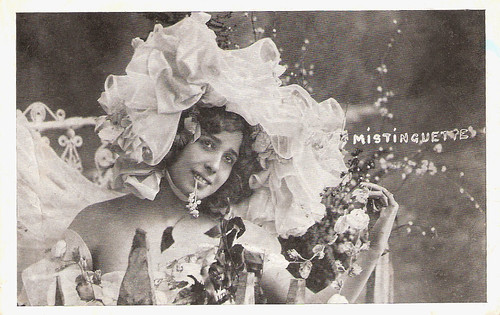
French postcard, sent by mail in 1905.

French postcard in the series Nos artistes dans leur loge, no. 2. Photo: Comoedia.
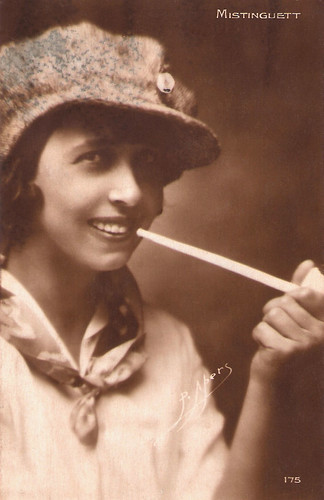
French postcard by Cinémagazine-Edition, Paris, no. 175. Photo: P. Apers.
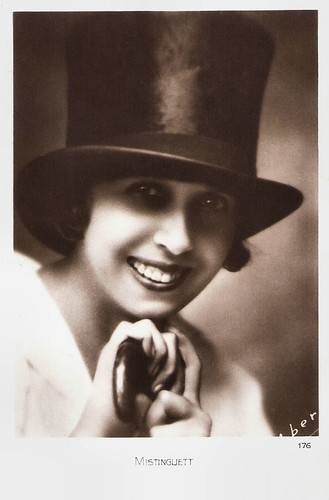
French postcard by Cinémagazine-Edition, no. 176. Photo: P. Apers.
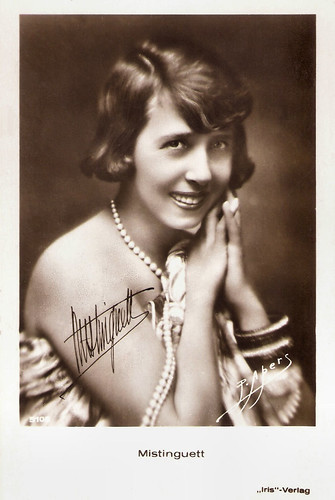
Austrian postcard by Iris-Verlag, no. 5108. Photo: P. Apers.
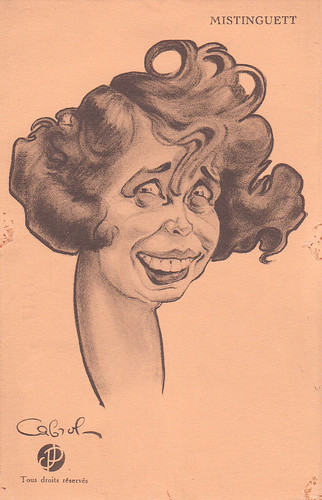
French postcard. Illustration: Cabrol. Collection: Marlène Pilaete.
Miss Tinguette
Mistinguett was born as Jeanne Florentine Bourgeois in Enghien-les-Bains, France, in 1875. She was the daughter of labourer Antoine Bourgeois, and seamstress Jeannette Debrée. At an early age Jeanne aspired to be an entertainer. She began as a flower seller in a restaurant in her hometown, singing popular ballads as she sold her flowers.
When a song-writing acquaintance made up the name Miss Tinguette, Jeanne liked it. She made it her own by joining it together and eventually dropping the second S and the final E (Mistinguett). Mistinguett made her debut at the Casino de Paris in 1895, and appeared also in shows at the Folies Bergère, Moulin Rouge, and Eldorado.
In 1908 she made her film debut in the short silent film L'empreinte ou La main rouge/The Impression or the Red Hand (Henri Burguet, 1908) for Pathé Fréres. Her co-star in this film was Max Dearly . The next year, he chose her to be his partner to create La valse chaloupée (or the Apache Dance) in the Moulin Rouge.
Between 1909 and 1915, she appeared on the stages of the Paris music halls but also in dozens of short films for Pathé, including Fleur de pavé/Her Dramatic Career (Albert Capellani, Michel Carré, 1909) with Charles Prince , Une petite femme bien douce/A Sweet Little Lady (George Denola, 1910) which she also wrote, and Le clown et le pacha/The Clown and the Pasha (Georges Monca, 1911), again with Prince.
In Une bougie récalcitrante/A Stubborn Spark Plug (Georges Monca, 1912), she appeared for the first time opposite the much younger Maurice Chevalier . With Chevalier she would have a relationship of more than 10 years.
The most successful film among her Pathé films was Les misérables (Albert Capelani, 1913), a four-part-serial based on the famous novel by Victor Hugo.
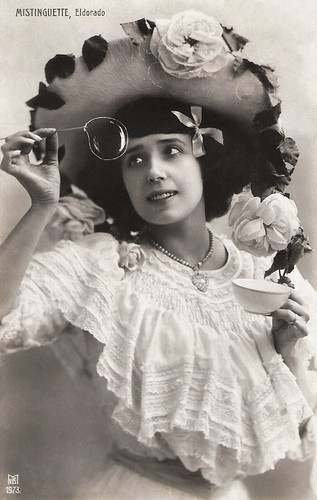
Austrian postcard by Iris-Verlag, no. 5108. Photo: P. Apers.
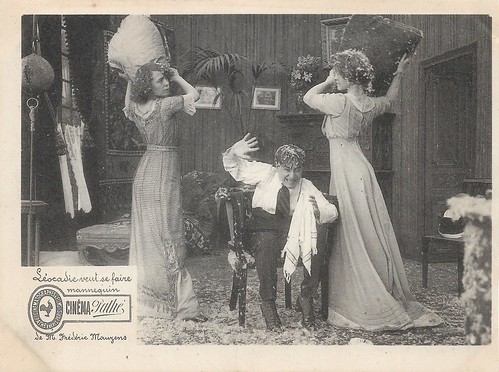
French collectors cards by Pathé Frères, 1911. Mistinguett in the early French comedy Léocadie veut se faire mannequin (SCAGL/ Pathé Frères, 1911).

French postcard by F.C. & Cie, no. 283. Photo: Boyer & Bert. Mistinguett and Max Dearly performing the Apache Dance. Collection: Didier Hanson.
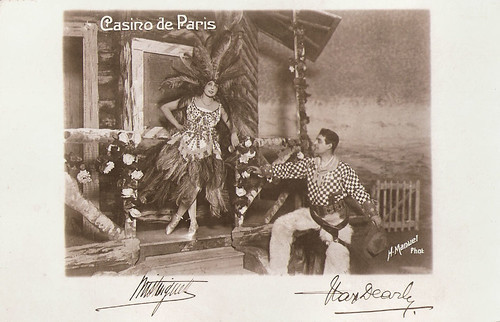
French postcard by Etablissements photographiques de Boulogne-sur-Seine. Photo: H. Manuel. Mistinguett and Max Dearly at the Casino de Paris.
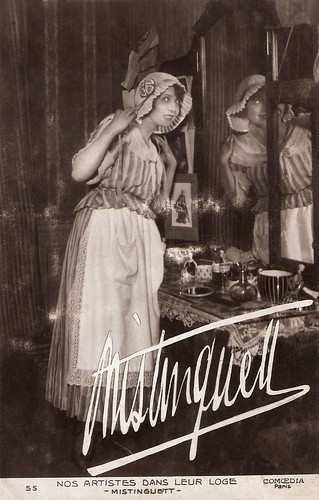
French postcard in the Nos Artistes dans leur loge series no. 55. Photo: Comoedia, Paris.
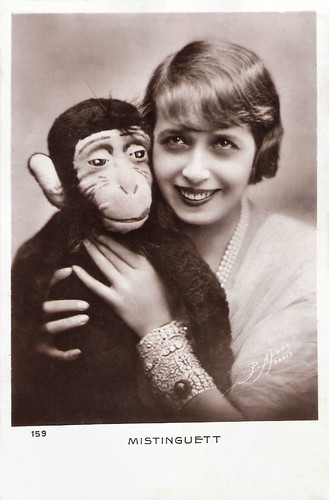
French postcard, no. 159. Photo: P. Apers, Paris.
Legs of 500,000 Francs
During the First World War, Mistinguett continued to appear in Pathé productions like the comedies La valse renversante/The Amazing Waltz (Georges Monca, 1914) again opposite Maurice Chevalier , and Rigadin et la jolie manucure/Rigadin and the Pretty Manicurist (Georges Monca, 1915) with Charles Prince .
In Italy, she appeared in La doppia ferita/The Double Injury (Augusto Genina, 1915). Opposite the legendary Harry Baur, she starred in Chignon d'or/The Gold Chignon (André Hugon, 1916) and Fleur de Paris/Flower of Paris (André Hugon, 1916).
Mistinguett first recorded her signature song Mon Homme in 1916. It was popularised under its English title My Man by Fanny Brice and has become a standard in the repertoire of numerous pop and jazz singers.
In 1918, she succeeded Gaby Deslys at the Casino de Paris, and remained the undisputed star of nocturnal Paris until 1925. In 1919 her legs were insured for the then astounding amount of 500,000 francs. During a tour of the United States, she was asked by Time magazine to explain her popularity. Her answer was: "It is a kind of magnetism. I say 'Come closer' and draw them to me."
After WWI, Mistinguett's film career halted. She only appeared in a few more films, including L'île d'amour/Island of Love (Berthe Dagmar, Jean Durand, 1928) and Rigolboche (Christian-Jaque, 1936). Mistinguett's stage career prospered and lasted over fifty years.
Her last film appearance was as herself in the Italian musical Carosello del varietà/Variety Carousel (Aldo Bonaldi, Aldo Quinti, 1955). In 1956, Mistinguett died at the age of 80. She is buried in the Cimetiere Enghien-les-Bains, Île-de-France, France.
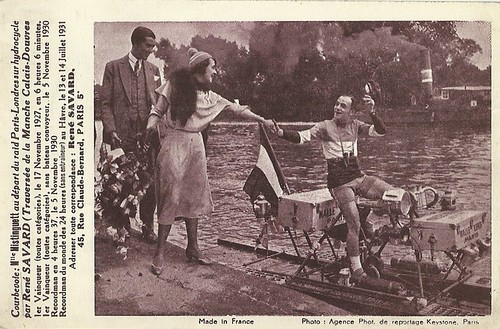
French postcard by Agence Phot. de reportage Keystone, Paris. Courbevoie: Mlle Mistinguett at the departure of the match Paris-London on hydrocycle by René Savard (crossing The Channel between Calais and Dover).
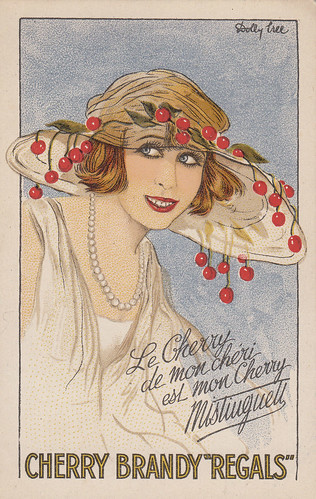
French postcard for Cherry Brandy "Regals". Illustration: Dolly Tree. Collection: Marlène Pilaete.
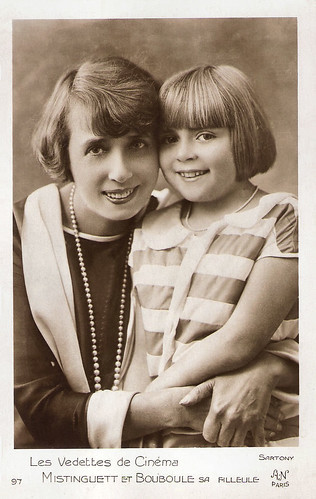
French postcard in the Les Vedettes de Cinéma series by A.N., Paris, no. 97. Photo: Sarony. Bouboule was Mistinguett's goddaughter, an admittedly talented child actress. She was born in 1917 and from 1921 on, she appeared in 13 films.
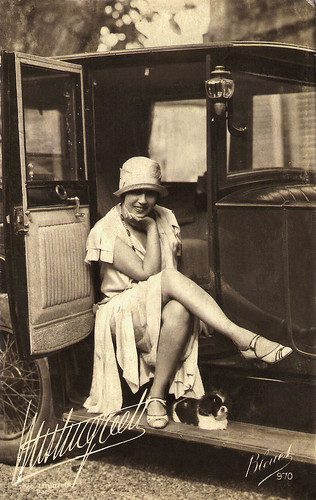
French postcard by Bleuet, no. 970. Photo: Utudjian, Paris.
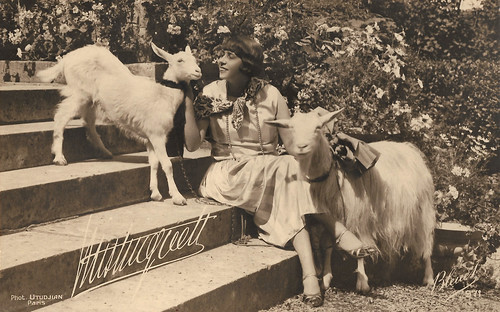
French postcard by Bleuet, no. 971. Photo: Utudjian, Paris.
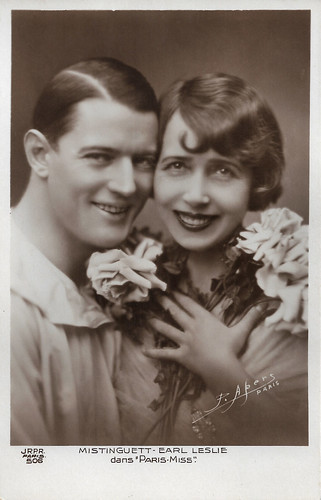
French postcard by J.R.P.R., Paris, no. 506. Photo: P. Apers. Mistinguett and Earl Leslie in the revue ' Paris Miss' at the Casino de Paris in 1930.
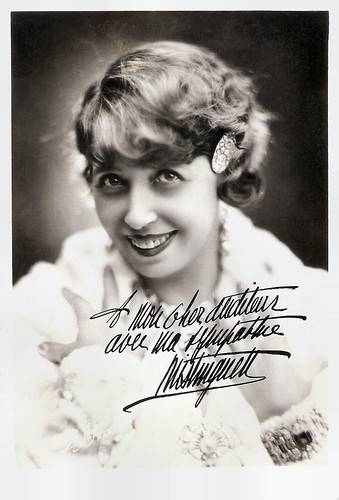
French autograph card.
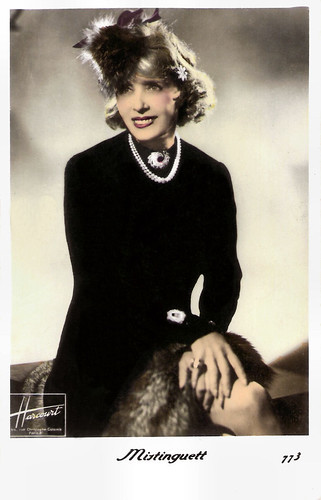
French postcard, no. 113. Photo: Studio Harcourt.
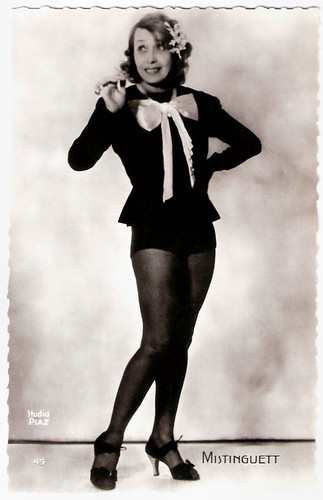
French postcard by Editions P.I., no. 49. Photo: Studio Piaz.
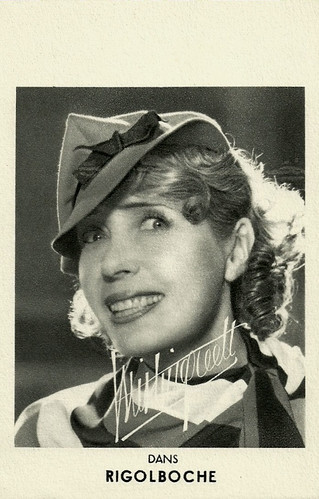
French or Belgian postcard. Mistinguett in the sound film Rigolboche (Christian-Jaque, 1936).
Sources: Wikipedia and .

French postcard, sent by mail in 1905.

French postcard in the series Nos artistes dans leur loge, no. 2. Photo: Comoedia.

French postcard by Cinémagazine-Edition, Paris, no. 175. Photo: P. Apers.

French postcard by Cinémagazine-Edition, no. 176. Photo: P. Apers.

Austrian postcard by Iris-Verlag, no. 5108. Photo: P. Apers.

French postcard. Illustration: Cabrol. Collection: Marlène Pilaete.
Miss Tinguette
Mistinguett was born as Jeanne Florentine Bourgeois in Enghien-les-Bains, France, in 1875. She was the daughter of labourer Antoine Bourgeois, and seamstress Jeannette Debrée. At an early age Jeanne aspired to be an entertainer. She began as a flower seller in a restaurant in her hometown, singing popular ballads as she sold her flowers.
When a song-writing acquaintance made up the name Miss Tinguette, Jeanne liked it. She made it her own by joining it together and eventually dropping the second S and the final E (Mistinguett). Mistinguett made her debut at the Casino de Paris in 1895, and appeared also in shows at the Folies Bergère, Moulin Rouge, and Eldorado.
In 1908 she made her film debut in the short silent film L'empreinte ou La main rouge/The Impression or the Red Hand (Henri Burguet, 1908) for Pathé Fréres. Her co-star in this film was Max Dearly . The next year, he chose her to be his partner to create La valse chaloupée (or the Apache Dance) in the Moulin Rouge.
Between 1909 and 1915, she appeared on the stages of the Paris music halls but also in dozens of short films for Pathé, including Fleur de pavé/Her Dramatic Career (Albert Capellani, Michel Carré, 1909) with Charles Prince , Une petite femme bien douce/A Sweet Little Lady (George Denola, 1910) which she also wrote, and Le clown et le pacha/The Clown and the Pasha (Georges Monca, 1911), again with Prince.
In Une bougie récalcitrante/A Stubborn Spark Plug (Georges Monca, 1912), she appeared for the first time opposite the much younger Maurice Chevalier . With Chevalier she would have a relationship of more than 10 years.
The most successful film among her Pathé films was Les misérables (Albert Capelani, 1913), a four-part-serial based on the famous novel by Victor Hugo.

Austrian postcard by Iris-Verlag, no. 5108. Photo: P. Apers.

French collectors cards by Pathé Frères, 1911. Mistinguett in the early French comedy Léocadie veut se faire mannequin (SCAGL/ Pathé Frères, 1911).

French postcard by F.C. & Cie, no. 283. Photo: Boyer & Bert. Mistinguett and Max Dearly performing the Apache Dance. Collection: Didier Hanson.

French postcard by Etablissements photographiques de Boulogne-sur-Seine. Photo: H. Manuel. Mistinguett and Max Dearly at the Casino de Paris.

French postcard in the Nos Artistes dans leur loge series no. 55. Photo: Comoedia, Paris.

French postcard, no. 159. Photo: P. Apers, Paris.
Legs of 500,000 Francs
During the First World War, Mistinguett continued to appear in Pathé productions like the comedies La valse renversante/The Amazing Waltz (Georges Monca, 1914) again opposite Maurice Chevalier , and Rigadin et la jolie manucure/Rigadin and the Pretty Manicurist (Georges Monca, 1915) with Charles Prince .
In Italy, she appeared in La doppia ferita/The Double Injury (Augusto Genina, 1915). Opposite the legendary Harry Baur, she starred in Chignon d'or/The Gold Chignon (André Hugon, 1916) and Fleur de Paris/Flower of Paris (André Hugon, 1916).
Mistinguett first recorded her signature song Mon Homme in 1916. It was popularised under its English title My Man by Fanny Brice and has become a standard in the repertoire of numerous pop and jazz singers.
In 1918, she succeeded Gaby Deslys at the Casino de Paris, and remained the undisputed star of nocturnal Paris until 1925. In 1919 her legs were insured for the then astounding amount of 500,000 francs. During a tour of the United States, she was asked by Time magazine to explain her popularity. Her answer was: "It is a kind of magnetism. I say 'Come closer' and draw them to me."
After WWI, Mistinguett's film career halted. She only appeared in a few more films, including L'île d'amour/Island of Love (Berthe Dagmar, Jean Durand, 1928) and Rigolboche (Christian-Jaque, 1936). Mistinguett's stage career prospered and lasted over fifty years.
Her last film appearance was as herself in the Italian musical Carosello del varietà/Variety Carousel (Aldo Bonaldi, Aldo Quinti, 1955). In 1956, Mistinguett died at the age of 80. She is buried in the Cimetiere Enghien-les-Bains, Île-de-France, France.

French postcard by Agence Phot. de reportage Keystone, Paris. Courbevoie: Mlle Mistinguett at the departure of the match Paris-London on hydrocycle by René Savard (crossing The Channel between Calais and Dover).

French postcard for Cherry Brandy "Regals". Illustration: Dolly Tree. Collection: Marlène Pilaete.

French postcard in the Les Vedettes de Cinéma series by A.N., Paris, no. 97. Photo: Sarony. Bouboule was Mistinguett's goddaughter, an admittedly talented child actress. She was born in 1917 and from 1921 on, she appeared in 13 films.

French postcard by Bleuet, no. 970. Photo: Utudjian, Paris.

French postcard by Bleuet, no. 971. Photo: Utudjian, Paris.

French postcard by J.R.P.R., Paris, no. 506. Photo: P. Apers. Mistinguett and Earl Leslie in the revue ' Paris Miss' at the Casino de Paris in 1930.

French autograph card.

French postcard, no. 113. Photo: Studio Harcourt.

French postcard by Editions P.I., no. 49. Photo: Studio Piaz.

French or Belgian postcard. Mistinguett in the sound film Rigolboche (Christian-Jaque, 1936).
Sources: Wikipedia and .
Published on October 09, 2019 22:00
October 8, 2019
Suzanne Grandais
EFSP follows Le Giornate del Cinema Muto in Pordenone. Subject of one of the retrospectives of this year's festival is striking, sophisticated Suzanne Grandais (1893-1920). She was the most beautiful and refined actress of the French silent cinema. Her nickname was 'the French Mary Pickford' because of her angel face and blond hair. Grandais died when she was only 27.
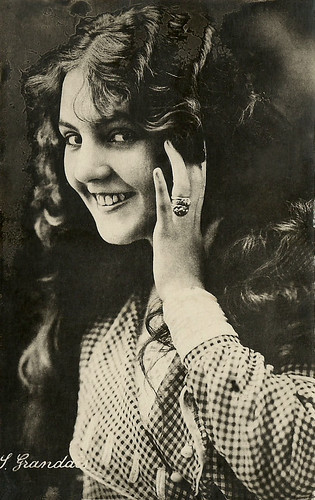
Vintage postcard. Collection: Didier Hanson.
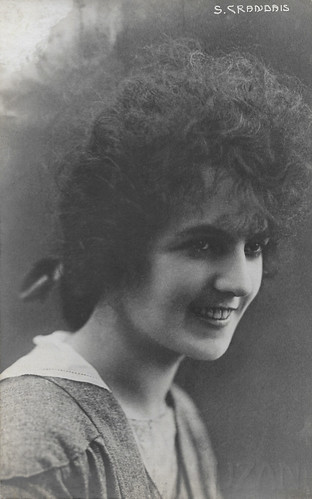
French postcard.
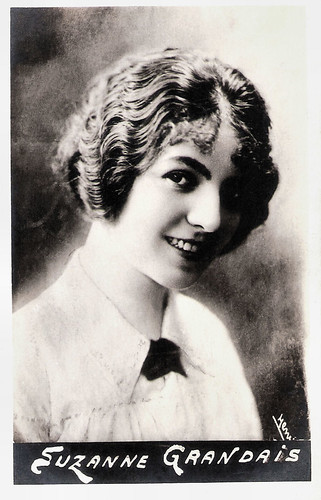
Spanish postcard.
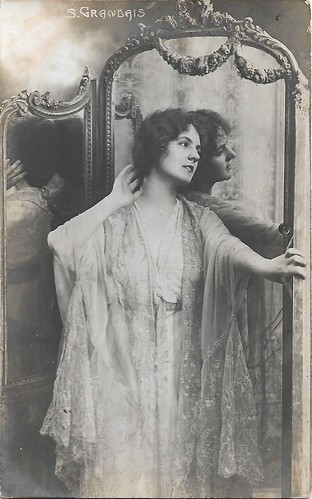
British postcard by K Ltd.
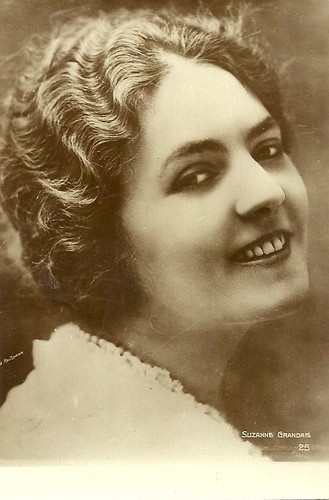
French postcard by Editions Cinémagazine, no. 25. Photo: Reutlinger.
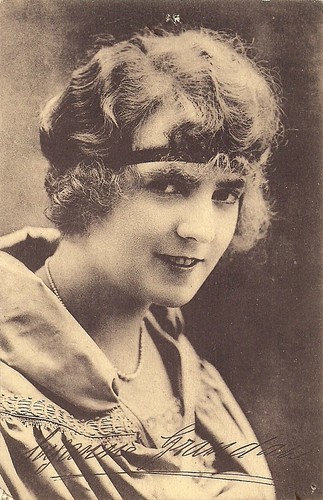
Possibly a French postcard, but editor unknown.
Louis Feuillade
Suzanne Grandais was born as Suzanne Gueudret in Paris, France in 1893.
At the age of 15, she already started to work as a dancer. Her first stage appearance was in Le Château Des Loufoques (The Castle of Loufoques) by Benjamin Rabier at the Théâtre de Cluny.
After a tour through South America, she played some parts in short silent films for the Lux and Eclair companies. Then she was discovered by pioneer director Louis Feuillade who hired her for Gaumont. Wikipedia (English) however suggests it was director Leonce Perret who discovered her at the Moulin Rouge.
From 1911 till 1913, Grandais made some 45 films for Gaumont, mostly short comedies and dramas. First she appeared in Feuillade's series Scènes de la vie telle qu'elle est/Life As It Is. In his Encyclopedia of Early Cinema, Richard Abel writes that these films were marked by her 'sober, restrained acting'.
Later Grandais often played Léonce Perret's wife or temptress in the Léonce series, elegant comedies starring and directed by Perret. She also appeared in such feature-length adventure melodramas as Le Mystère des roches de Kador/The Mystery of the Rocks of Kador (Léonce Perret, 1912).
In 1913-1914, Grandais switched to the German Dekage company (Deutsche Kinematograph Gesellschaft), for which she did another 18 films, directed by Marcel Robert and Charles Decroix. Then she founded her own film company with Raoul d'Archy, Les Films Suzanne Grandais.
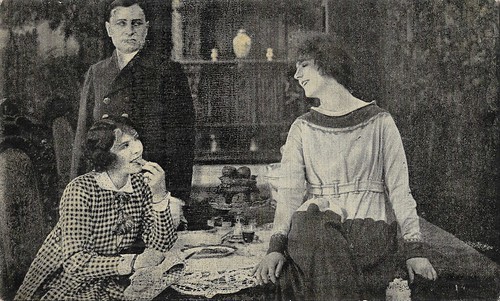
Spanish collectors card by Amatller Marca Luna chocolate, series 3, no. 10. Photo: Eclipse. Suzanne Grandais, Jane Danjou and Marcel Marquet in Midinettes (René Hervil, Louis Mercanton, 1917).
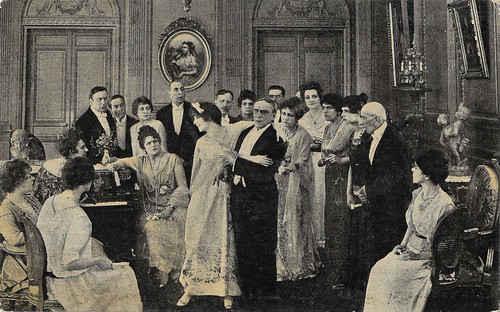
Spanish collectors card by Amatller Marca Luna chocolate, series 3, no. 11. Photo: Eclipse. Suzanne Grandais and Anthony Gildès in Midinettes (René Hervil, Louis Mercanton, 1917).
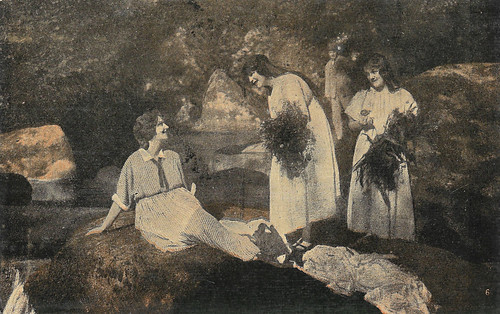
Spanish postcard by Amatller Marca Luna, series 6, no. 3. Photo: Eclipse. Suzanne Grandais in Lorena (Georges Tréville, 1918).
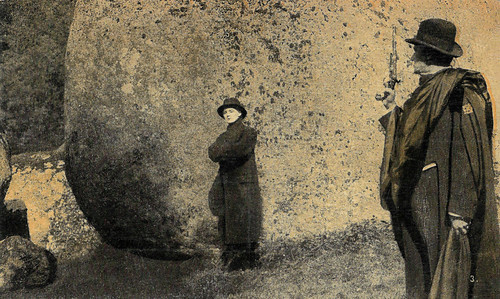
Spanish postcard by Amatller Marca Luna, series 6, no. 10. Photo: Eclipse. Suzanne Grandais and Jean Aymé in Lorena (Georges Tréville, 1918).
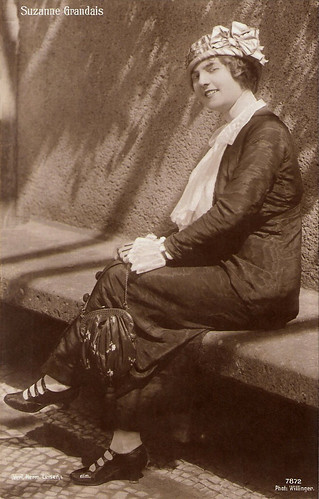
German postcard by Verleih Hermann Leiser, no. 7872. Photo: Willinger.
Car Crash
During the First World War, Suzanne Grandais also worked at Eclipse. The drama Suzanne (René Hervil, Louis Mercanton, 1916) was a major international success and turned Grandais into a star. French women started to notice that she always wore the latest fashions.
The great film critic Louis Delluc compared her to American serial queen Pearl White in the journal Paris-Midi in 1918. In 2005, Richard Abel called her 'arguably the most popular French actress of the early 1910's': "Grandais was equally adept at playing subtly pathetic figures, deceptive partners in crime, or witty wives who deftly outsmarted their husbands".
On Saturday 28 August 1920, Suzanne Grandais was killed while making the film serial L'Essor/The Rise (Charles Burguet, 1921) in the Alsace. She was only 27, when she died in a car crash between Sézanne and Coulommiers. Cameraman Marcel Ruette was also killed. Director Charles Burguet and his wife were in the back of the same car, but both survived. The accident happened during the shooting of the film, and the ending of the film had to be changed.
In 2009, Gallimard published a book on Grandais Un amour sans paroles (A Love Without Words), written by Didier Blonde. The author mentioned that he could see only one film of her. Most of Suzanne Grandais' more than 60 films are considered lost. But there's good news for him: several of her films have been saved by Eye Filmmuseum in Amsterdam.
Most of these films are short comedies and dramas, often directed by Léonce Perret, from her early years at Gaumont. These include Graziella la Gitane/Graziella the Gypsy (Léonce Perret, 1912), Le homard/Lobsters: All Styles (Léonce Perret, 1913), and L'obsession du souvenir/The Obsession of a Souvenir (1913). The films are preserved with beautiful tinted and stencil-colored colours. Eye also owns some feature films with Suzanne Grandais such as Le mystère des Roches de Kador/The Mystery of the Rocks of Kador (Léonce Perret, 1912).
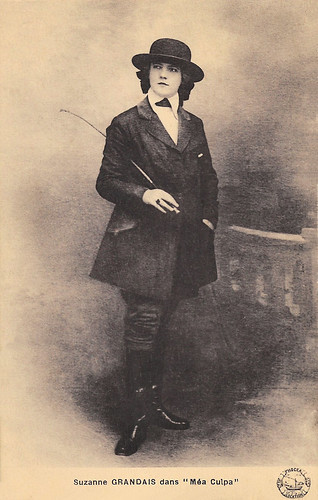
French postcard. Photo: Phocea Films. Suzanne Grandais in Méa Culpa (Georges Champavert, 1919).
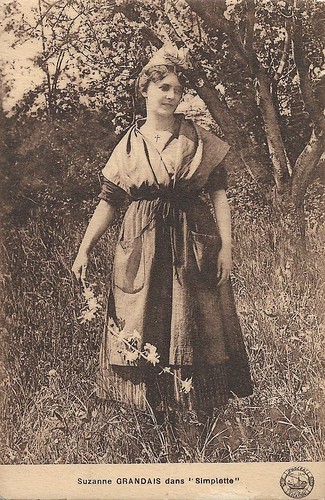
French postcard. Photo: Phocéa Film. Suzanne Grandais in the tile role of Simplette (René Hervil, 1919).
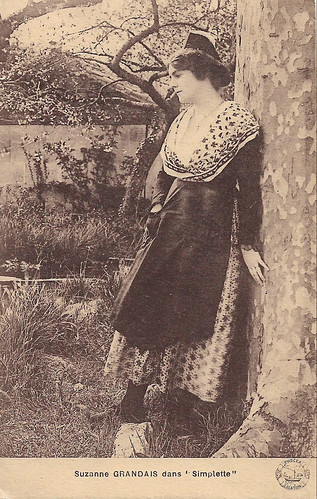
French postcard. Photo: Phocéa Film. Suzanne Grandais in Simplette (René Hervil, 1919).
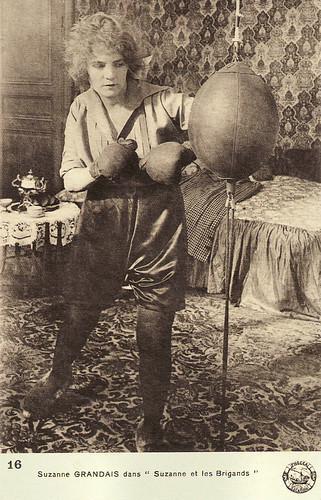
French postcard by Phocéa-Film, no. 16. Photo: Phocéa-Film. Suzanne Grandais in Suzanne et les Brigands/Suzanne and the Brigands (Charles Burguet, 1920).
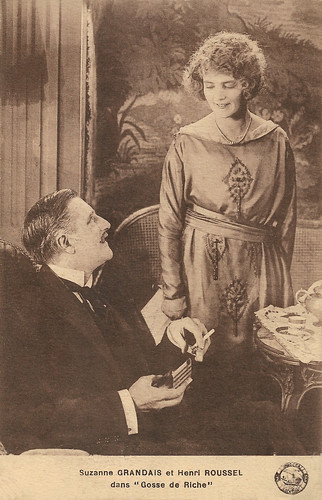
French postcard. Photo: Phocéa-Film. Suzanne Grandais and Henry Roussel in Gosse de riche/Rich Kid (Charles Burguet, 1920).
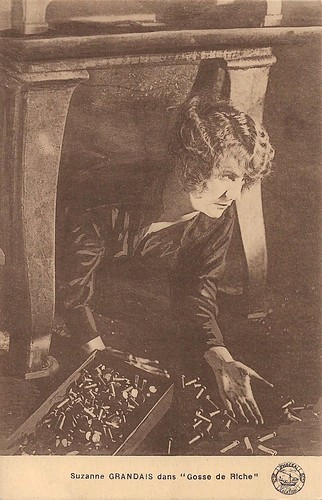
French postcard. Photo: Phocéa-Film. Suzanne Grandais in Gosse de riche/Rich Kid (Charles Burguet, 1920).
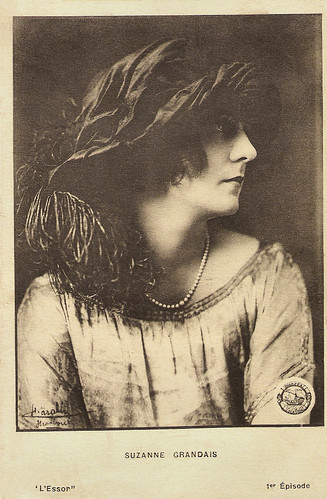
French postcard. Photo: Sciarabin, Strasbourg / Phocea Films. Suzanne Grandais in L'essor/The rise (Charles Burguet, 1920), 1st episode.
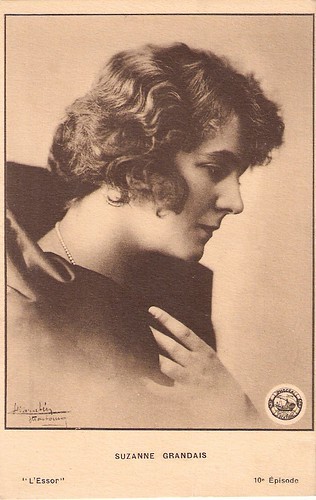
French postcard by Phocea-Films. This card was made for the 10th (and final) episode of the serial L'Essor/The Rise (Charles Burguet, 1921). Photo: Sciarabin, Strasbourg.
Sources: Richard Abel (Encyclopedia of Early Cinema), Alberto Blanco (Find A Grave), Gallimard, Wikipedia (French and English), and .

Vintage postcard. Collection: Didier Hanson.

French postcard.

Spanish postcard.

British postcard by K Ltd.

French postcard by Editions Cinémagazine, no. 25. Photo: Reutlinger.

Possibly a French postcard, but editor unknown.
Louis Feuillade
Suzanne Grandais was born as Suzanne Gueudret in Paris, France in 1893.
At the age of 15, she already started to work as a dancer. Her first stage appearance was in Le Château Des Loufoques (The Castle of Loufoques) by Benjamin Rabier at the Théâtre de Cluny.
After a tour through South America, she played some parts in short silent films for the Lux and Eclair companies. Then she was discovered by pioneer director Louis Feuillade who hired her for Gaumont. Wikipedia (English) however suggests it was director Leonce Perret who discovered her at the Moulin Rouge.
From 1911 till 1913, Grandais made some 45 films for Gaumont, mostly short comedies and dramas. First she appeared in Feuillade's series Scènes de la vie telle qu'elle est/Life As It Is. In his Encyclopedia of Early Cinema, Richard Abel writes that these films were marked by her 'sober, restrained acting'.
Later Grandais often played Léonce Perret's wife or temptress in the Léonce series, elegant comedies starring and directed by Perret. She also appeared in such feature-length adventure melodramas as Le Mystère des roches de Kador/The Mystery of the Rocks of Kador (Léonce Perret, 1912).
In 1913-1914, Grandais switched to the German Dekage company (Deutsche Kinematograph Gesellschaft), for which she did another 18 films, directed by Marcel Robert and Charles Decroix. Then she founded her own film company with Raoul d'Archy, Les Films Suzanne Grandais.

Spanish collectors card by Amatller Marca Luna chocolate, series 3, no. 10. Photo: Eclipse. Suzanne Grandais, Jane Danjou and Marcel Marquet in Midinettes (René Hervil, Louis Mercanton, 1917).

Spanish collectors card by Amatller Marca Luna chocolate, series 3, no. 11. Photo: Eclipse. Suzanne Grandais and Anthony Gildès in Midinettes (René Hervil, Louis Mercanton, 1917).

Spanish postcard by Amatller Marca Luna, series 6, no. 3. Photo: Eclipse. Suzanne Grandais in Lorena (Georges Tréville, 1918).

Spanish postcard by Amatller Marca Luna, series 6, no. 10. Photo: Eclipse. Suzanne Grandais and Jean Aymé in Lorena (Georges Tréville, 1918).

German postcard by Verleih Hermann Leiser, no. 7872. Photo: Willinger.
Car Crash
During the First World War, Suzanne Grandais also worked at Eclipse. The drama Suzanne (René Hervil, Louis Mercanton, 1916) was a major international success and turned Grandais into a star. French women started to notice that she always wore the latest fashions.
The great film critic Louis Delluc compared her to American serial queen Pearl White in the journal Paris-Midi in 1918. In 2005, Richard Abel called her 'arguably the most popular French actress of the early 1910's': "Grandais was equally adept at playing subtly pathetic figures, deceptive partners in crime, or witty wives who deftly outsmarted their husbands".
On Saturday 28 August 1920, Suzanne Grandais was killed while making the film serial L'Essor/The Rise (Charles Burguet, 1921) in the Alsace. She was only 27, when she died in a car crash between Sézanne and Coulommiers. Cameraman Marcel Ruette was also killed. Director Charles Burguet and his wife were in the back of the same car, but both survived. The accident happened during the shooting of the film, and the ending of the film had to be changed.
In 2009, Gallimard published a book on Grandais Un amour sans paroles (A Love Without Words), written by Didier Blonde. The author mentioned that he could see only one film of her. Most of Suzanne Grandais' more than 60 films are considered lost. But there's good news for him: several of her films have been saved by Eye Filmmuseum in Amsterdam.
Most of these films are short comedies and dramas, often directed by Léonce Perret, from her early years at Gaumont. These include Graziella la Gitane/Graziella the Gypsy (Léonce Perret, 1912), Le homard/Lobsters: All Styles (Léonce Perret, 1913), and L'obsession du souvenir/The Obsession of a Souvenir (1913). The films are preserved with beautiful tinted and stencil-colored colours. Eye also owns some feature films with Suzanne Grandais such as Le mystère des Roches de Kador/The Mystery of the Rocks of Kador (Léonce Perret, 1912).

French postcard. Photo: Phocea Films. Suzanne Grandais in Méa Culpa (Georges Champavert, 1919).

French postcard. Photo: Phocéa Film. Suzanne Grandais in the tile role of Simplette (René Hervil, 1919).

French postcard. Photo: Phocéa Film. Suzanne Grandais in Simplette (René Hervil, 1919).

French postcard by Phocéa-Film, no. 16. Photo: Phocéa-Film. Suzanne Grandais in Suzanne et les Brigands/Suzanne and the Brigands (Charles Burguet, 1920).

French postcard. Photo: Phocéa-Film. Suzanne Grandais and Henry Roussel in Gosse de riche/Rich Kid (Charles Burguet, 1920).

French postcard. Photo: Phocéa-Film. Suzanne Grandais in Gosse de riche/Rich Kid (Charles Burguet, 1920).

French postcard. Photo: Sciarabin, Strasbourg / Phocea Films. Suzanne Grandais in L'essor/The rise (Charles Burguet, 1920), 1st episode.

French postcard by Phocea-Films. This card was made for the 10th (and final) episode of the serial L'Essor/The Rise (Charles Burguet, 1921). Photo: Sciarabin, Strasbourg.
Sources: Richard Abel (Encyclopedia of Early Cinema), Alberto Blanco (Find A Grave), Gallimard, Wikipedia (French and English), and .
Published on October 08, 2019 22:00
October 7, 2019
William S. Hart
Till Saturday 12 October EFSP follows Le Giornate del Cinema Muto in Pordenone. The subject of one of the retrospectives of this year's festival is William S. Hart (1864–1946), the foremost Western star of the silent era. He entered films in 1914 and achieved stardom as the lead in The Bargain (Reginald Barker, 1914). Hart was particularly interested in making realistic Westerns, and his films are noted for their authentic costumes and props. Hart also had an extraordinary acting ability, honed on Shakespearean theatre stages in the United States and England.
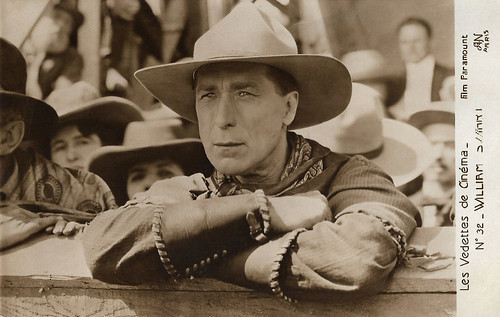
French postcard by A.N. in the Les vedettes de cinéma series, Paris, no. 32. Photo: Film Paramount.
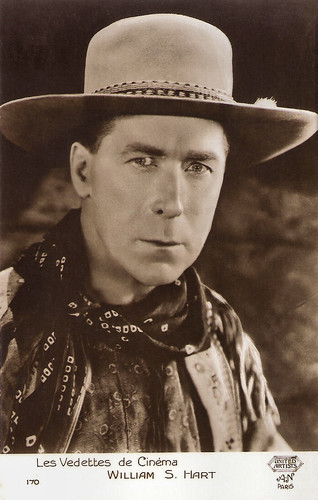
French postcard by A.N. in the Les vedettes de cinéma series, Paris, no. 170. Photo: Film United Artists.
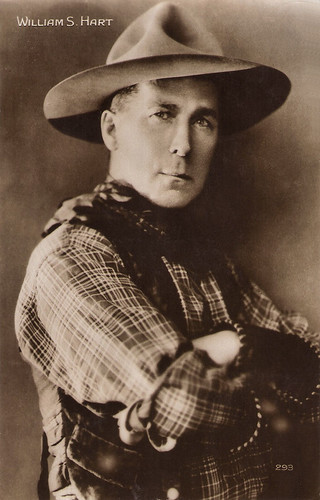
French postcard by Cinémagazine-Edition, Paris, no. 293.
Eager to conquer the new medium film
William Surrey Hart was in 1864 in Newburgh, New York. His parents were Nicholas Hart and Rosanna Hart, and he was a distant cousin of the Western star Neal Hart.
His father later worked as an itinerant mill hand in remote sections of Illinois, Iowa, Minnesota, and Wisconsin. Bill grew up in unsettled areas with few white settlers, playing with Sioux children. He learned some of their words and also became adept at Indian sign language.
Hart lived for a while in the Dakota Territory, then worked as a postal clerk in New York City. In 1888 he began to study acting.
He toured and travelled extensively while trying to make a name for himself as an actor, and for a time directed shows at the Asheville Opera House in North Carolina, around the year 1900. He had some success as a Shakespearean actor on Broadway, working with Margaret Mather and other stars.
In 1899 he created the role of Messala in 'Ben-Hur', and later appeared uncredited in an early silent film version, Ben Hur (Sidney Olcott, Frank Oakes Rose, 1907) with Gene Gauntier. That same year, he received excellent reviews for his lead part in the stage version of 'The Virginian' (1907). In the following years, Hart established himself as one of the top interpreters of Western roles on stage.
Hart was eager to conquer the new medium film. After playing supporting roles in two short films, including His Hour of Manhood (Tom Chatterton, 1914). he achieved stardom as a bank robber in the Western The Bargain (Reginald Barker, 1914). He regarded this feature as his true film debut. He was 49 at the time.
W Morrow at IMDb : "The opening credit sequence certainly underscores the sense of a new career for the leading man: all the major players, starting with Hart, are first seen in formal contemporary attire, standing before a stage curtain. As each actor bows low, a cross-fade occurs, and he or she rises in the character makeup and costume they will wear in the film. It's a charming device, and one that serves as a perfect metaphor for this important juncture in Hart's career."
In 1915 William S. Hart signed a contract with Thomas H. Ince and joined Ince's Triangle Film Company. Hart starred in his own series of two-reel western short subjects, which were so popular that they were supplanted by a series of feature films. Many of Hart's early films continued to play in theatres, under new titles, for another decade. In 1915 and 1916 exhibitors voted him the biggest money making star in the United States.
In 1917, he followed Ince to to join Famous Players-Lasky, which merged into Paramount Pictures, and received a very lucrative contract from Adolph Zukor. In the films Hart began to ride a brown and white pinto he called Fritz, the forerunner of later famous movie horses known by their own name. Hart was making feature films like Square Deal Sanderson (William S. Hart, Lambert Hillyer, 1919) and The Toll Gate (Lambert Hillyer, 1920) with Anna Q. Nillson , which were popular with fans.
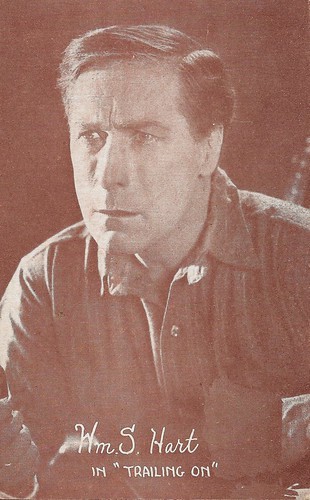
American postcard. IMDb does not list a film with this title, closest match is Travelin'on (Lambert Hillyer, 1922), produced by William S. Hart Productions, and distributed by Paramount.
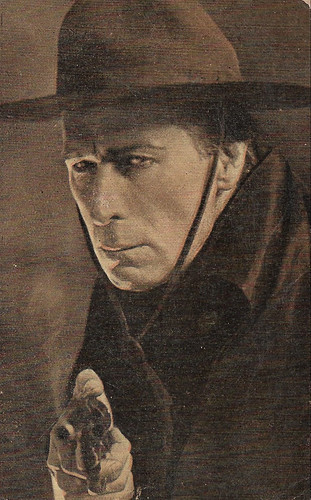
Spanish postcard by Amattler Marca Luna chocolate, series 11, no. 15.
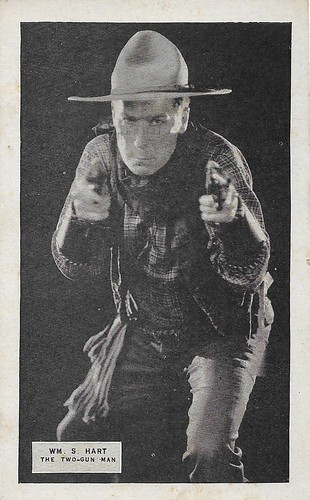
Vintage postcard with unknown nationality and editor (US?). William Hart was known as 'The Two-Gun Man'.
A story book hero or a bully?
During the late 1910s and early 1920s, Willam S. Hart was one of the most consistently popular movie stars, frequently ranking high among male actors in popularity contests held by movie fan magazines. At IMDb , Ed Stephan describes William S. Hart as "A storybook hero, the original screen cowboy, ever forthright and honest, even when (as was often the case) he played a villain."
From 1920 till 1925, he was the owner of his own film company, William S. Hart Productions (1920-1925) aka The William S. Hart Co. William S. Hart's career began to dwindle in the early 1920s due to the publicity surrounding a paternity suit against him, which was eventually dismissed.
In 1921, Roscoe 'Fatty'Arbuckle was charged with the rape and manslaughter of aspiring actress Virginia Rappe. The case had many salacious aspects particularly surrounding the sexual injuries found on the victim's body. Many of Arbuckle's fellow actors refused to give any comments to the press. However, Hart who had never met or worked with Arbuckle, made a number of damaging public statements in which he presumed the actor's guilt.
Arbuckle later wrote a premise for a film parodying Hart as a thief, bully, and wife beater, which was bought by Buster Keaton . The following year, Keaton co-wrote, directed and starred in the comedy film The Frozen North (1922). As a result, Hart, refused to speak to Keaton for many years.
By that time, Hart's brand of gritty, rugged Westerns with drab costumes and moralistic themes gradually fell out of fashion. The public became attracted by a new kind of movie cowboy, epitomised by Tom Mix, who wore flashier costumes and was faster with the action. Paramount dropped Hart.
He made his last film, Tumbleweeds (King Baggott, 1925), for United Artists and retired to a ranch in Newhall, California. While living in semi-retirement in Newhall, he was disturbed by a plane which kept flying over his house. The plane was being piloted by Amelia Earhart, and they ended up becoming good friends after he invited her to dinner in order to complain about the noise her plane was making.
By that time audiences were more interested in the antics of a Tom Mix or Hoot Gibson than the Victorian moralising of Hart. Hart was a friend of legendary wild west lawman Wyatt Earp, and along with Tom Mix, he was a pallbearer at Earp's funeral in 1929.
William S. Hart died in 1946 in Newhall, and is buried in Greenwood Cemetery, NY. He was married to actress Winifred Westover from 1921 till their divorce in 1927. They had one child, William S. Hart, Jr. (1922–2004).
He donated his estate to the City of Los Angeles, on the condition they install a fountain and use the park for the arts. Today, the internationally renowned Actors Studio has its West Coast branch at the William S. Hart Park, in West Hollywood, in Hart's old estate. His mansion in Newhall, California, is now a museum and has been preserved with its original fixtures and furnishings intact.
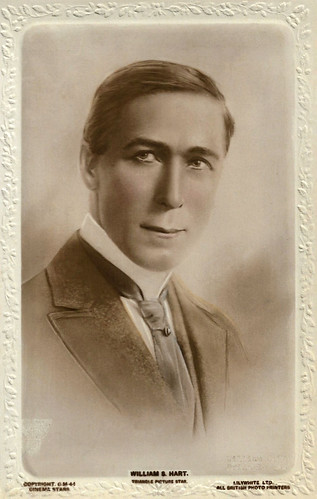
British postcard in the Cinema Stars series by Lilywhite Ltd., no. CM 44. Photo: Triangle Pictures.
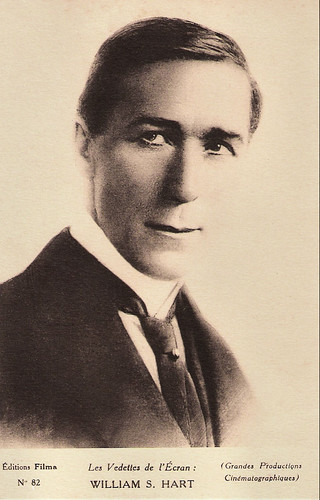
French postcard by Éditions Filma in the Les Vedettes de l'Écran series, no. 82. Photo: Grandes Productions Cinématographiques.
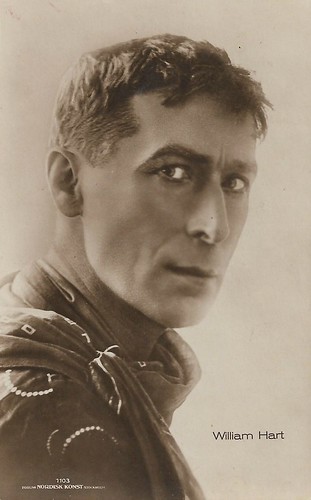
Swedish postcard by Forlag Nordisk Konst, Stockholm, no. 1103.
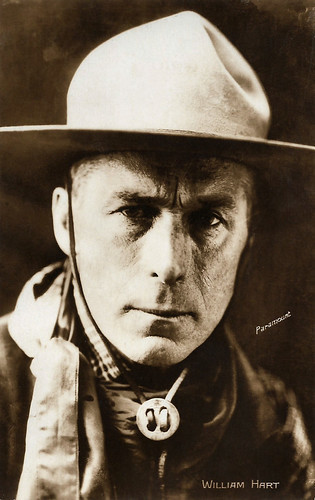
French postcard by Editions Cinémagazine. Photo: Paramount.
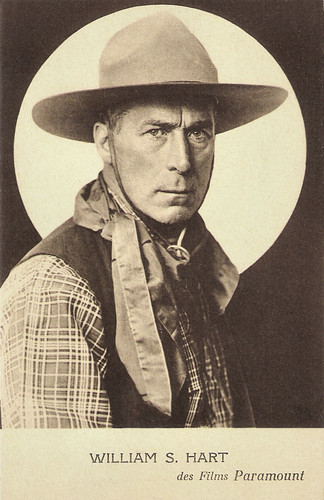
French postcard by Edition Paramount, Paris.
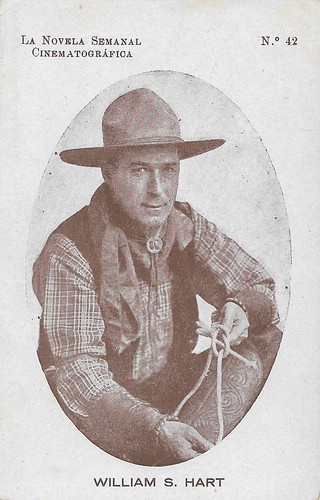
Spanish postcard by La Novela Semanal, no. 42.
Sources:

French postcard by A.N. in the Les vedettes de cinéma series, Paris, no. 32. Photo: Film Paramount.

French postcard by A.N. in the Les vedettes de cinéma series, Paris, no. 170. Photo: Film United Artists.

French postcard by Cinémagazine-Edition, Paris, no. 293.
Eager to conquer the new medium film
William Surrey Hart was in 1864 in Newburgh, New York. His parents were Nicholas Hart and Rosanna Hart, and he was a distant cousin of the Western star Neal Hart.
His father later worked as an itinerant mill hand in remote sections of Illinois, Iowa, Minnesota, and Wisconsin. Bill grew up in unsettled areas with few white settlers, playing with Sioux children. He learned some of their words and also became adept at Indian sign language.
Hart lived for a while in the Dakota Territory, then worked as a postal clerk in New York City. In 1888 he began to study acting.
He toured and travelled extensively while trying to make a name for himself as an actor, and for a time directed shows at the Asheville Opera House in North Carolina, around the year 1900. He had some success as a Shakespearean actor on Broadway, working with Margaret Mather and other stars.
In 1899 he created the role of Messala in 'Ben-Hur', and later appeared uncredited in an early silent film version, Ben Hur (Sidney Olcott, Frank Oakes Rose, 1907) with Gene Gauntier. That same year, he received excellent reviews for his lead part in the stage version of 'The Virginian' (1907). In the following years, Hart established himself as one of the top interpreters of Western roles on stage.
Hart was eager to conquer the new medium film. After playing supporting roles in two short films, including His Hour of Manhood (Tom Chatterton, 1914). he achieved stardom as a bank robber in the Western The Bargain (Reginald Barker, 1914). He regarded this feature as his true film debut. He was 49 at the time.
W Morrow at IMDb : "The opening credit sequence certainly underscores the sense of a new career for the leading man: all the major players, starting with Hart, are first seen in formal contemporary attire, standing before a stage curtain. As each actor bows low, a cross-fade occurs, and he or she rises in the character makeup and costume they will wear in the film. It's a charming device, and one that serves as a perfect metaphor for this important juncture in Hart's career."
In 1915 William S. Hart signed a contract with Thomas H. Ince and joined Ince's Triangle Film Company. Hart starred in his own series of two-reel western short subjects, which were so popular that they were supplanted by a series of feature films. Many of Hart's early films continued to play in theatres, under new titles, for another decade. In 1915 and 1916 exhibitors voted him the biggest money making star in the United States.
In 1917, he followed Ince to to join Famous Players-Lasky, which merged into Paramount Pictures, and received a very lucrative contract from Adolph Zukor. In the films Hart began to ride a brown and white pinto he called Fritz, the forerunner of later famous movie horses known by their own name. Hart was making feature films like Square Deal Sanderson (William S. Hart, Lambert Hillyer, 1919) and The Toll Gate (Lambert Hillyer, 1920) with Anna Q. Nillson , which were popular with fans.

American postcard. IMDb does not list a film with this title, closest match is Travelin'on (Lambert Hillyer, 1922), produced by William S. Hart Productions, and distributed by Paramount.

Spanish postcard by Amattler Marca Luna chocolate, series 11, no. 15.

Vintage postcard with unknown nationality and editor (US?). William Hart was known as 'The Two-Gun Man'.
A story book hero or a bully?
During the late 1910s and early 1920s, Willam S. Hart was one of the most consistently popular movie stars, frequently ranking high among male actors in popularity contests held by movie fan magazines. At IMDb , Ed Stephan describes William S. Hart as "A storybook hero, the original screen cowboy, ever forthright and honest, even when (as was often the case) he played a villain."
From 1920 till 1925, he was the owner of his own film company, William S. Hart Productions (1920-1925) aka The William S. Hart Co. William S. Hart's career began to dwindle in the early 1920s due to the publicity surrounding a paternity suit against him, which was eventually dismissed.
In 1921, Roscoe 'Fatty'Arbuckle was charged with the rape and manslaughter of aspiring actress Virginia Rappe. The case had many salacious aspects particularly surrounding the sexual injuries found on the victim's body. Many of Arbuckle's fellow actors refused to give any comments to the press. However, Hart who had never met or worked with Arbuckle, made a number of damaging public statements in which he presumed the actor's guilt.
Arbuckle later wrote a premise for a film parodying Hart as a thief, bully, and wife beater, which was bought by Buster Keaton . The following year, Keaton co-wrote, directed and starred in the comedy film The Frozen North (1922). As a result, Hart, refused to speak to Keaton for many years.
By that time, Hart's brand of gritty, rugged Westerns with drab costumes and moralistic themes gradually fell out of fashion. The public became attracted by a new kind of movie cowboy, epitomised by Tom Mix, who wore flashier costumes and was faster with the action. Paramount dropped Hart.
He made his last film, Tumbleweeds (King Baggott, 1925), for United Artists and retired to a ranch in Newhall, California. While living in semi-retirement in Newhall, he was disturbed by a plane which kept flying over his house. The plane was being piloted by Amelia Earhart, and they ended up becoming good friends after he invited her to dinner in order to complain about the noise her plane was making.
By that time audiences were more interested in the antics of a Tom Mix or Hoot Gibson than the Victorian moralising of Hart. Hart was a friend of legendary wild west lawman Wyatt Earp, and along with Tom Mix, he was a pallbearer at Earp's funeral in 1929.
William S. Hart died in 1946 in Newhall, and is buried in Greenwood Cemetery, NY. He was married to actress Winifred Westover from 1921 till their divorce in 1927. They had one child, William S. Hart, Jr. (1922–2004).
He donated his estate to the City of Los Angeles, on the condition they install a fountain and use the park for the arts. Today, the internationally renowned Actors Studio has its West Coast branch at the William S. Hart Park, in West Hollywood, in Hart's old estate. His mansion in Newhall, California, is now a museum and has been preserved with its original fixtures and furnishings intact.

British postcard in the Cinema Stars series by Lilywhite Ltd., no. CM 44. Photo: Triangle Pictures.

French postcard by Éditions Filma in the Les Vedettes de l'Écran series, no. 82. Photo: Grandes Productions Cinématographiques.

Swedish postcard by Forlag Nordisk Konst, Stockholm, no. 1103.

French postcard by Editions Cinémagazine. Photo: Paramount.

French postcard by Edition Paramount, Paris.

Spanish postcard by La Novela Semanal, no. 42.
Sources:
Published on October 07, 2019 22:30
October 6, 2019
The Origins of European Slapstick
Till Saturday 12 October EFSP follows Le Giornate del Cinema Muto. The Silent Film Festival in Pordenone is the main festival in its kind and this year's edition is the 38th. Yesterday we had a post on the early comedies with 'Nasty women', and today the men follow. The programme 'The Origins of European Slapstick' presents comedies with 'Euro-clowns' like Max Linder, Walter Forde, Grock, Karl Valentin, Charles Puffy and the Scandinavian duo Pat & Patachon (or Fi og By), amd EFSP presents their postcards.
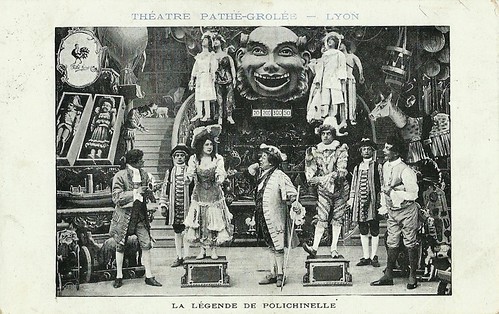
French postcard by Théâtre Pathé Grolée, Lyon. Photo: Pathé Frères. Max Linder as Polichinelle in La légende de Polichinelle (Albert Capellani, 1907).
Polichinelle is an automaton in love with a cute doll in the same shop. When the doll is sold, a fairy helps Polichinelle to follow her. After a series of wild adventures he arrives at the house of the buyer just in time to save the doll from being burned.
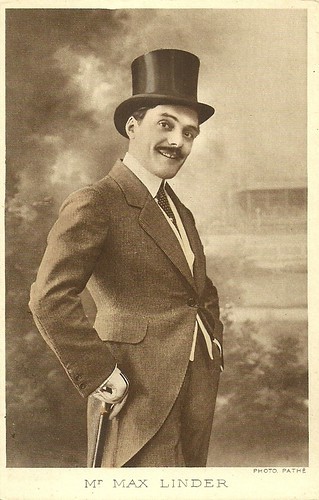
French postcard. Photo: Pathé.
French comedian Max Linder (1883-1925), with his trademark silk hat, stick and moustache was an influential pioneer of the silent film. He was largely responsible for the creation of the classic style of silent slapstick comedy and he was the highest paid entertainer of his day.
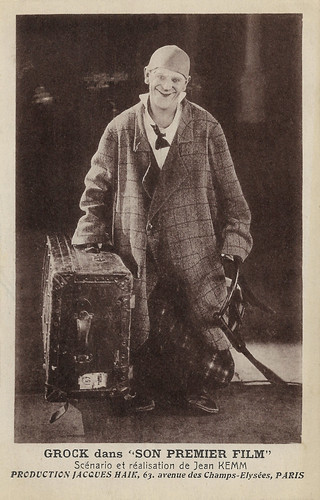
French postcard by J. Combier, Macon. Photo: Production Jacques Haik. Grock in Son premier film (Jean Kemm, 1926).
Grock (1880-1959) was a Swiss clown, composer and musician. 'The king of clowns' was once the most highly paid entertainer in the world. His act was a mixture of pantomime and musical blunders. Some of Grock's performances have been preserved on film such as in the silent film Son premier film/What For? (Jean Kemm, 1926).
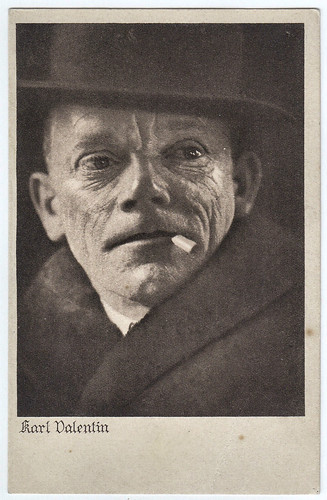
German postcard by Heliogravüre J.B. Obernetter, München. Collection: Marlene Pilaete.
Bavarian comedian Karl Valentin (1882-1948) starred in many silent German films in the 1920s. Valentin was also active as a cabaret performer, clown, author and film producer, and was sometimes called the 'Charlie Chaplin of Germany'. His work influenced artists like Bertolt Brecht and Samuel Beckett.
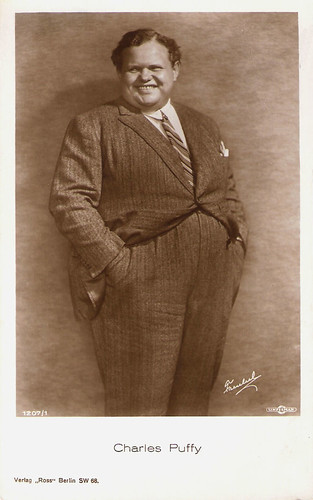
German postcard by Ross Verlag, no. 1207/1, 1927-1928. Photo: Roman Freulich / Unfilman (Universal).
Fat Hungarian stage and film comedian Károly Huszár (1884–1942 or 1943) or Charles (Huszar-)Puffy or Karl Huszar-Puffy was the most popular slapstick star of the Hungarian silent era. He later worked in both Germany and Hollywood. He played minor roles in such classics as Dr. Mabuse, der Spieler/Dr. Mabuse, King of Crime (1922) and he was the star of a series of slapstick shorts for Universal.
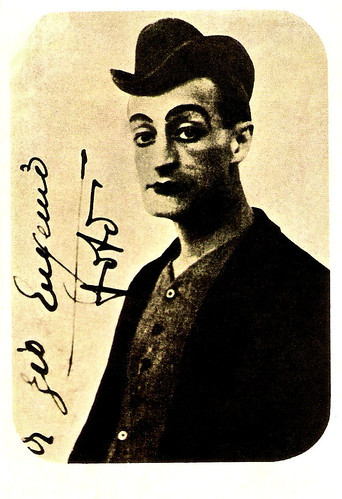
Italian postcard by Il Piùlibri. Photo: youth portrait of Antonio De Curtis (Totò) with dedication.
Totò (1898–1967) was one of the most popular Italian film stars ever, nicknamed 'il principe della risata' (the prince of laughter). He starred in about 100 films, many of which are still frequently broadcast on Italian television. Totò is an heir of the Commedia dell'Arte tradition, and can be compared to Buster Keaton and Charlie Chaplin . His style and some of his recurring jokes and gestures are universally known in Italy.
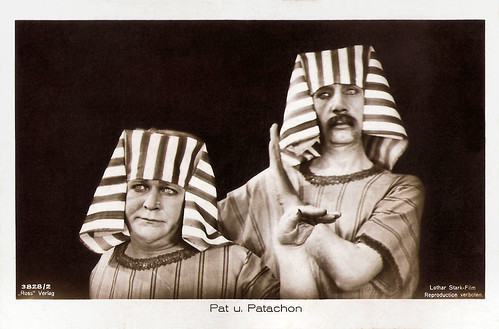
German postcard by Ross Verlag, no. 3828/2, 1928-1929. Photo: Lothar Stark-Film. Fy og Bi in Filmens Helte/Long and Short, the film heroes (Lau Lauritzen, 1928), produced by the Danish studio Palladium.
The Danish double-act Fy og Bi (Fyrtårnet og Bivognen aka Pat & Patachon or Long and Short) was the most famous comedy couple of the European silent cinema. Long Carl Schenstrom (1881-1942) and short Harald Madsen (1890-1949) became very popular in the 1920s with their short slapstick films.
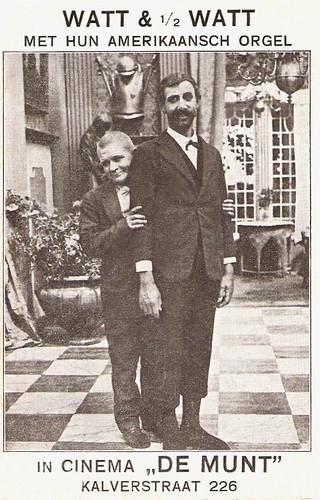
Dutch postcard for the Danish comedians Fy og Bi , that is long Carl Schenstrom (1881-1942) and short Harald Madsen (1890-1949). They were called 'Watt & Half Watt' in the Netherlands (Long and Short in Britain, Pat und Patachon in Germany). The Dutch cinema De Munt, Kalverstraat 226, Amsterdam, was at the time the cinema for their films in Amsterdam.

French postcard by Théâtre Pathé Grolée, Lyon. Photo: Pathé Frères. Max Linder as Polichinelle in La légende de Polichinelle (Albert Capellani, 1907).
Polichinelle is an automaton in love with a cute doll in the same shop. When the doll is sold, a fairy helps Polichinelle to follow her. After a series of wild adventures he arrives at the house of the buyer just in time to save the doll from being burned.

French postcard. Photo: Pathé.
French comedian Max Linder (1883-1925), with his trademark silk hat, stick and moustache was an influential pioneer of the silent film. He was largely responsible for the creation of the classic style of silent slapstick comedy and he was the highest paid entertainer of his day.

French postcard by J. Combier, Macon. Photo: Production Jacques Haik. Grock in Son premier film (Jean Kemm, 1926).
Grock (1880-1959) was a Swiss clown, composer and musician. 'The king of clowns' was once the most highly paid entertainer in the world. His act was a mixture of pantomime and musical blunders. Some of Grock's performances have been preserved on film such as in the silent film Son premier film/What For? (Jean Kemm, 1926).

German postcard by Heliogravüre J.B. Obernetter, München. Collection: Marlene Pilaete.
Bavarian comedian Karl Valentin (1882-1948) starred in many silent German films in the 1920s. Valentin was also active as a cabaret performer, clown, author and film producer, and was sometimes called the 'Charlie Chaplin of Germany'. His work influenced artists like Bertolt Brecht and Samuel Beckett.

German postcard by Ross Verlag, no. 1207/1, 1927-1928. Photo: Roman Freulich / Unfilman (Universal).
Fat Hungarian stage and film comedian Károly Huszár (1884–1942 or 1943) or Charles (Huszar-)Puffy or Karl Huszar-Puffy was the most popular slapstick star of the Hungarian silent era. He later worked in both Germany and Hollywood. He played minor roles in such classics as Dr. Mabuse, der Spieler/Dr. Mabuse, King of Crime (1922) and he was the star of a series of slapstick shorts for Universal.

Italian postcard by Il Piùlibri. Photo: youth portrait of Antonio De Curtis (Totò) with dedication.
Totò (1898–1967) was one of the most popular Italian film stars ever, nicknamed 'il principe della risata' (the prince of laughter). He starred in about 100 films, many of which are still frequently broadcast on Italian television. Totò is an heir of the Commedia dell'Arte tradition, and can be compared to Buster Keaton and Charlie Chaplin . His style and some of his recurring jokes and gestures are universally known in Italy.

German postcard by Ross Verlag, no. 3828/2, 1928-1929. Photo: Lothar Stark-Film. Fy og Bi in Filmens Helte/Long and Short, the film heroes (Lau Lauritzen, 1928), produced by the Danish studio Palladium.
The Danish double-act Fy og Bi (Fyrtårnet og Bivognen aka Pat & Patachon or Long and Short) was the most famous comedy couple of the European silent cinema. Long Carl Schenstrom (1881-1942) and short Harald Madsen (1890-1949) became very popular in the 1920s with their short slapstick films.

Dutch postcard for the Danish comedians Fy og Bi , that is long Carl Schenstrom (1881-1942) and short Harald Madsen (1890-1949). They were called 'Watt & Half Watt' in the Netherlands (Long and Short in Britain, Pat und Patachon in Germany). The Dutch cinema De Munt, Kalverstraat 226, Amsterdam, was at the time the cinema for their films in Amsterdam.
Published on October 06, 2019 22:00
October 5, 2019
Nasty women
Since yesterday, EFSP follows Le Giornate del Cinema Muto again - till Saturday 12 October. The Silent Film Festival in Pordenone is the main festival of its kind and this year's edition is the 38th. And yes, the 'Nasty women' will return! In 2017, Maggie Hennefeld and Laura Horak presented a retrospective full of subversive pleasures. Again, the series features shorts made largely in the 1910s and earlier, showcasing strong-minded women and girls delighting in wreaking havoc and upending the rules of patriarchal power. For this post we selected five cards from our Pathé album from 1911. If the short comedies of these three nasty women are on show in Pordenone or not, we don't care. This post is our little subversive pleasure.
Léocadie

French collectors cards by Pathé Frères, 1911. Photo: SCAGL / Pathé Frères. Mistinguett and Juliette Clarens in Léocadie veut se faire mannequin (Frédéric Mauzens, 1911).
Léocadie veut se faire mannequin/Leocadia Wishes to Be Fashion-model came out in August 1911. It was directed and scripted by Frédéric Mauzens. Uncle Dufond wants to marry his nephew Onésime to a charming widow, Boxing Clorinde (Juliette Clarens). But Onésime, prey to a fatal love, formally repels the offer of his uncle who threatens to cut off his food and ruthlessly chases away his girlfriend, the young Léocadie ( Mistinguett ).
Léocadie soon finds a job as a model and has just started in her new job, when the boy of her janitor comes to warn that Onésime is drowning in his tub, out of despair. Listening only to her heart, Leocadie flies to his aid without worrying about the elegant dress she wears, which is precisely the one the rich Boxing Clorinde has selected.
The fashion designer, the client, and the model are all at Léocadie's, where Onésime, recalled to life by their good care, escapes only with difficulty to the fury of the two rivals. In the end, Léocadie, who triumphs as mistress of the battlefield, chases the importune uncle and his dangerous protegee.
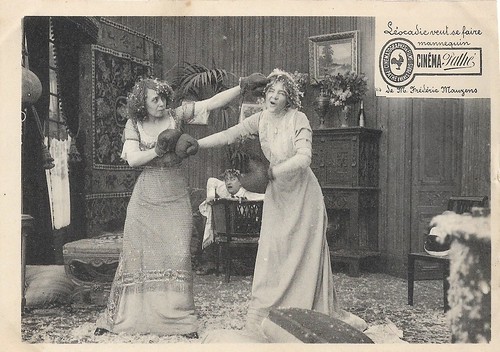
French collectors cards by Pathé Frères, 1911. Photo: SCAGL / Pathé Frères. Mistinguett and Juliette Clarens in Léocadie veut se faire mannequin (Frédéric Mauzens, 1911).
Léontine
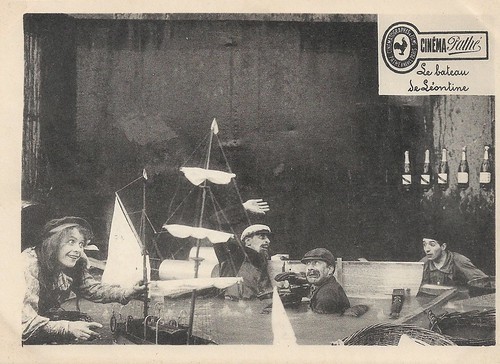
French collectors cards by Pathé Frères, 1911. Photo: SCAGL / Pathé Frères. Scene from Le bateau de Léontine (1911).
The Pathé series about Léontine, a girl always into terrible mischief, is typical 'Nasty women' stuff. In the short comedy Le bateau de Léontine/Betty's Boat (?, 1911), 'Titine' has received a superb three-master for her party. She has promised her parents to be very good in their absence, but she cannot resist the temptation to have her boat sailing.
She turns the kitchen faucets wide-open, so the room serves as a pool to her exploits. Soon the ship is sailing in the 'open sea', but Titine is still dissatisfied. However, the water, crossing the floor, flows in large streams onto the lower floors, drowning the tenants, and transforming the stairs in impassable torrents.
Titine, unsuspecting the dramas that take place below her, quietly floats in a barrel amidst the disaster. It is still unclear which actress played Leontine in this series.
Rosalie
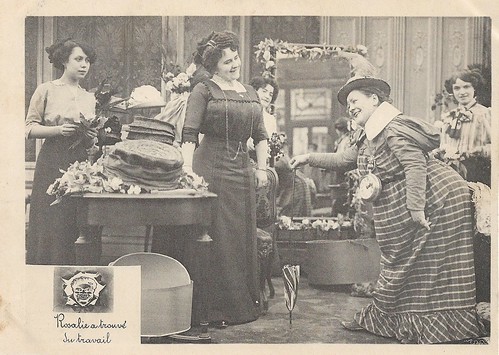
French collector's cards by Pathé Frères, 1911. Photo: Pathé Comica. Sarah Duhamel as Rosalie in Rosalie a trouvé du travail (Romeo Bosetti, 1911).
Rosalie is hired as worker at a fashion shop in Rosalie a trouvé du travail (Romeo Bosetti, 1911). She has to promise to be at work always at 7 sharp, but the next morning she awakes at 10 to 7, shoots out of bed, dresses in haste, jumps down the stairs, and crosses the obstacles like a tornado.
After a dishevelled run full of wild episodes, Rosalie arrives, red-headed and muddy, scarred with snags, at the fashion shop, only to read the sign on the closed front door, 'closed on Sundays and holidays'.
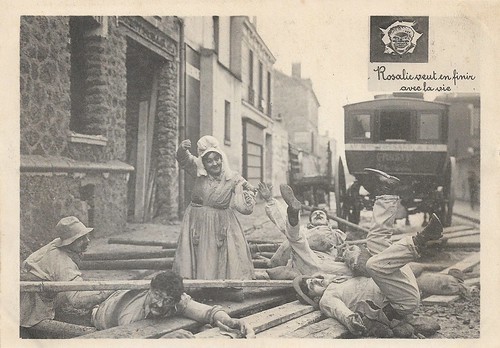
French collector's cards by Pathé Frères, 1911. Photo: Pathé Comica. Sarah Duhamel as Rosalie in Rosalie veut en finir avec la vie (1911).
In Rosalie veut en finir avec la vie/Rosalie wants to finish life (Romeo Bosetti, 1911), Rosalie is fired, so she wants to commit suicide. She shoots herself with a revolver but only destroys the mirror. She throws herself on the tramway rails, but, alas, this one takes another track. She throws herself from a parapet but in vain.
Desperate, she goes into a gun shop, throws a bomb and mounts to heaven. But is only to cause her to descend again, this time in the arms of a well-moustached police officer, so gets lust for life again. The film was released in March 1911.
Sources: Fondation Jerome Seydoux (French) and IMDb.
Léocadie

French collectors cards by Pathé Frères, 1911. Photo: SCAGL / Pathé Frères. Mistinguett and Juliette Clarens in Léocadie veut se faire mannequin (Frédéric Mauzens, 1911).
Léocadie veut se faire mannequin/Leocadia Wishes to Be Fashion-model came out in August 1911. It was directed and scripted by Frédéric Mauzens. Uncle Dufond wants to marry his nephew Onésime to a charming widow, Boxing Clorinde (Juliette Clarens). But Onésime, prey to a fatal love, formally repels the offer of his uncle who threatens to cut off his food and ruthlessly chases away his girlfriend, the young Léocadie ( Mistinguett ).
Léocadie soon finds a job as a model and has just started in her new job, when the boy of her janitor comes to warn that Onésime is drowning in his tub, out of despair. Listening only to her heart, Leocadie flies to his aid without worrying about the elegant dress she wears, which is precisely the one the rich Boxing Clorinde has selected.
The fashion designer, the client, and the model are all at Léocadie's, where Onésime, recalled to life by their good care, escapes only with difficulty to the fury of the two rivals. In the end, Léocadie, who triumphs as mistress of the battlefield, chases the importune uncle and his dangerous protegee.

French collectors cards by Pathé Frères, 1911. Photo: SCAGL / Pathé Frères. Mistinguett and Juliette Clarens in Léocadie veut se faire mannequin (Frédéric Mauzens, 1911).
Léontine

French collectors cards by Pathé Frères, 1911. Photo: SCAGL / Pathé Frères. Scene from Le bateau de Léontine (1911).
The Pathé series about Léontine, a girl always into terrible mischief, is typical 'Nasty women' stuff. In the short comedy Le bateau de Léontine/Betty's Boat (?, 1911), 'Titine' has received a superb three-master for her party. She has promised her parents to be very good in their absence, but she cannot resist the temptation to have her boat sailing.
She turns the kitchen faucets wide-open, so the room serves as a pool to her exploits. Soon the ship is sailing in the 'open sea', but Titine is still dissatisfied. However, the water, crossing the floor, flows in large streams onto the lower floors, drowning the tenants, and transforming the stairs in impassable torrents.
Titine, unsuspecting the dramas that take place below her, quietly floats in a barrel amidst the disaster. It is still unclear which actress played Leontine in this series.
Rosalie

French collector's cards by Pathé Frères, 1911. Photo: Pathé Comica. Sarah Duhamel as Rosalie in Rosalie a trouvé du travail (Romeo Bosetti, 1911).
Rosalie is hired as worker at a fashion shop in Rosalie a trouvé du travail (Romeo Bosetti, 1911). She has to promise to be at work always at 7 sharp, but the next morning she awakes at 10 to 7, shoots out of bed, dresses in haste, jumps down the stairs, and crosses the obstacles like a tornado.
After a dishevelled run full of wild episodes, Rosalie arrives, red-headed and muddy, scarred with snags, at the fashion shop, only to read the sign on the closed front door, 'closed on Sundays and holidays'.

French collector's cards by Pathé Frères, 1911. Photo: Pathé Comica. Sarah Duhamel as Rosalie in Rosalie veut en finir avec la vie (1911).
In Rosalie veut en finir avec la vie/Rosalie wants to finish life (Romeo Bosetti, 1911), Rosalie is fired, so she wants to commit suicide. She shoots herself with a revolver but only destroys the mirror. She throws herself on the tramway rails, but, alas, this one takes another track. She throws herself from a parapet but in vain.
Desperate, she goes into a gun shop, throws a bomb and mounts to heaven. But is only to cause her to descend again, this time in the arms of a well-moustached police officer, so gets lust for life again. The film was released in March 1911.
Sources: Fondation Jerome Seydoux (French) and IMDb.
Published on October 05, 2019 22:00
October 4, 2019
Jackie Coogan
Today, Le Giornate del Cinema Muto starts and EFSP will follow the festival from 5 till 12 October. The Silent Film Festival in Pordenone is the main festival in its kind and this year's edition is the 38th. The first film which will be screened at the Teatro Verdi, the main festival venue for film screenings, is The Kid (Charles Chaplin, 1921).
So EFSP starts with a post on Charlie Chaplin's irascible sidekick in the film, John Leslie 'Jackie' Coogan (1914-1984). As a child actor he also played the title role in Oliver Twist (Frank Lloyd, 1922) and several other silent films. Many years later, he became known as Uncle Fester in the TV series The Addams Family (1964-1966). In the interim, he sued his mother and stepfather over his squandered film earnings ($56 to $75 million adjusted for 2019 dollars) and provoked California to enact the first known legal protection for the earnings of child performers, widely known as 'the Coogan Act'.
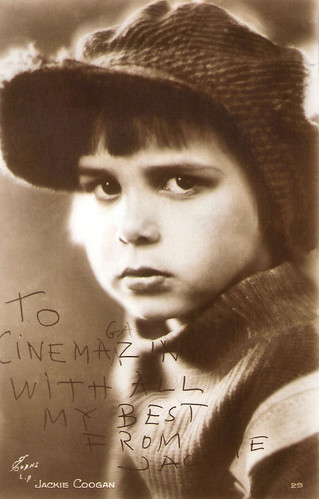
French postcard by Cinémagazine-Edition, no. 29. Photo: Evans, L.A.
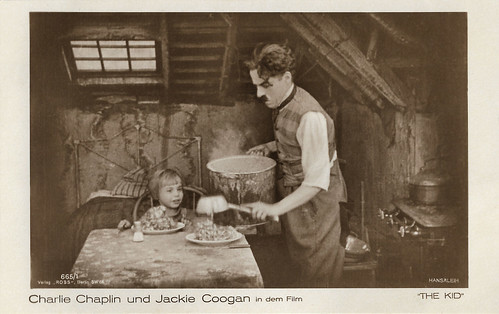
German postcard by Ross Verlag, no. 665/1. Photo: Hansaleih. Charlie Chaplin and Jackie Coogan in The Kid (Charles Chaplin, 1921).
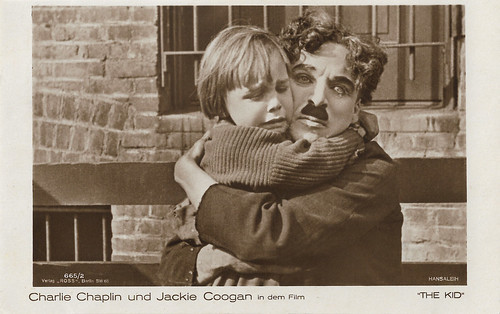
German postcard by Ross Verlag, no. 665/2. Photo: Hansaleih. Charlie Chaplin and Jackie Coogan in The Kid (Charles Chaplin, 1921).
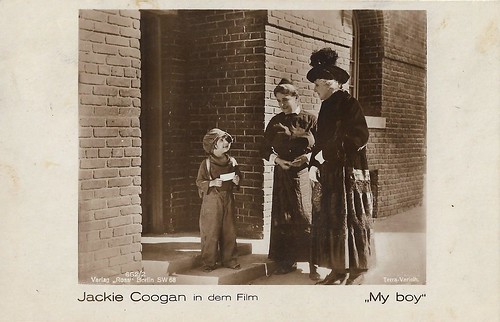
German postcard by Ross Verlag, no. 662/2. Photo: Terra-Verleih. Jackie Coogan in My Boy (Albert Austin, Victor Heerman, 1921). The wealthy lady is Mathilde Brundage, who plays the boy's grandmother.
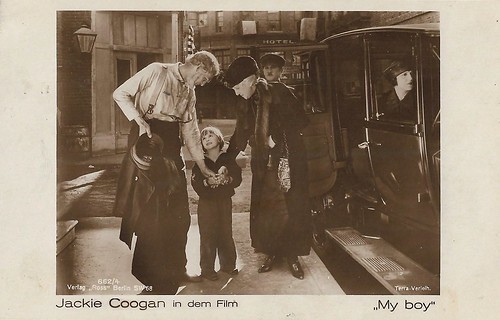
German postcard by Ross Verlag, no. 662/4. Photo: Terra-Verleih. Jackie Coogan and Mathilde Brundage in My Boy (Albert Austin, Victor Heerman, 1921). The old man is Claude Gillingwater, who plays Captain Bill.
The Kid
Jackie Coogan was born as John Leslie Coogan in 1914 in Los Angeles, California, to John Henry Coogan Jr. and Lillian Rita (Dolliver) Coogan. His father was a dancer and actor, and his mother had been a child star. Jackie's younger brother, Robert Coogan, also would become an actor.
His parents put Jackie on stage as part of their act when he was just 16 months old. His film debut was an uncredited role as a baby in the successful silent film Skinner's Baby (Harry Beaumont, 1917), starring Bryant Washburn.
Charlie Chaplin discovered him in the Orpheum Theatre, a vaudeville house in Los Angeles, on the stage doing the shimmy, a dance popular at the time.
Jackie Coogan was a natural mimic and delighted Chaplin with his abilities. Chaplin cast him in a small role in A Day's Pleasure (Charles Chaplin, 1919) to test Jackie. It proved that he had a screen presence.
Coogan then was the Tramp's irascible companion in The Kid (Charles Chaplin, 1921). Charlie raises the kid and then loses Jackie. The film was very successful.
The following year Jackie played the title role in Oliver Twist (1922), directed by Frank Lloyd. By 1923, when he made Daddy (E. Mason Hopper, 1923), he was one of the highest paid stars in Hollywood. He would leave First National for MGM where they put him into Long Live the King (Victor Schertzinger, 1923).
Coogan was one of the first stars to be heavily merchandised. Peanut butter, stationery, whistles, dolls, records, and figurines were among the Coogan-themed merchandise on sale.
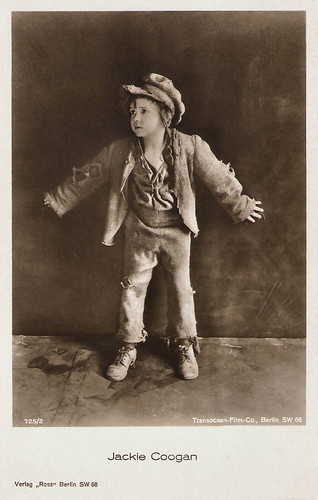
German postcard by Ross Verlag, no. 725/2, 1925-1926. Photo: Transocean-Film Co., Berlin. Jackie Coogan in Oliver Twist (Frank Lloyd, 1922).
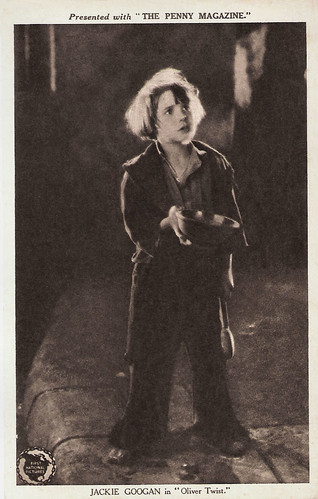
British postcard presented with The Penny Magazine. Photo: First National. Jackie Coogan in Oliver Twist (Frank Lloyd, 1922).
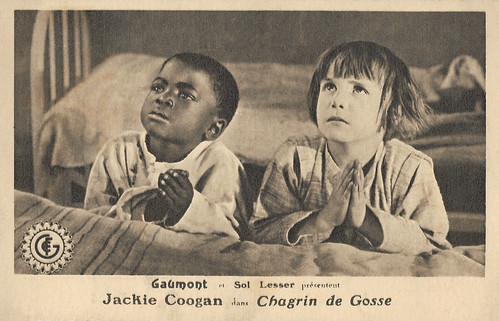
French postcard by Imp. Lison for Cinéma du Brun-Pain, 1923. Photo: Gaumont / Sol Lesser. Jackie Coogan in Trouble (Albert Austin, 1922).
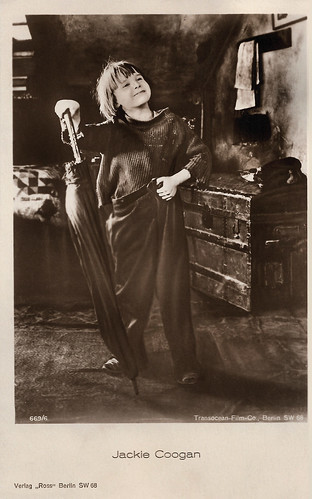
German postcard by Ross Verlag, no. 669/6. Photo: Transocean Film Co., Berlin. Jackie Coogan in Daddy (E. Mason Hopper, 1923). Postcard sent in the former Kingdom of Serbs, Croats, and Slovenes (Yugoslavia).
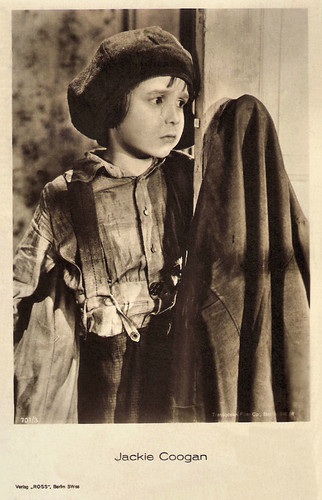
German postcard by Ross Verlag, Berlin, no. 701/3. Photo: Transocean-Film-Co., Berlin. Jackie Coogan in Daddy (E. Mason Hopper, 1923).
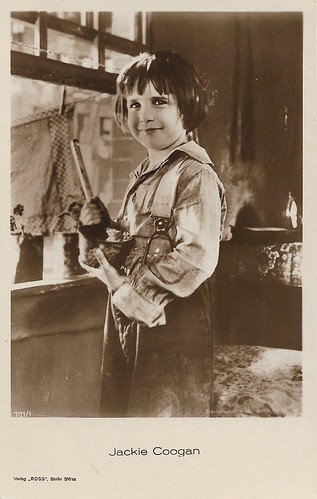
German postcard by Ross Verlag, no. 701/4. Photo: Transocean-Film-Co., Berlin. Jackie Coogan in Daddy (E. Mason Hopper, 1923).
A Children's Cruisade
The photo in Berlin above was taken during Coogan's European tour in 1924. According to Wikipedia , Coogan, working with Near East relief, toured across the United States and Europe in 1924 on a 'Children's Crusade' as part of his fundraising drive.
His fundraising provided more than $1 million in clothing, food, and other contributions for Armenian and Greek children displaced during World War I (worth $15 million in 2019 dollars).
He was honoured by officials in the United States, Greece, and Rome, where he had an audience with Pope Pius XI.
In addition, the tour promoted Coogan's film A Boy of Flanders, which, oddly enough, takes place in the Netherlands and not in Belgium (of which Flanders is a part). Coogan was also dressed up in typical Volendam (Dutch) folklorist outfit. In The Netherlands the film was therefore baptised 'Een Hollandsche jongen' (A Dutch Boy).
According to the newspapers, on September 1924 Coogan docked in Southampton and then visited London, Paris, Rome, and Athens. After ten days of holidays early October in Semmering (Austria), the trip continued to Budapest, Vienna, and Berlin.
Attempts to have him visit Amsterdam as well failed. After a return to Paris, he took the ship back to the US on 4 November, as he had to work from 28 October on the film sets again.
Coogan was tutored until the age of 10, when he entered Urban Military Academy and other prep schools. He attended several colleges, as well as the University of Southern California.
By 1927, at the age of 13, Coogan had grown up on the screen and his career was starting to go through a downturn. His popular film career would end with the classic tales of Tom Sawyer (John Cromwell, 1930) and Huckleberry Finn (Norman Taurog, 1931) with Junior Durkin. In 1932, he dropped out of Santa Clara University because of poor grades.
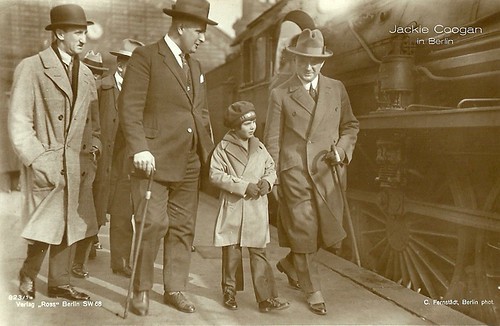
Jackie Coogan in Berlin. German postcard by Ross Verlag, Berlin, no. 923/1. Photo: C. Fernstädt, Berlin. The man at the far left is Coogan's father, John Henry Coogan Jr.
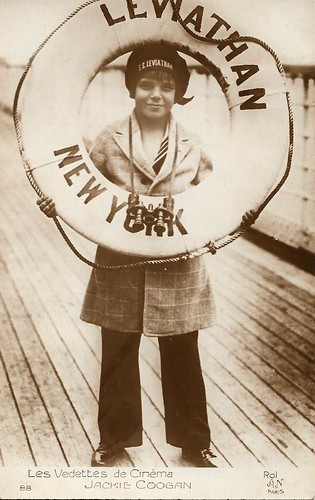
Jackie Coogan on board of SS Leviathan in 1924. French postcard by A.N. in the Les Vedettes de Cinéma series, Paris, no. 88. Photo: Rol. On 4 November 1924, Jackie Coogan went back to the US on the SS Leviathan, after his European tour of September-October that year, visiting London, Paris, Rome, Athens, Budapest, Vienna, and Berlin.
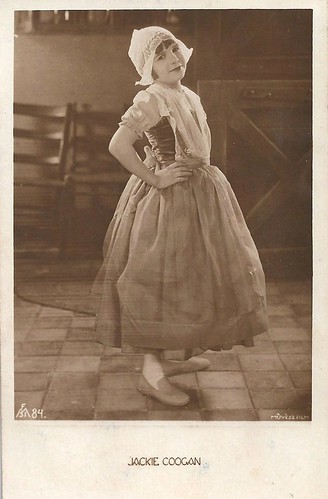
Hungarian postcard by FMSI, no. 84. Photo: Mûvèsz Film. In 1924 Coogan visited Budapest during his grand European tour. The photo refers to Coogan's outfit in A Boy of Flanders (Victor Schertzinger, 1924). Mûvèsz Film may have been the Hungarian distributor of that film.
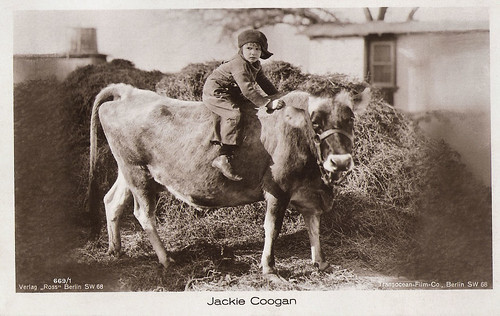
German postcard by Ross Verlag, no. 669/1, 1919-1924. Photo: Transocean-Film-Co., Berlin. Jackie Coogan in A Boy of Flanders (Victor Schertzinger, 1924).
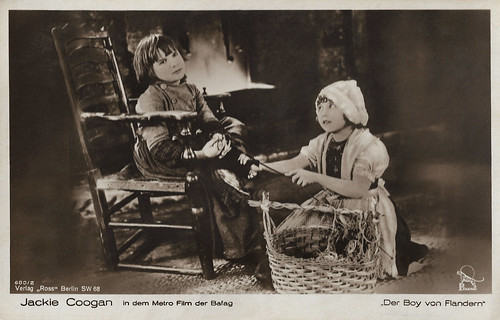
German postcard by Ross Verlag, no. 680/2, 1919-1924. Photo: Transocean-Film-Co., Berlin. Jackie Coogan in A Boy of Flanders (Victor Schertzinger, 1924).
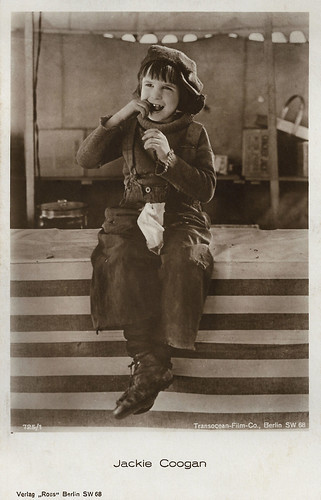
German postcard by Ross Verlag, no. 726/1, 1925-1926. Photo: Transocean-Film-Co., Berlin.
The Coogan ActIn 1935, 20-year-old Coogan was the sole survivor of a car crash in the California mountains. The accident killed his father; his best friend, 19-year-old actor Junior Durkin; their ranch foreman, Charles Jones; and actor and writer Robert J. Horner. The party was returning from a day of dove hunting over the border in Mexico in early May. With his father at the wheel, the car was forced off the mountain highway near Pine Valley by an oncoming vehicle and rolled down an embankment. Jackie would later call it the single saddest day of his life.
As a child star, Jackie Coogan earned an estimated $3 to $4 million (now $56 to $75 million). When he turned 21 in 1935, his fortune was believed to be well intact. His assets had been conservatively managed by his father, who had died in the car accident five months earlier.
However, Coogan found that the entire amount had been spent by his mother and stepfather, Arthur Bernstein, on fur coats, diamonds and other jewelry, and expensive cars. Bernstein had been a financial adviser for the family and married Coogan's mother in late 1936. Coogan's mother and stepfather claimed Jackie enjoyed himself and simply thought he was playing before the camera. She insisted, "No promises were ever made to give Jackie anything", and claimed he "was a bad boy".
Coogan sued them in 1938, but after his legal expenses, he received just $126,000 of the $250,000 remaining of his earnings.
Because of the public uproar, in 1939 the California Legislature passed the Child Actors Bill, also known as 'the Coogan Act', which would set up a trust fund for any child actor and protect his earnings. It required that a child actor's employer set aside 15% of the earnings in a trust (called a Coogan account), and specified the actor's schooling, work hours, and time off.
When Jackie Coogan fell on hard times and asked Charlie Chaplin for assistance, Chaplin handed him $1,000 without hesitating.
Although he eventually reconciled with his mother and stepfather after the lawsuit over his earnings, things were never the same, and his advice to future child stars was "stay away from mothers."
In 1938, Jackie Coogan appeared with then-wife Betty Grable in the musical comedy College Swing (Raoul Walsh, 1938) starring George Burns, Gracie Allen, Martha Raye and Bob Hope. It was followed by supporting roles in Million Dollar Legs (Nick Grinde, 1939) and Sky Patrol (Howard Bretherton, 1939).
In 1940, Coogan played the role of a playboy Broadway producer in the 'Society Girl' program on CBS radio. He also starred in his own radio programme, 'Forever Ernest' (1946), on CBS.
Coogan enlisted in the U.S. Army in March 1941. After the attack on Pearl Harbor that December, he requested a transfer to Army Air Forces as a glider pilot because of his civilian flying experience. Graduating the Advanced Glider School with the Glider Pilot aeronautical rating and the rank of Flight Officer, he volunteered for hazardous duty with the 1st Air Commando Group.
In December 1943, the unit was sent to India. He flew British troops, the Chindits, under General Orde Wingate on 5 March 1944, landing them at night in a small jungle clearing 100 miles (160 km) behind Japanese lines in the Burma Campaign.
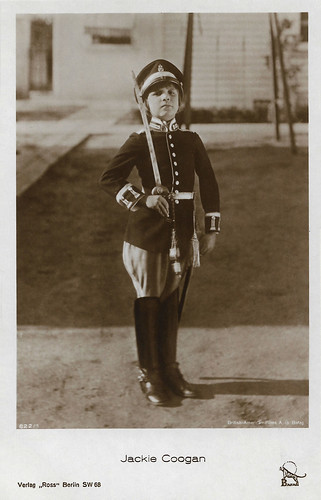
German postcard by Ross Verlag, Berlin, no. 822/1. Photo: British-American-Films A.-G. (Bafag). Jackie Coogan in Long Live the King (Victor Schertzinger, 1923).
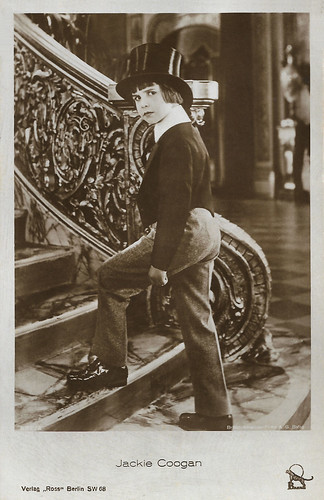
German postcard by Ross Verlag, Berlin, no. 822/2. Photo: British-American-Films A.-G. (Bafag). Jackie Coogan in Old Clothes (Edward F. Cline, 1925).
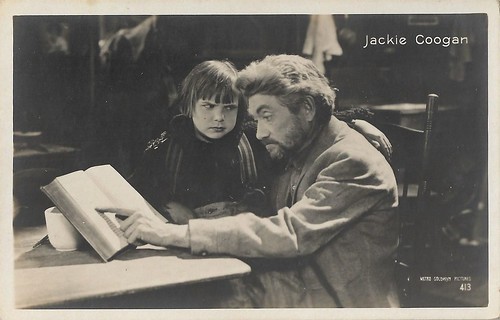
Italian postcard, no. 413. Photo: Metro Goldwyn Pictures. Jackie Coogan and Max Davidson in The Rag Man (Edward F. Cline, 1925).
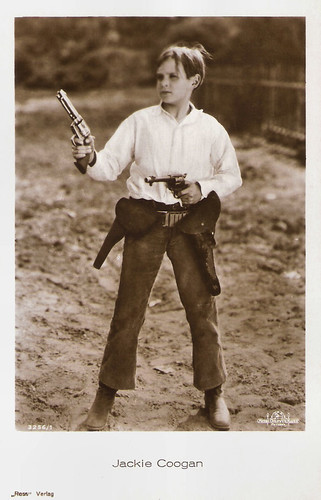
German postcard by Ross Verlag, no. 3256/1, 1928-1929. Photo: Metro-Goldwyn-Mayer.
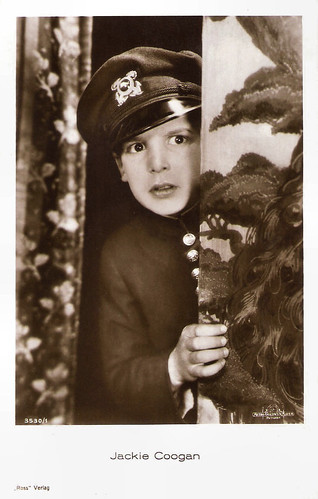
German postcard by Ross Verlag, no. 3530/1, 1928-1929. Photo: Metro-Goldwyn Mayer. Jackie Coogan in Buttons (George W. Hill, 1927).
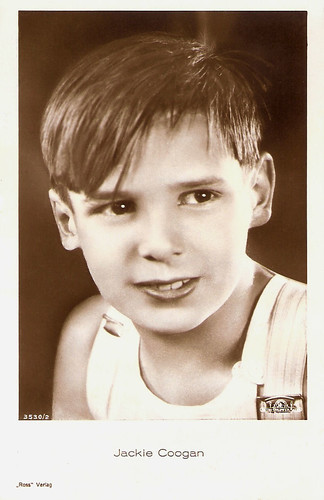
German postcard by Ross Verlag, no. 3530/2, 1928-1929. Photo: Metro-Goldwyn-Mayer.
Uncle Fester
After the war, Jackie Coogan returned to acting, but he was unable to restart his career. He worked in B-films, mostly in bit parts and usually playing the heavy.
During the 1950s, he started to appear on television. From 1952 to 1953, he played Stoney Crockett on the syndicated series Cowboy G-Men. In Denmark, he directed and starred in the thriller Flugten til Danmark/Escape from Terror (George Coogan, Jackie Coogan, 1955)
Coogan guest-starred on NBC's The Martha Raye Show. He appeared too, as Corbett, in two episodes of NBC's The Outlaws (1960-1962) with Barton MacLane. He had a regular role in the NBC series, McKeever and the Colonel (1962-1963).
Coogan finally found his most famous television role as Uncle Fester in ABC's The Addams Family (1964–1966). When he was cast as Uncle Fester, Coogan was 50 years old and nearly broke. After the series ended in 1966, he never lacked work again, with numerous television and film appearances.
In the cinema, Coogan appeared as a police officer in the Elvis Presley comedy Girl Happy (Boris Sagal, 1965) and in A Fine Madness (Irvin Kershner, 1966) with Sean Connery .
On TV, he appeared four times on Perry Mason (1966). He was a guest several times on The Red Skelton Show and appeared twice on The Brady Bunch. He also played as Jeannie's uncle, Suleiman – Maharajah of Basenji in I Dream of Jeannie (1969).
He continued to appear in TV series and feature films until his death. His final appearance was in the horror film The Prey (Edwin Brown, 1983).
Coogan was married four times, and had four children. His first three marriages to actresses were short-lived. He and Betty Grable were engaged in 1935 and married in 1937, and they divorced less than two years later in 1939. Eighteen months later in 1941, he married Flower Parry. They had one son, John Anthony Coogan in 1942. They divorced in 1943. Coogan married his third wife, Ann McCormack in 1946. They had a daughter, Joann Dolliver Coogan, born in 1948. They divorced in 1951.
Dorothea Odetta Hanson, also known as dancer Dorothea 'Dodie' Lamphere, became Coogan's fourth wife in 1952 and they were together over thirty years, until his death. She died in 1999. They had two children together, a daughter, Leslie Diane Coogan (1953) and a son, Christopher Fenton Coogan (1967), who died in a motorcycle accident in Palm Springs in 1990.
After suffering from heart and kidney ailments, Jackie Coogan succumbed to heart failure in 1984, at age 69, in Santa Monica, California. He had previously suffered several strokes and had been undergoing kidney dialysis when his blood pressure dropped. Coogan was taken to Santa Monica Hospital, where he died from cardiac arrest. He was buried at Holy Cross Cemetery in Culver City.
In 1972, Charles Chaplin returned to the U.S. after two decades of exile. He would receive the Handel Medallion in New York City and a special lifetime achievement Oscar in Hollywood. Coogan was one of several people to greet Chaplin when he arrived at Los Angeles International Airport. After greeting the other members of the party with perfunctory handshakes, Chaplin, recognised Coogan (whom he hadn't seen in decades), warmly embraced him, saying, "You know, I think I would rather see you than anybody else." Chaplin later told Coogan's wife, "You must never forget that your husband is a genius."
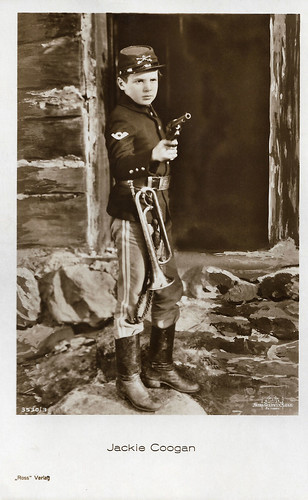
German postcard by Ross Verlag, no. 3530/3, 1928-1929. Photo: Metro-Goldwyn-Mayer. Jackie Coogan in The Bugle Call (Edward Sedgwick, 1927).
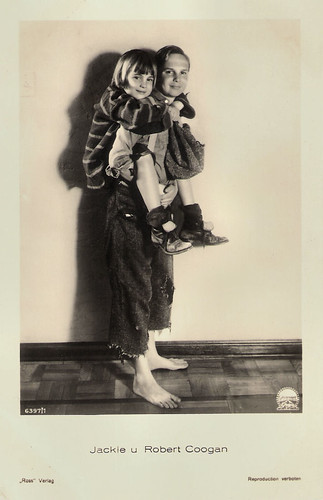
Jackie Coogan and his little brother Robert Coogan. German postcard by Ross Verlag, no. 6397/1, 1931-1932. Photo: Paramount.
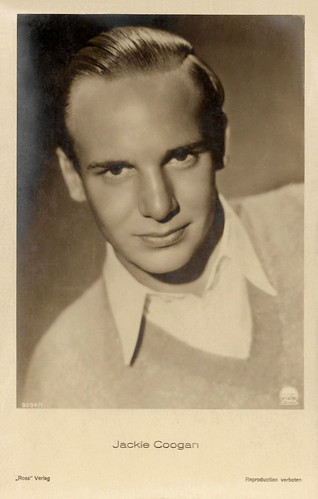
German postcard by Ross Verlag, no. 9594/1, 1935-1936. Photo: Paramount.
Sources: (IMDb), Wikipedia and .
So EFSP starts with a post on Charlie Chaplin's irascible sidekick in the film, John Leslie 'Jackie' Coogan (1914-1984). As a child actor he also played the title role in Oliver Twist (Frank Lloyd, 1922) and several other silent films. Many years later, he became known as Uncle Fester in the TV series The Addams Family (1964-1966). In the interim, he sued his mother and stepfather over his squandered film earnings ($56 to $75 million adjusted for 2019 dollars) and provoked California to enact the first known legal protection for the earnings of child performers, widely known as 'the Coogan Act'.

French postcard by Cinémagazine-Edition, no. 29. Photo: Evans, L.A.

German postcard by Ross Verlag, no. 665/1. Photo: Hansaleih. Charlie Chaplin and Jackie Coogan in The Kid (Charles Chaplin, 1921).

German postcard by Ross Verlag, no. 665/2. Photo: Hansaleih. Charlie Chaplin and Jackie Coogan in The Kid (Charles Chaplin, 1921).

German postcard by Ross Verlag, no. 662/2. Photo: Terra-Verleih. Jackie Coogan in My Boy (Albert Austin, Victor Heerman, 1921). The wealthy lady is Mathilde Brundage, who plays the boy's grandmother.

German postcard by Ross Verlag, no. 662/4. Photo: Terra-Verleih. Jackie Coogan and Mathilde Brundage in My Boy (Albert Austin, Victor Heerman, 1921). The old man is Claude Gillingwater, who plays Captain Bill.
The Kid
Jackie Coogan was born as John Leslie Coogan in 1914 in Los Angeles, California, to John Henry Coogan Jr. and Lillian Rita (Dolliver) Coogan. His father was a dancer and actor, and his mother had been a child star. Jackie's younger brother, Robert Coogan, also would become an actor.
His parents put Jackie on stage as part of their act when he was just 16 months old. His film debut was an uncredited role as a baby in the successful silent film Skinner's Baby (Harry Beaumont, 1917), starring Bryant Washburn.
Charlie Chaplin discovered him in the Orpheum Theatre, a vaudeville house in Los Angeles, on the stage doing the shimmy, a dance popular at the time.
Jackie Coogan was a natural mimic and delighted Chaplin with his abilities. Chaplin cast him in a small role in A Day's Pleasure (Charles Chaplin, 1919) to test Jackie. It proved that he had a screen presence.
Coogan then was the Tramp's irascible companion in The Kid (Charles Chaplin, 1921). Charlie raises the kid and then loses Jackie. The film was very successful.
The following year Jackie played the title role in Oliver Twist (1922), directed by Frank Lloyd. By 1923, when he made Daddy (E. Mason Hopper, 1923), he was one of the highest paid stars in Hollywood. He would leave First National for MGM where they put him into Long Live the King (Victor Schertzinger, 1923).
Coogan was one of the first stars to be heavily merchandised. Peanut butter, stationery, whistles, dolls, records, and figurines were among the Coogan-themed merchandise on sale.

German postcard by Ross Verlag, no. 725/2, 1925-1926. Photo: Transocean-Film Co., Berlin. Jackie Coogan in Oliver Twist (Frank Lloyd, 1922).

British postcard presented with The Penny Magazine. Photo: First National. Jackie Coogan in Oliver Twist (Frank Lloyd, 1922).

French postcard by Imp. Lison for Cinéma du Brun-Pain, 1923. Photo: Gaumont / Sol Lesser. Jackie Coogan in Trouble (Albert Austin, 1922).

German postcard by Ross Verlag, no. 669/6. Photo: Transocean Film Co., Berlin. Jackie Coogan in Daddy (E. Mason Hopper, 1923). Postcard sent in the former Kingdom of Serbs, Croats, and Slovenes (Yugoslavia).

German postcard by Ross Verlag, Berlin, no. 701/3. Photo: Transocean-Film-Co., Berlin. Jackie Coogan in Daddy (E. Mason Hopper, 1923).

German postcard by Ross Verlag, no. 701/4. Photo: Transocean-Film-Co., Berlin. Jackie Coogan in Daddy (E. Mason Hopper, 1923).
A Children's Cruisade
The photo in Berlin above was taken during Coogan's European tour in 1924. According to Wikipedia , Coogan, working with Near East relief, toured across the United States and Europe in 1924 on a 'Children's Crusade' as part of his fundraising drive.
His fundraising provided more than $1 million in clothing, food, and other contributions for Armenian and Greek children displaced during World War I (worth $15 million in 2019 dollars).
He was honoured by officials in the United States, Greece, and Rome, where he had an audience with Pope Pius XI.
In addition, the tour promoted Coogan's film A Boy of Flanders, which, oddly enough, takes place in the Netherlands and not in Belgium (of which Flanders is a part). Coogan was also dressed up in typical Volendam (Dutch) folklorist outfit. In The Netherlands the film was therefore baptised 'Een Hollandsche jongen' (A Dutch Boy).
According to the newspapers, on September 1924 Coogan docked in Southampton and then visited London, Paris, Rome, and Athens. After ten days of holidays early October in Semmering (Austria), the trip continued to Budapest, Vienna, and Berlin.
Attempts to have him visit Amsterdam as well failed. After a return to Paris, he took the ship back to the US on 4 November, as he had to work from 28 October on the film sets again.
Coogan was tutored until the age of 10, when he entered Urban Military Academy and other prep schools. He attended several colleges, as well as the University of Southern California.
By 1927, at the age of 13, Coogan had grown up on the screen and his career was starting to go through a downturn. His popular film career would end with the classic tales of Tom Sawyer (John Cromwell, 1930) and Huckleberry Finn (Norman Taurog, 1931) with Junior Durkin. In 1932, he dropped out of Santa Clara University because of poor grades.

Jackie Coogan in Berlin. German postcard by Ross Verlag, Berlin, no. 923/1. Photo: C. Fernstädt, Berlin. The man at the far left is Coogan's father, John Henry Coogan Jr.

Jackie Coogan on board of SS Leviathan in 1924. French postcard by A.N. in the Les Vedettes de Cinéma series, Paris, no. 88. Photo: Rol. On 4 November 1924, Jackie Coogan went back to the US on the SS Leviathan, after his European tour of September-October that year, visiting London, Paris, Rome, Athens, Budapest, Vienna, and Berlin.

Hungarian postcard by FMSI, no. 84. Photo: Mûvèsz Film. In 1924 Coogan visited Budapest during his grand European tour. The photo refers to Coogan's outfit in A Boy of Flanders (Victor Schertzinger, 1924). Mûvèsz Film may have been the Hungarian distributor of that film.

German postcard by Ross Verlag, no. 669/1, 1919-1924. Photo: Transocean-Film-Co., Berlin. Jackie Coogan in A Boy of Flanders (Victor Schertzinger, 1924).

German postcard by Ross Verlag, no. 680/2, 1919-1924. Photo: Transocean-Film-Co., Berlin. Jackie Coogan in A Boy of Flanders (Victor Schertzinger, 1924).

German postcard by Ross Verlag, no. 726/1, 1925-1926. Photo: Transocean-Film-Co., Berlin.
The Coogan ActIn 1935, 20-year-old Coogan was the sole survivor of a car crash in the California mountains. The accident killed his father; his best friend, 19-year-old actor Junior Durkin; their ranch foreman, Charles Jones; and actor and writer Robert J. Horner. The party was returning from a day of dove hunting over the border in Mexico in early May. With his father at the wheel, the car was forced off the mountain highway near Pine Valley by an oncoming vehicle and rolled down an embankment. Jackie would later call it the single saddest day of his life.
As a child star, Jackie Coogan earned an estimated $3 to $4 million (now $56 to $75 million). When he turned 21 in 1935, his fortune was believed to be well intact. His assets had been conservatively managed by his father, who had died in the car accident five months earlier.
However, Coogan found that the entire amount had been spent by his mother and stepfather, Arthur Bernstein, on fur coats, diamonds and other jewelry, and expensive cars. Bernstein had been a financial adviser for the family and married Coogan's mother in late 1936. Coogan's mother and stepfather claimed Jackie enjoyed himself and simply thought he was playing before the camera. She insisted, "No promises were ever made to give Jackie anything", and claimed he "was a bad boy".
Coogan sued them in 1938, but after his legal expenses, he received just $126,000 of the $250,000 remaining of his earnings.
Because of the public uproar, in 1939 the California Legislature passed the Child Actors Bill, also known as 'the Coogan Act', which would set up a trust fund for any child actor and protect his earnings. It required that a child actor's employer set aside 15% of the earnings in a trust (called a Coogan account), and specified the actor's schooling, work hours, and time off.
When Jackie Coogan fell on hard times and asked Charlie Chaplin for assistance, Chaplin handed him $1,000 without hesitating.
Although he eventually reconciled with his mother and stepfather after the lawsuit over his earnings, things were never the same, and his advice to future child stars was "stay away from mothers."
In 1938, Jackie Coogan appeared with then-wife Betty Grable in the musical comedy College Swing (Raoul Walsh, 1938) starring George Burns, Gracie Allen, Martha Raye and Bob Hope. It was followed by supporting roles in Million Dollar Legs (Nick Grinde, 1939) and Sky Patrol (Howard Bretherton, 1939).
In 1940, Coogan played the role of a playboy Broadway producer in the 'Society Girl' program on CBS radio. He also starred in his own radio programme, 'Forever Ernest' (1946), on CBS.
Coogan enlisted in the U.S. Army in March 1941. After the attack on Pearl Harbor that December, he requested a transfer to Army Air Forces as a glider pilot because of his civilian flying experience. Graduating the Advanced Glider School with the Glider Pilot aeronautical rating and the rank of Flight Officer, he volunteered for hazardous duty with the 1st Air Commando Group.
In December 1943, the unit was sent to India. He flew British troops, the Chindits, under General Orde Wingate on 5 March 1944, landing them at night in a small jungle clearing 100 miles (160 km) behind Japanese lines in the Burma Campaign.

German postcard by Ross Verlag, Berlin, no. 822/1. Photo: British-American-Films A.-G. (Bafag). Jackie Coogan in Long Live the King (Victor Schertzinger, 1923).

German postcard by Ross Verlag, Berlin, no. 822/2. Photo: British-American-Films A.-G. (Bafag). Jackie Coogan in Old Clothes (Edward F. Cline, 1925).

Italian postcard, no. 413. Photo: Metro Goldwyn Pictures. Jackie Coogan and Max Davidson in The Rag Man (Edward F. Cline, 1925).

German postcard by Ross Verlag, no. 3256/1, 1928-1929. Photo: Metro-Goldwyn-Mayer.

German postcard by Ross Verlag, no. 3530/1, 1928-1929. Photo: Metro-Goldwyn Mayer. Jackie Coogan in Buttons (George W. Hill, 1927).

German postcard by Ross Verlag, no. 3530/2, 1928-1929. Photo: Metro-Goldwyn-Mayer.
Uncle Fester
After the war, Jackie Coogan returned to acting, but he was unable to restart his career. He worked in B-films, mostly in bit parts and usually playing the heavy.
During the 1950s, he started to appear on television. From 1952 to 1953, he played Stoney Crockett on the syndicated series Cowboy G-Men. In Denmark, he directed and starred in the thriller Flugten til Danmark/Escape from Terror (George Coogan, Jackie Coogan, 1955)
Coogan guest-starred on NBC's The Martha Raye Show. He appeared too, as Corbett, in two episodes of NBC's The Outlaws (1960-1962) with Barton MacLane. He had a regular role in the NBC series, McKeever and the Colonel (1962-1963).
Coogan finally found his most famous television role as Uncle Fester in ABC's The Addams Family (1964–1966). When he was cast as Uncle Fester, Coogan was 50 years old and nearly broke. After the series ended in 1966, he never lacked work again, with numerous television and film appearances.
In the cinema, Coogan appeared as a police officer in the Elvis Presley comedy Girl Happy (Boris Sagal, 1965) and in A Fine Madness (Irvin Kershner, 1966) with Sean Connery .
On TV, he appeared four times on Perry Mason (1966). He was a guest several times on The Red Skelton Show and appeared twice on The Brady Bunch. He also played as Jeannie's uncle, Suleiman – Maharajah of Basenji in I Dream of Jeannie (1969).
He continued to appear in TV series and feature films until his death. His final appearance was in the horror film The Prey (Edwin Brown, 1983).
Coogan was married four times, and had four children. His first three marriages to actresses were short-lived. He and Betty Grable were engaged in 1935 and married in 1937, and they divorced less than two years later in 1939. Eighteen months later in 1941, he married Flower Parry. They had one son, John Anthony Coogan in 1942. They divorced in 1943. Coogan married his third wife, Ann McCormack in 1946. They had a daughter, Joann Dolliver Coogan, born in 1948. They divorced in 1951.
Dorothea Odetta Hanson, also known as dancer Dorothea 'Dodie' Lamphere, became Coogan's fourth wife in 1952 and they were together over thirty years, until his death. She died in 1999. They had two children together, a daughter, Leslie Diane Coogan (1953) and a son, Christopher Fenton Coogan (1967), who died in a motorcycle accident in Palm Springs in 1990.
After suffering from heart and kidney ailments, Jackie Coogan succumbed to heart failure in 1984, at age 69, in Santa Monica, California. He had previously suffered several strokes and had been undergoing kidney dialysis when his blood pressure dropped. Coogan was taken to Santa Monica Hospital, where he died from cardiac arrest. He was buried at Holy Cross Cemetery in Culver City.
In 1972, Charles Chaplin returned to the U.S. after two decades of exile. He would receive the Handel Medallion in New York City and a special lifetime achievement Oscar in Hollywood. Coogan was one of several people to greet Chaplin when he arrived at Los Angeles International Airport. After greeting the other members of the party with perfunctory handshakes, Chaplin, recognised Coogan (whom he hadn't seen in decades), warmly embraced him, saying, "You know, I think I would rather see you than anybody else." Chaplin later told Coogan's wife, "You must never forget that your husband is a genius."

German postcard by Ross Verlag, no. 3530/3, 1928-1929. Photo: Metro-Goldwyn-Mayer. Jackie Coogan in The Bugle Call (Edward Sedgwick, 1927).

Jackie Coogan and his little brother Robert Coogan. German postcard by Ross Verlag, no. 6397/1, 1931-1932. Photo: Paramount.

German postcard by Ross Verlag, no. 9594/1, 1935-1936. Photo: Paramount.
Sources: (IMDb), Wikipedia and .
Published on October 04, 2019 22:00
Paul van Yperen's Blog
- Paul van Yperen's profile
- 13 followers
Paul van Yperen isn't a Goodreads Author
(yet),
but they
do have a blog,
so here are some recent posts imported from
their feed.



